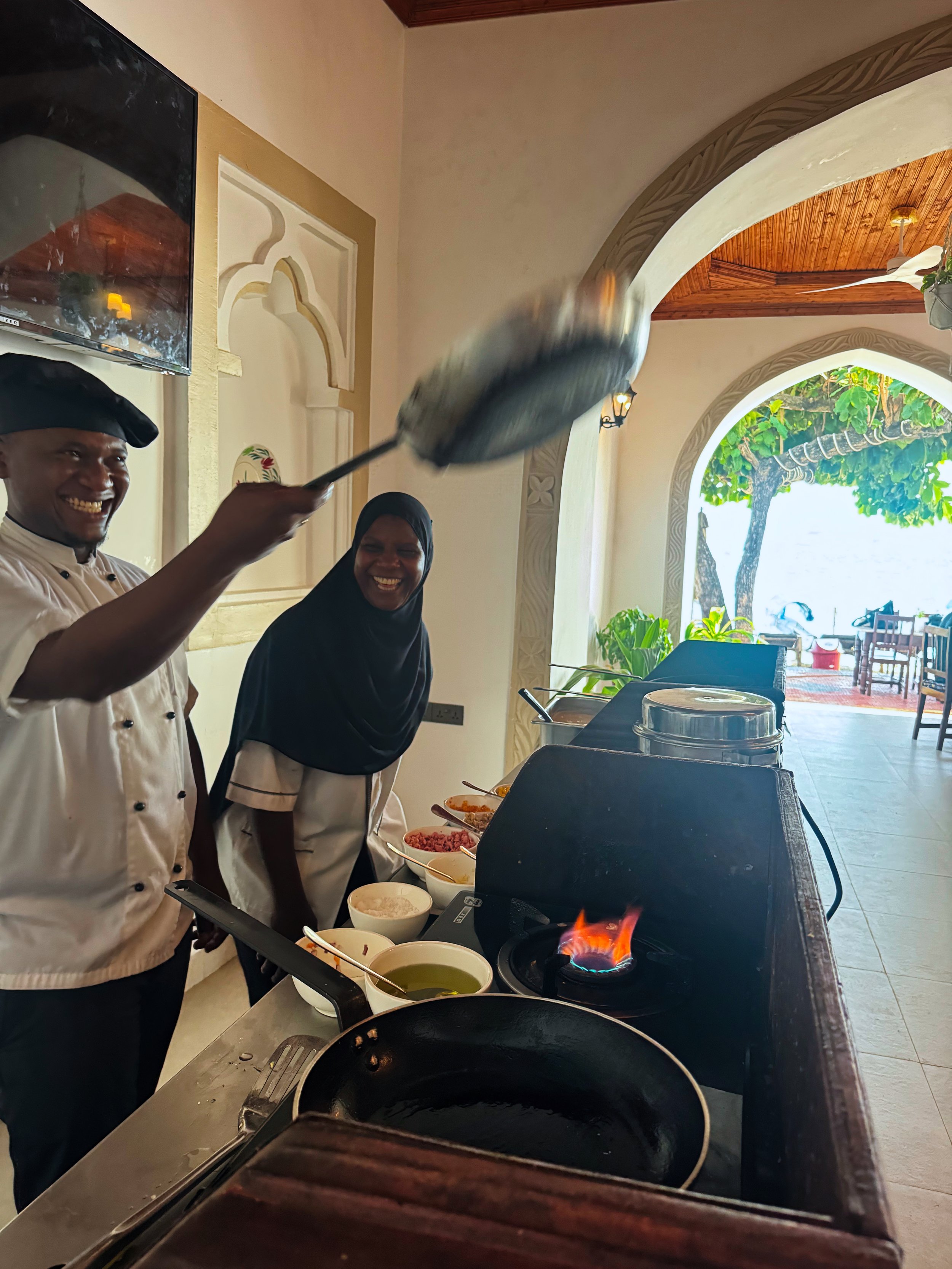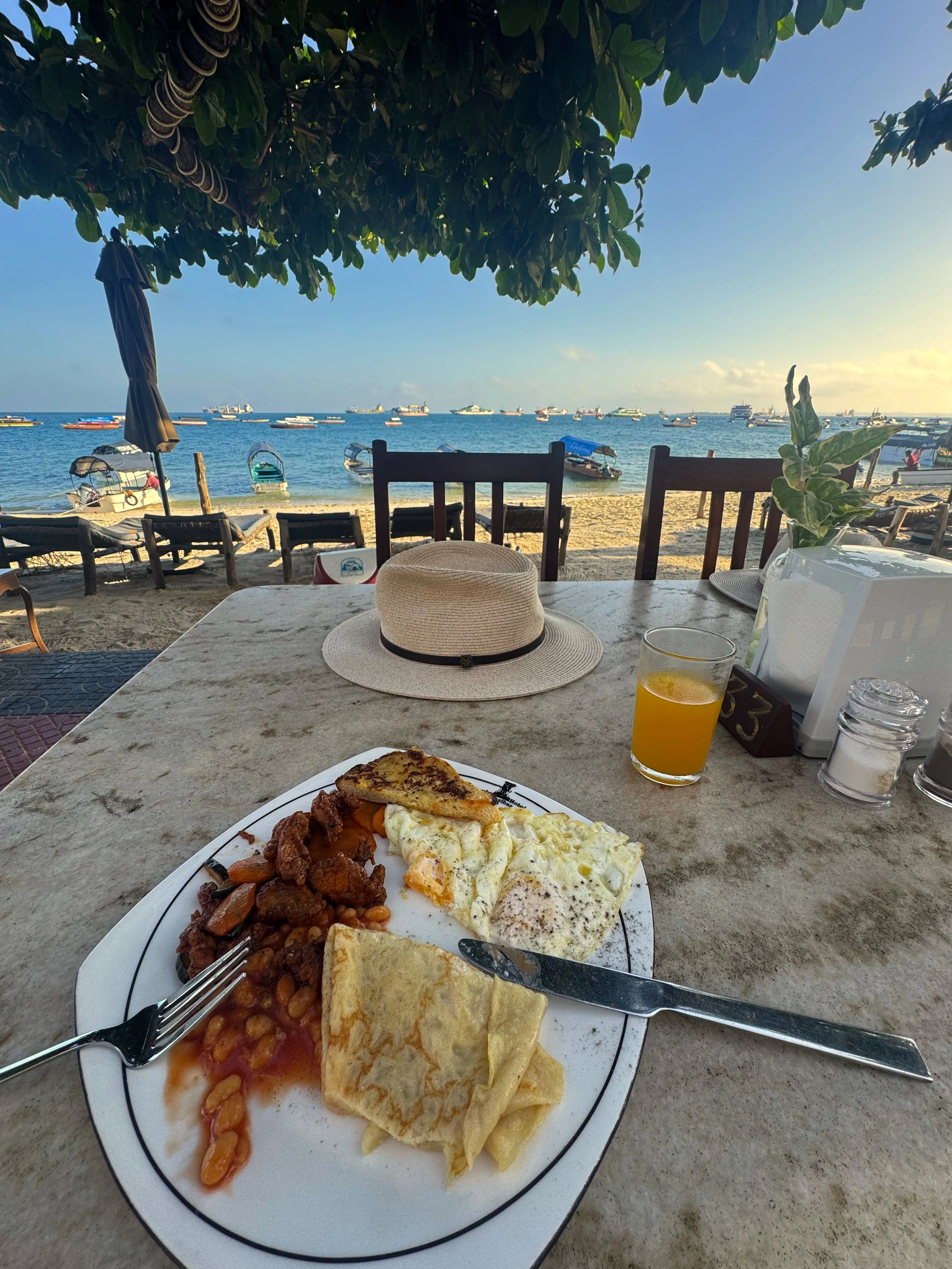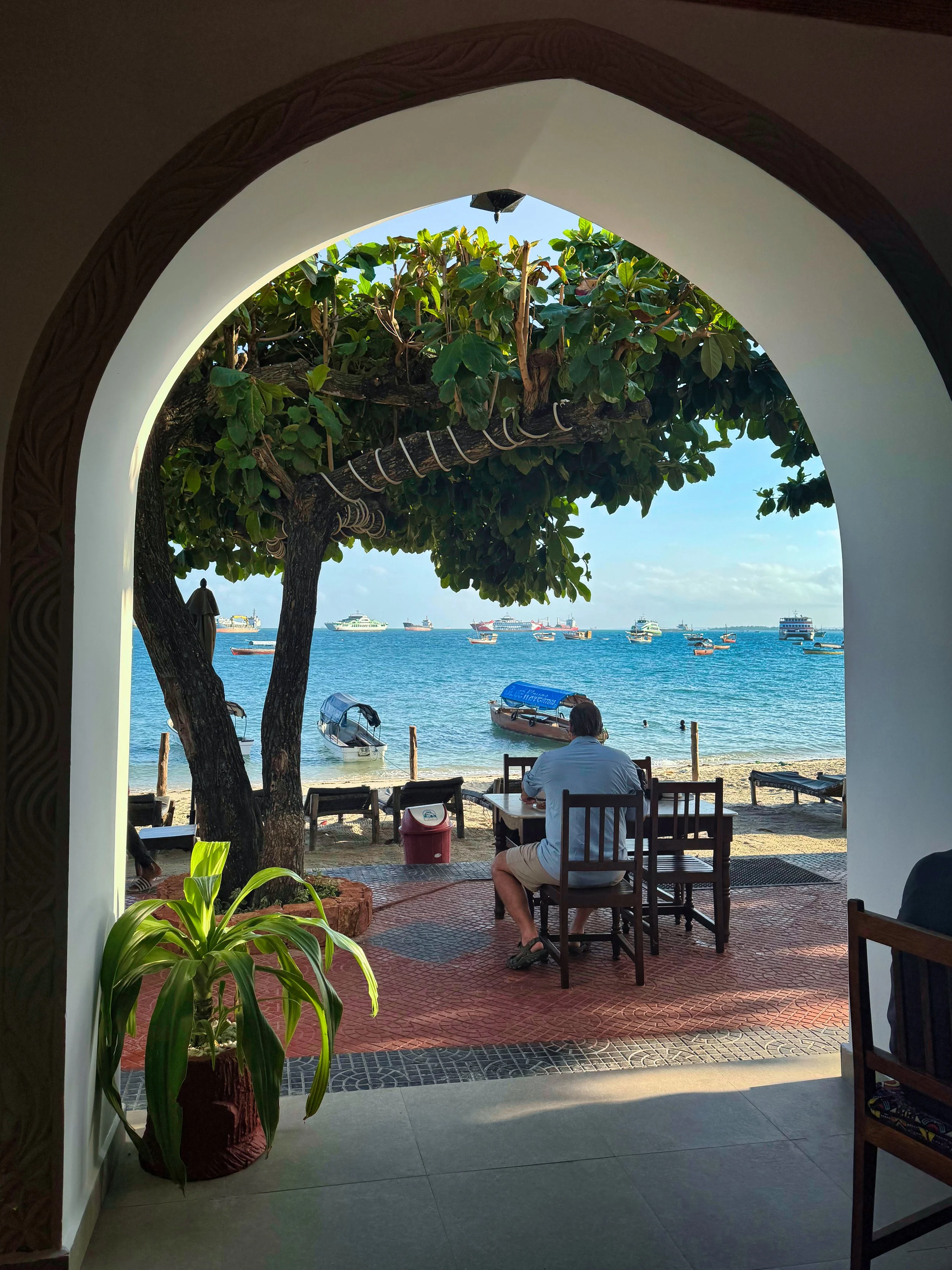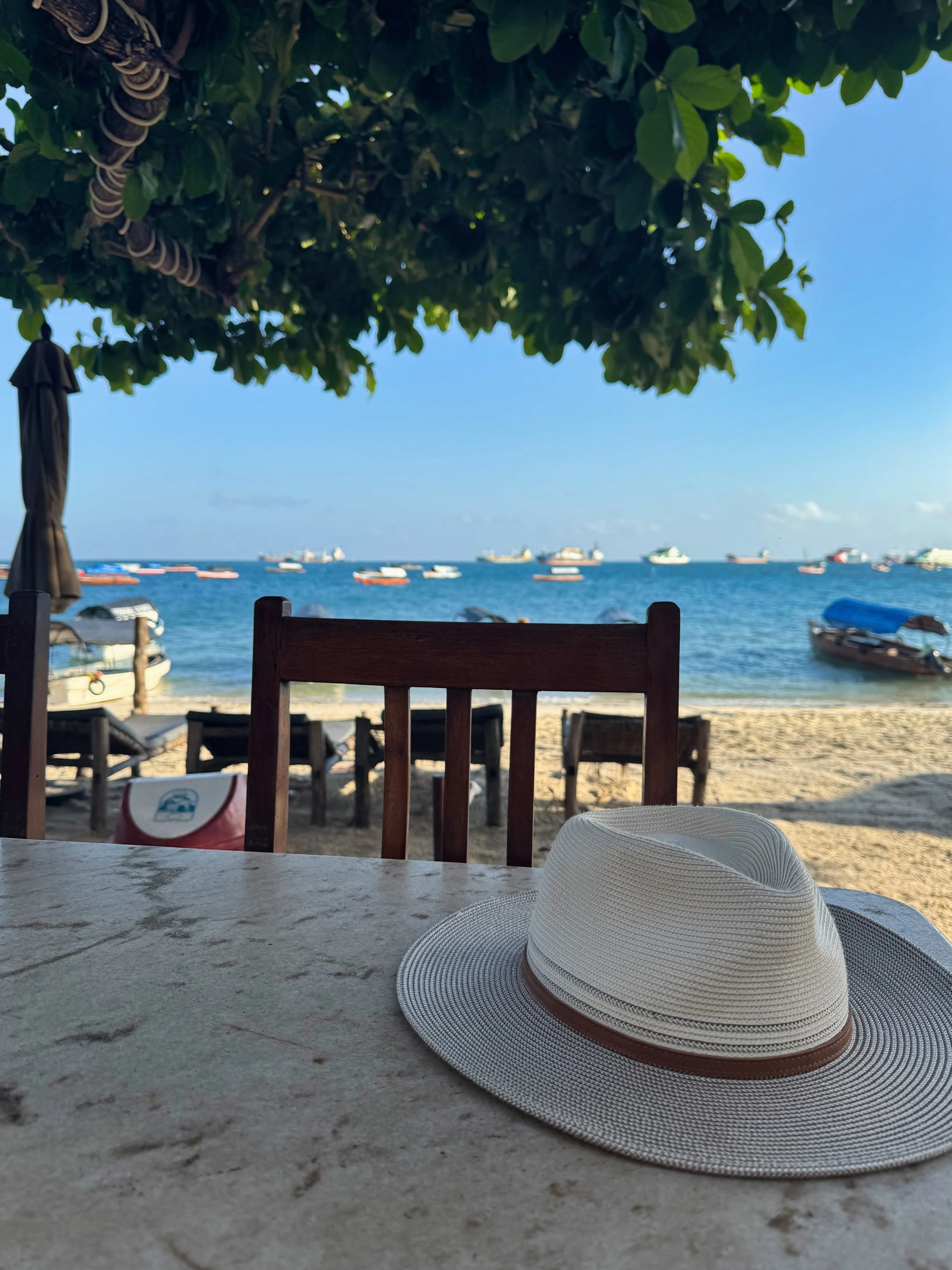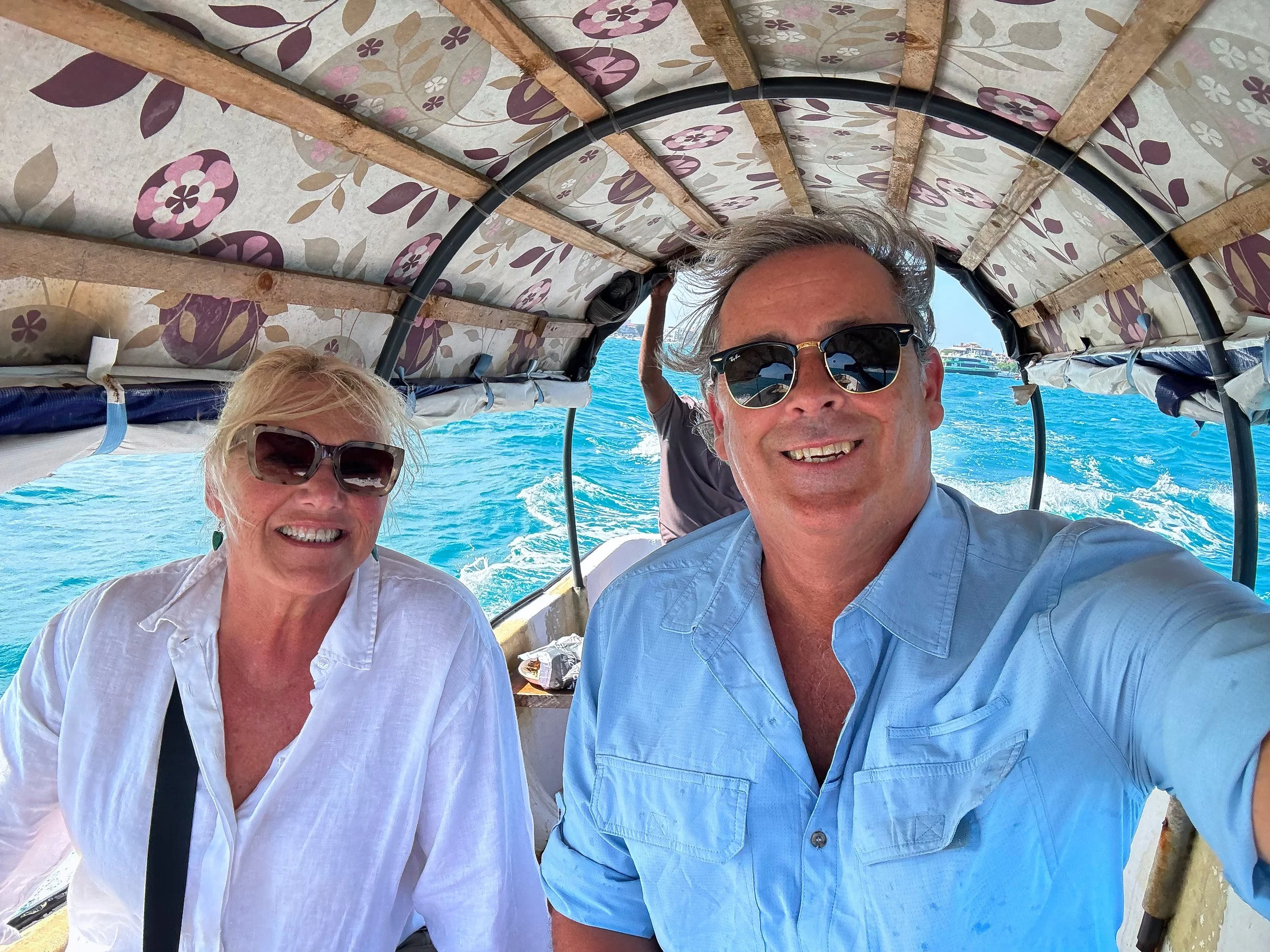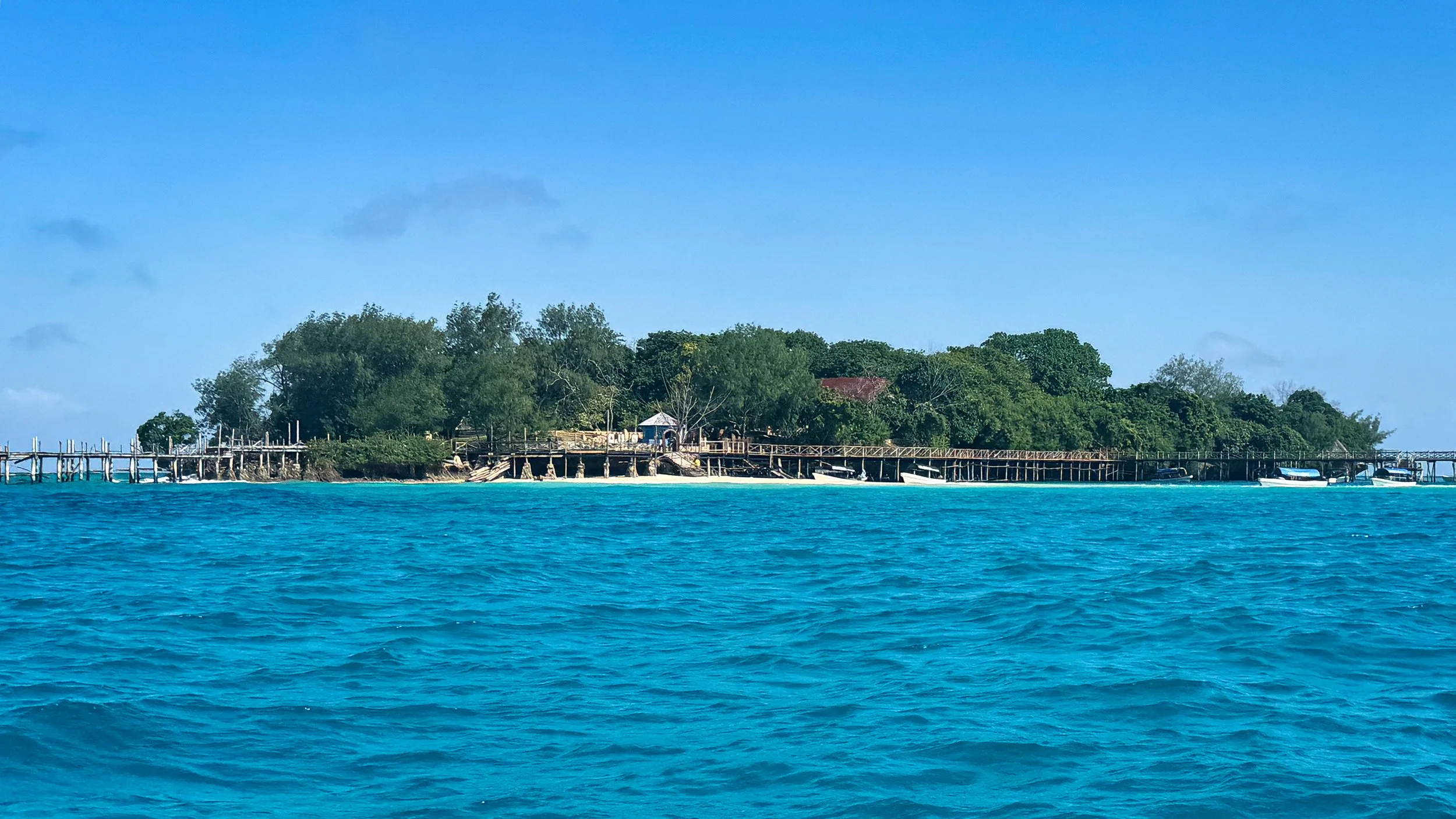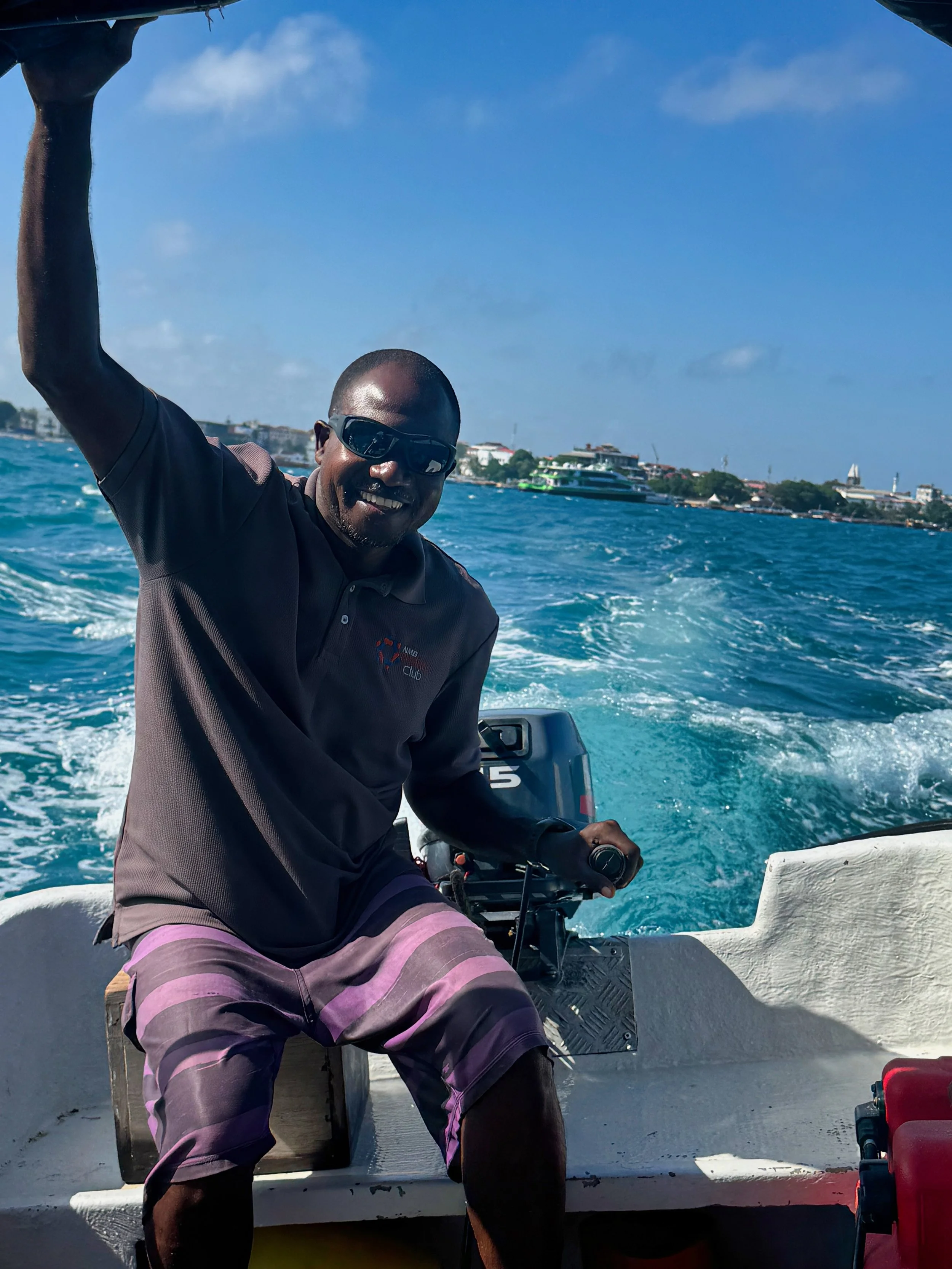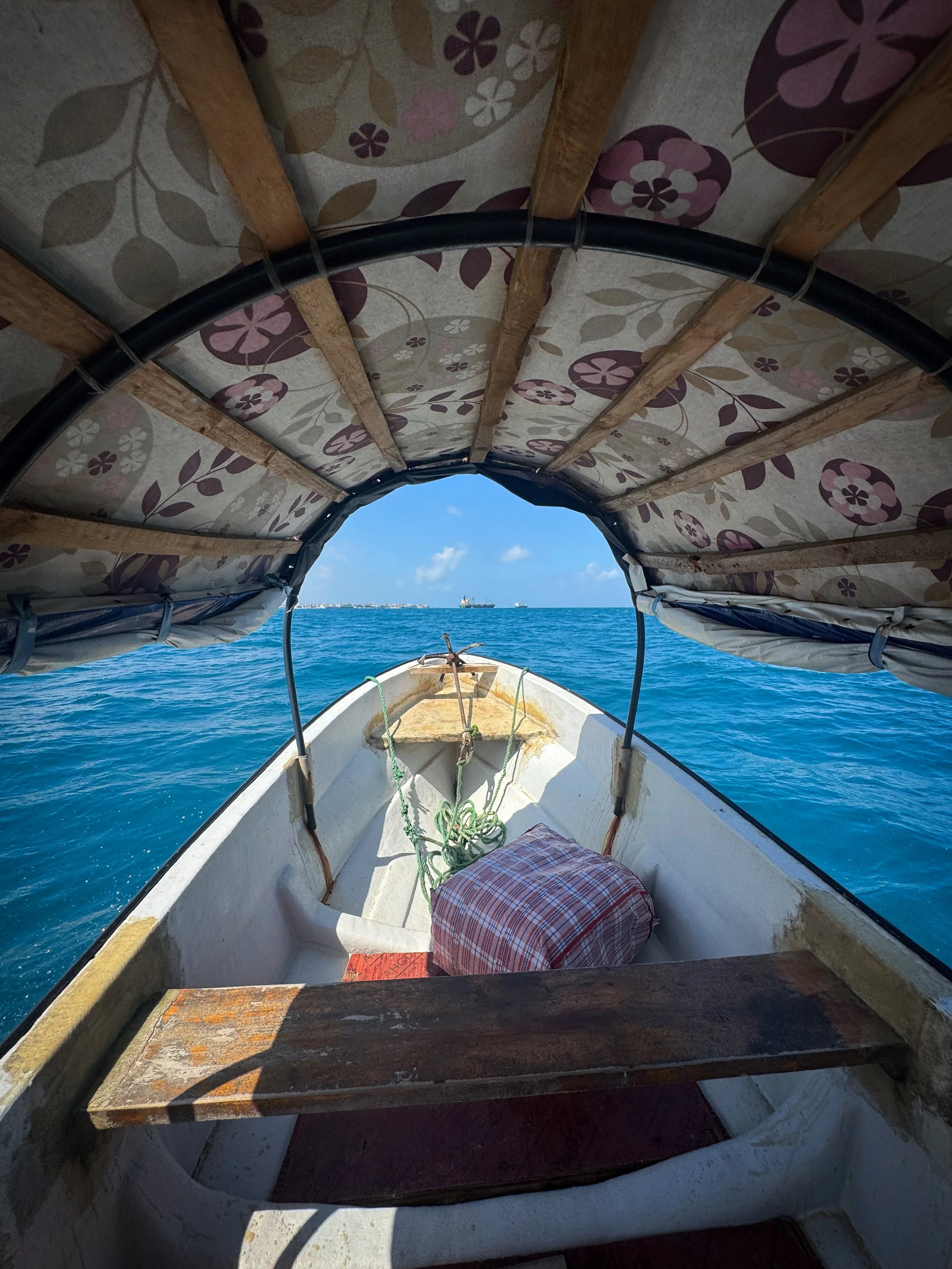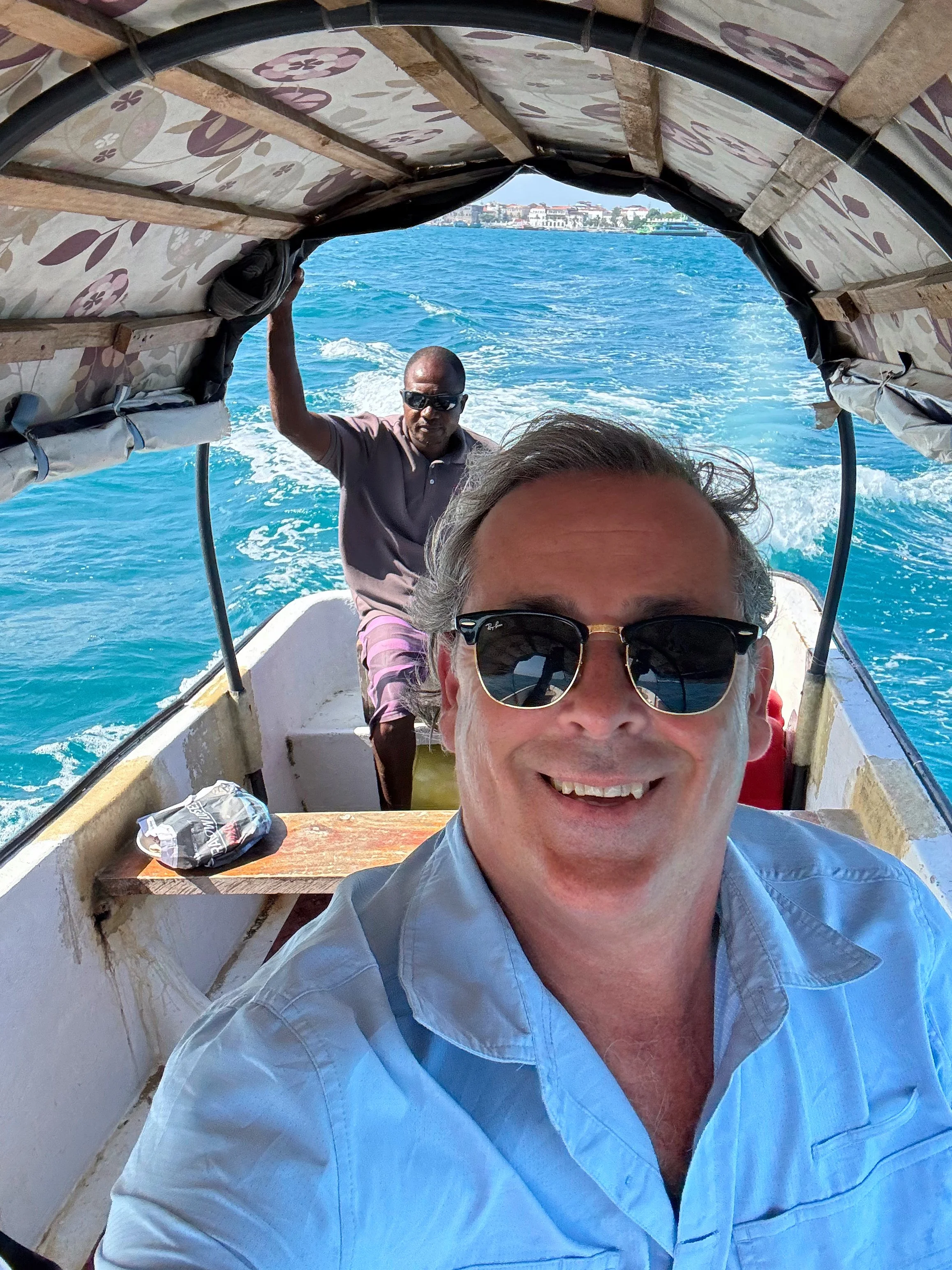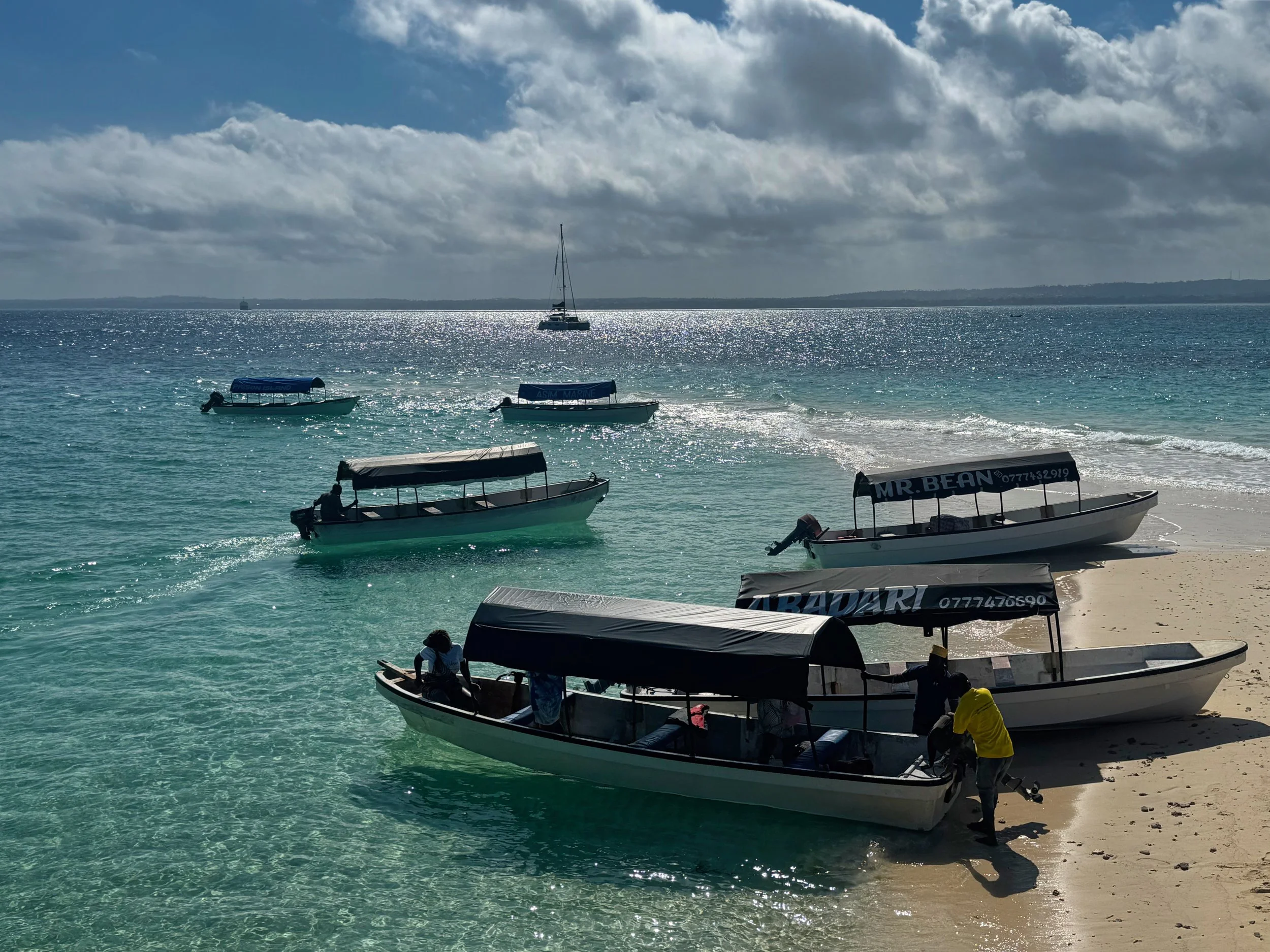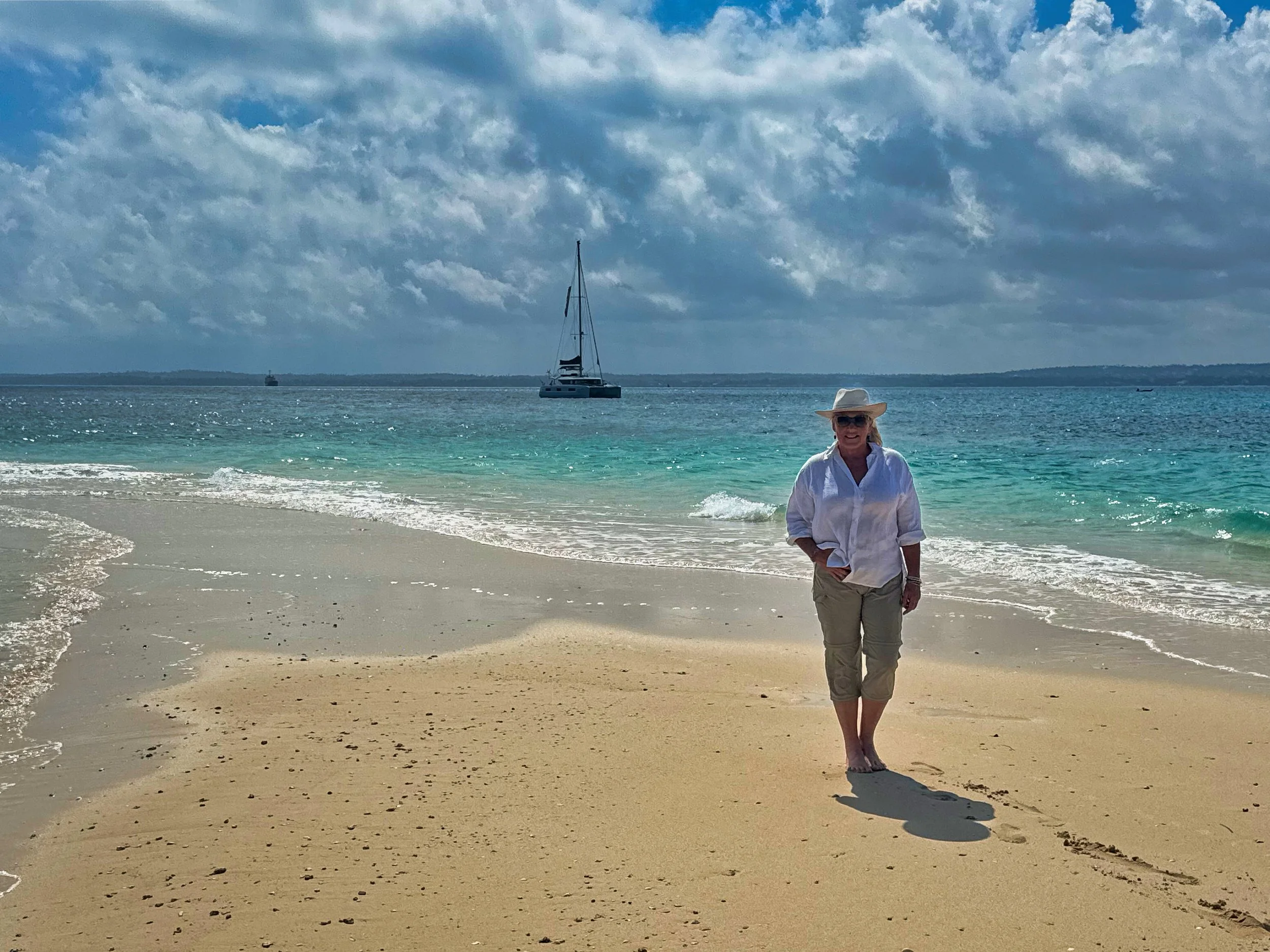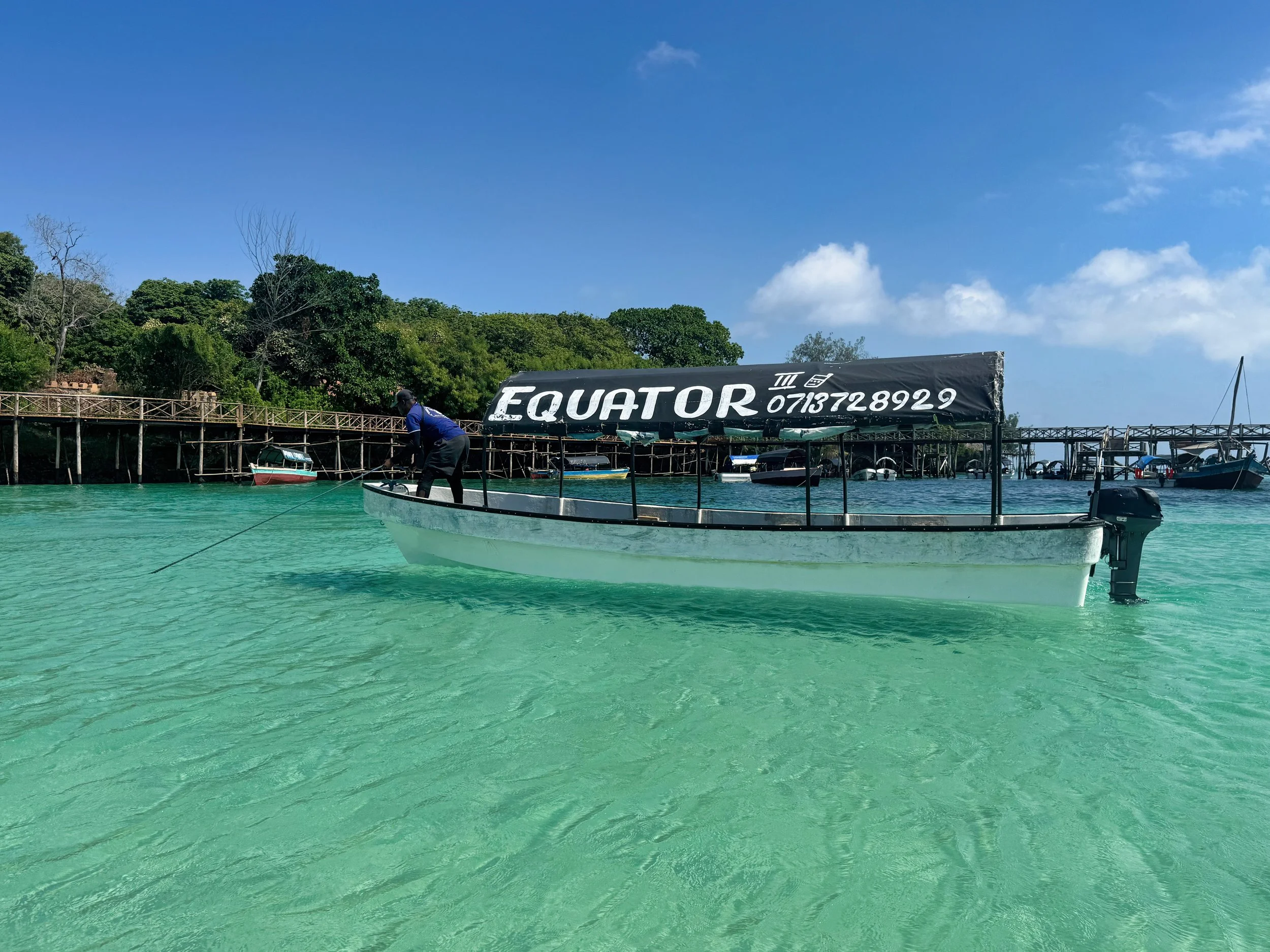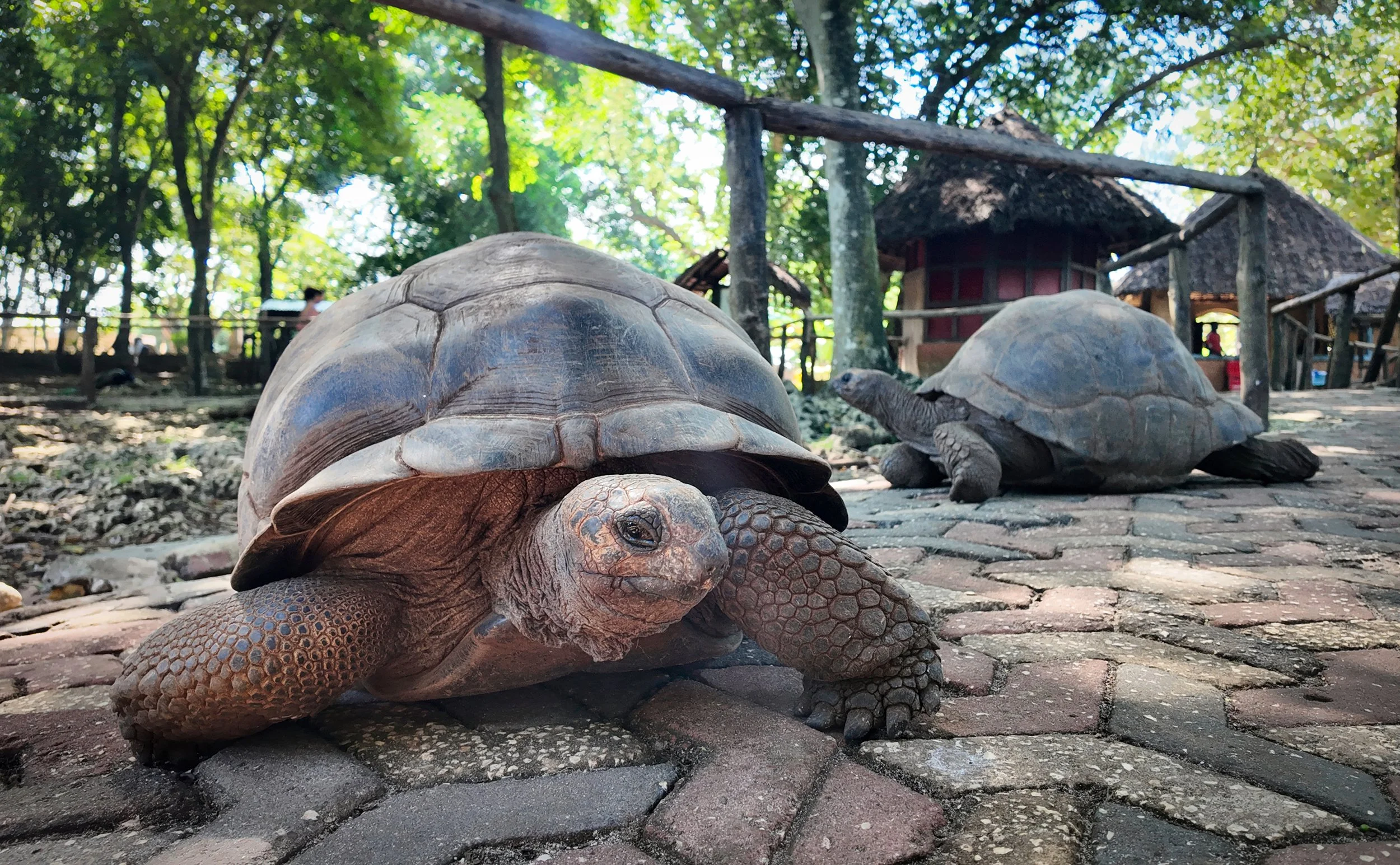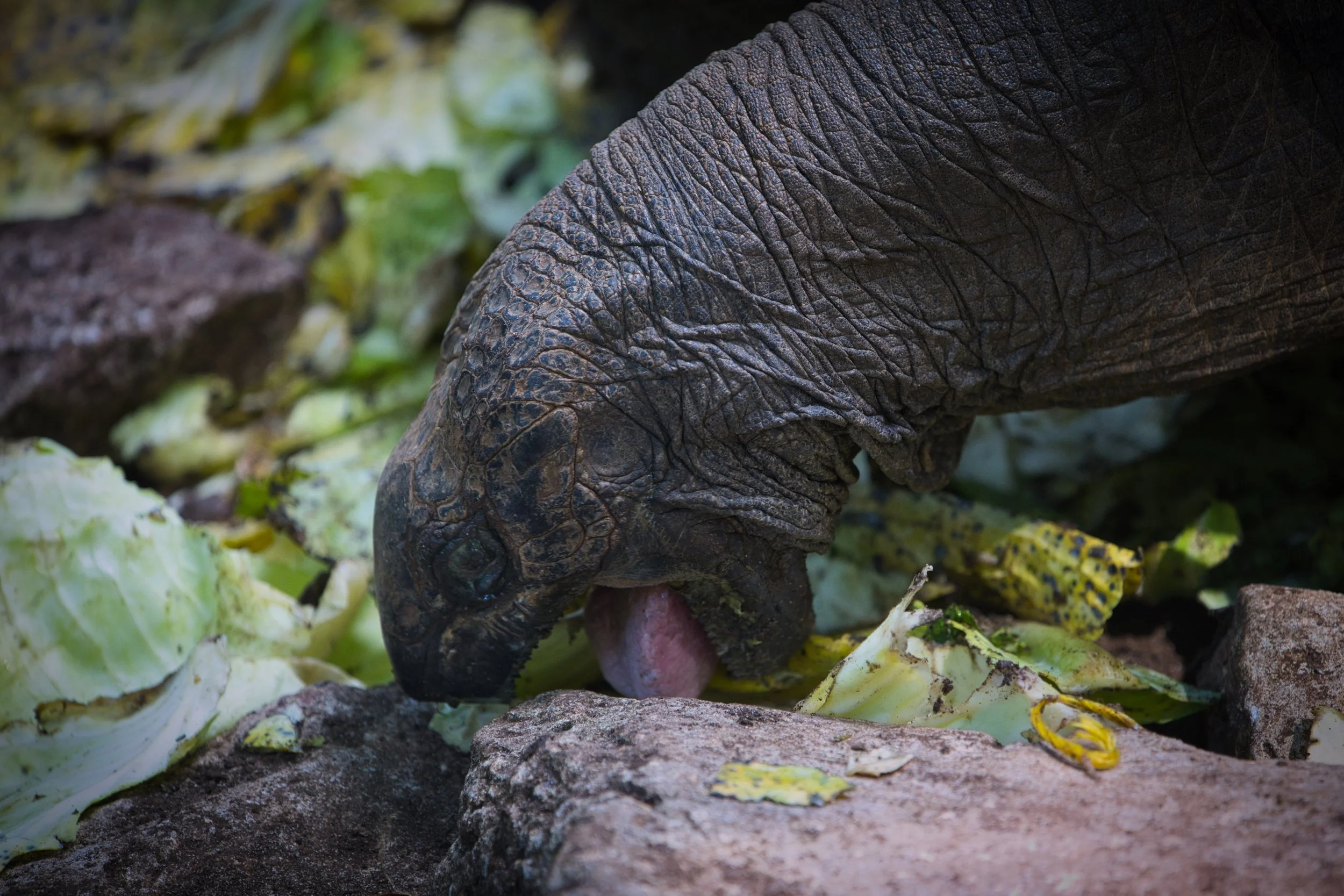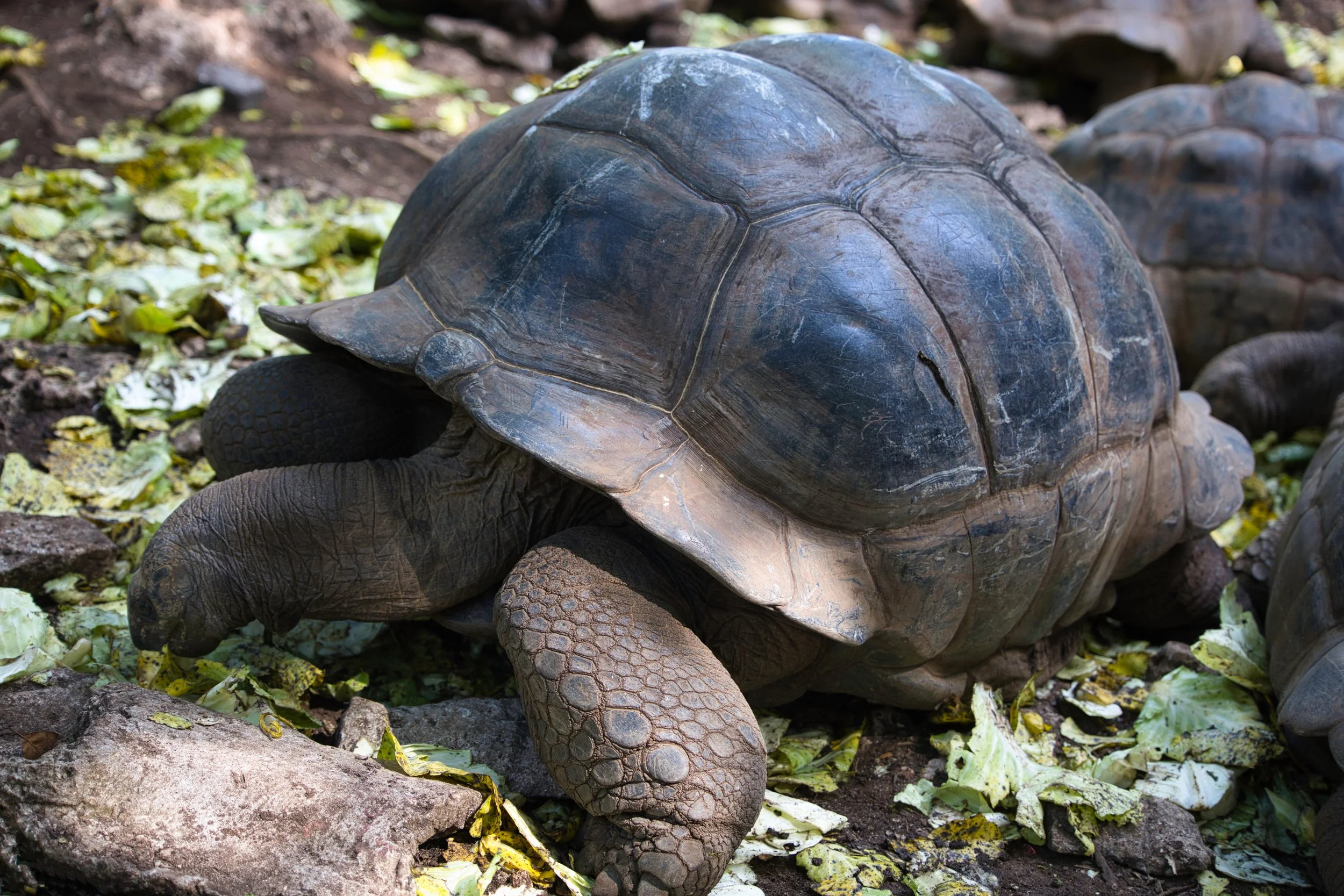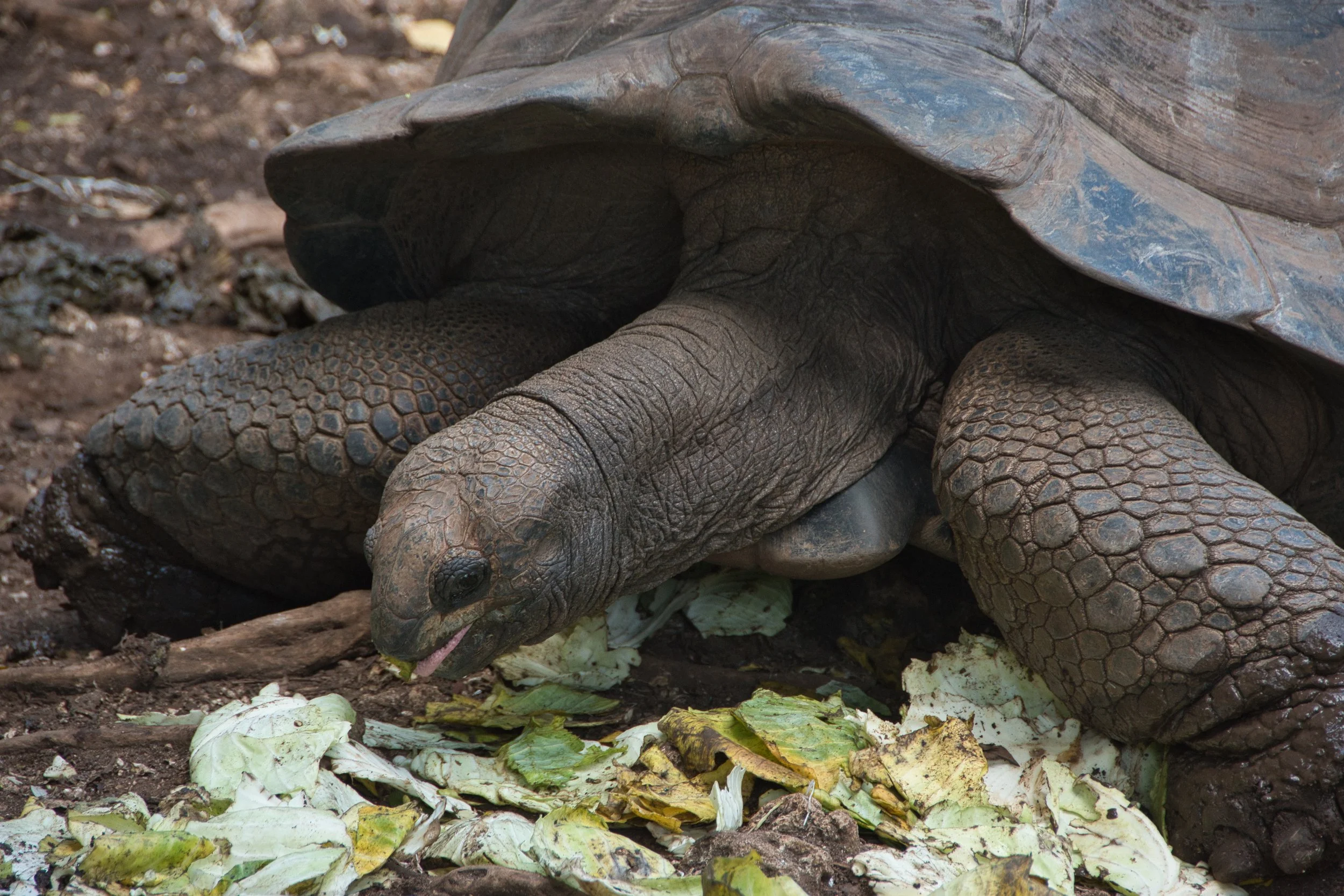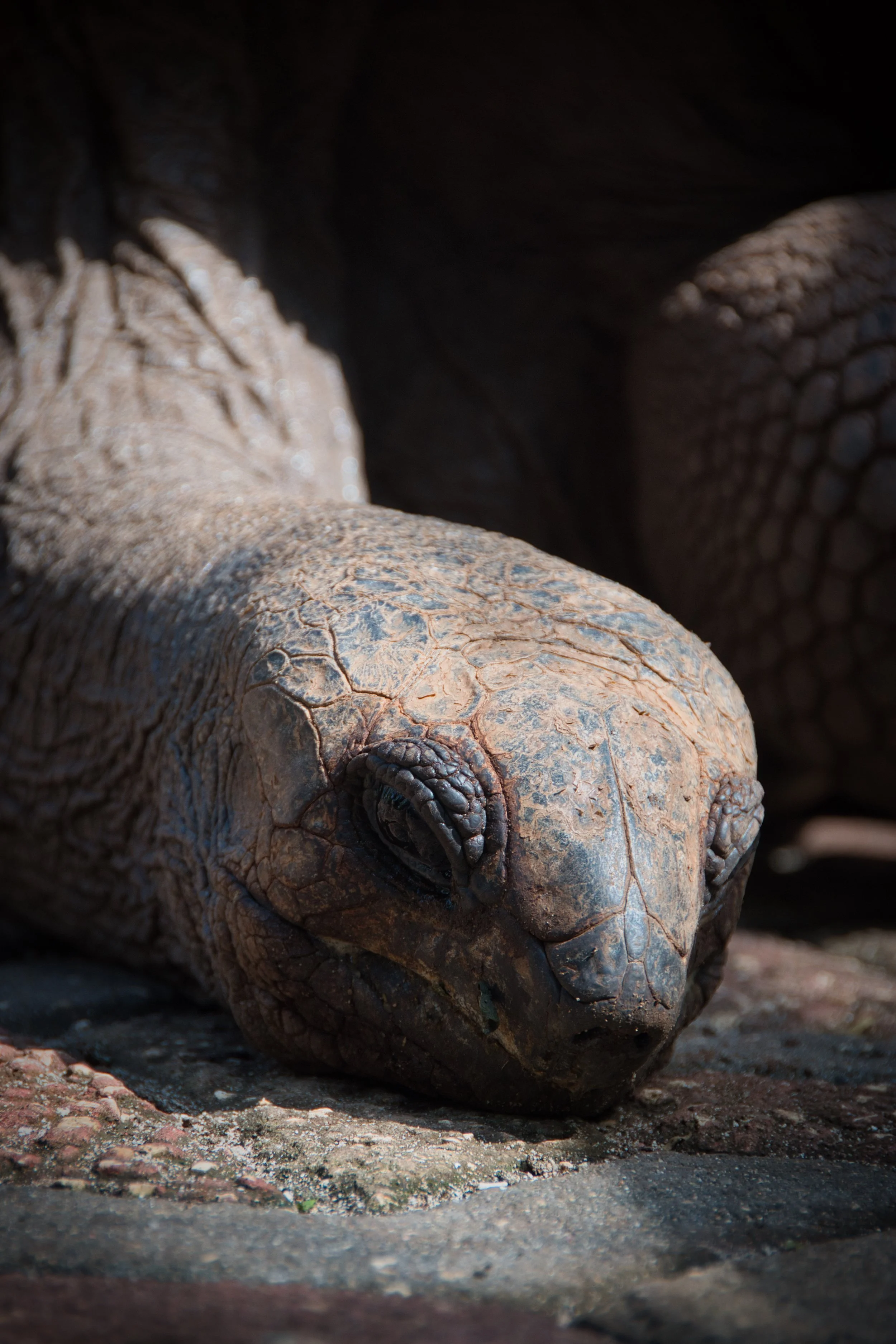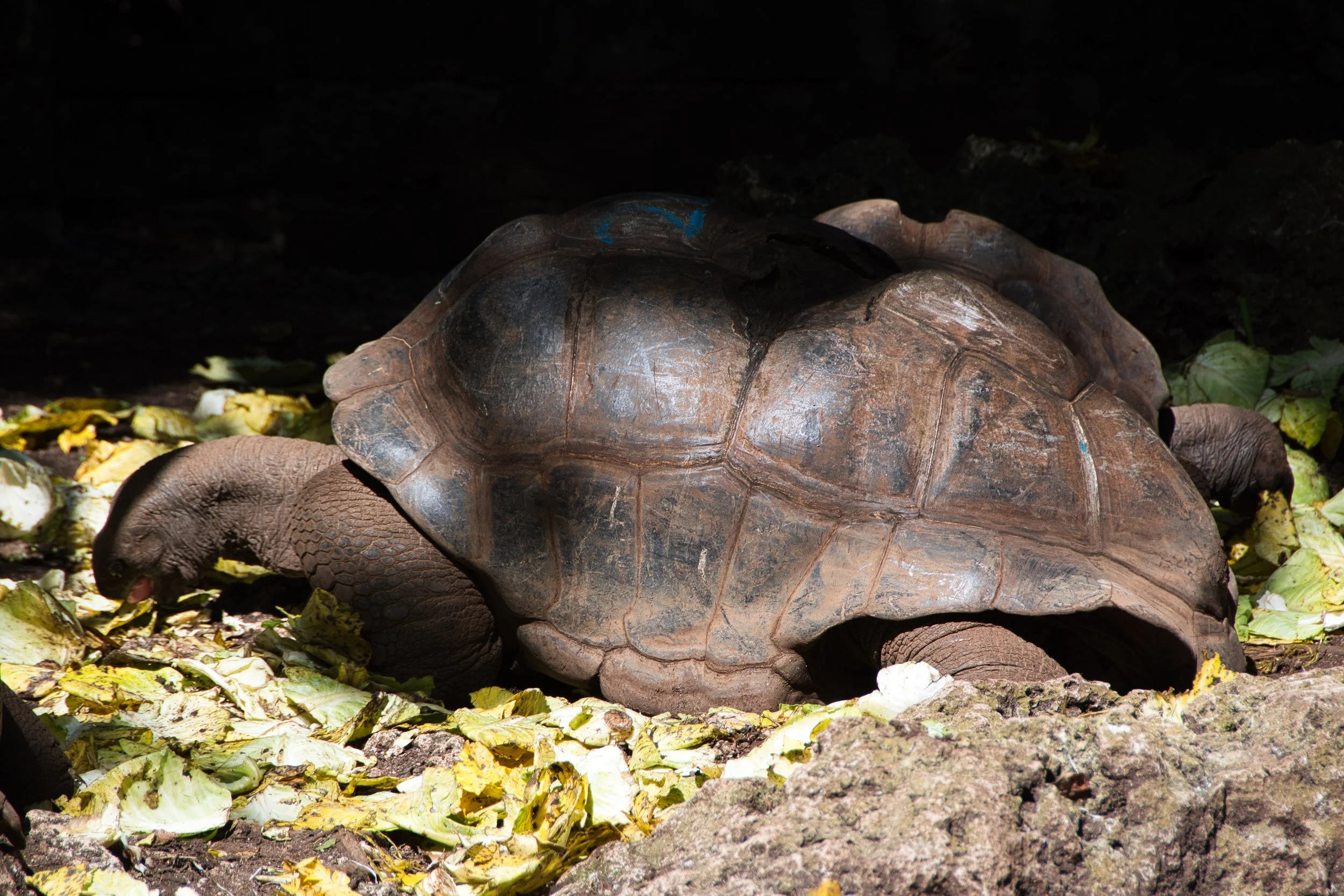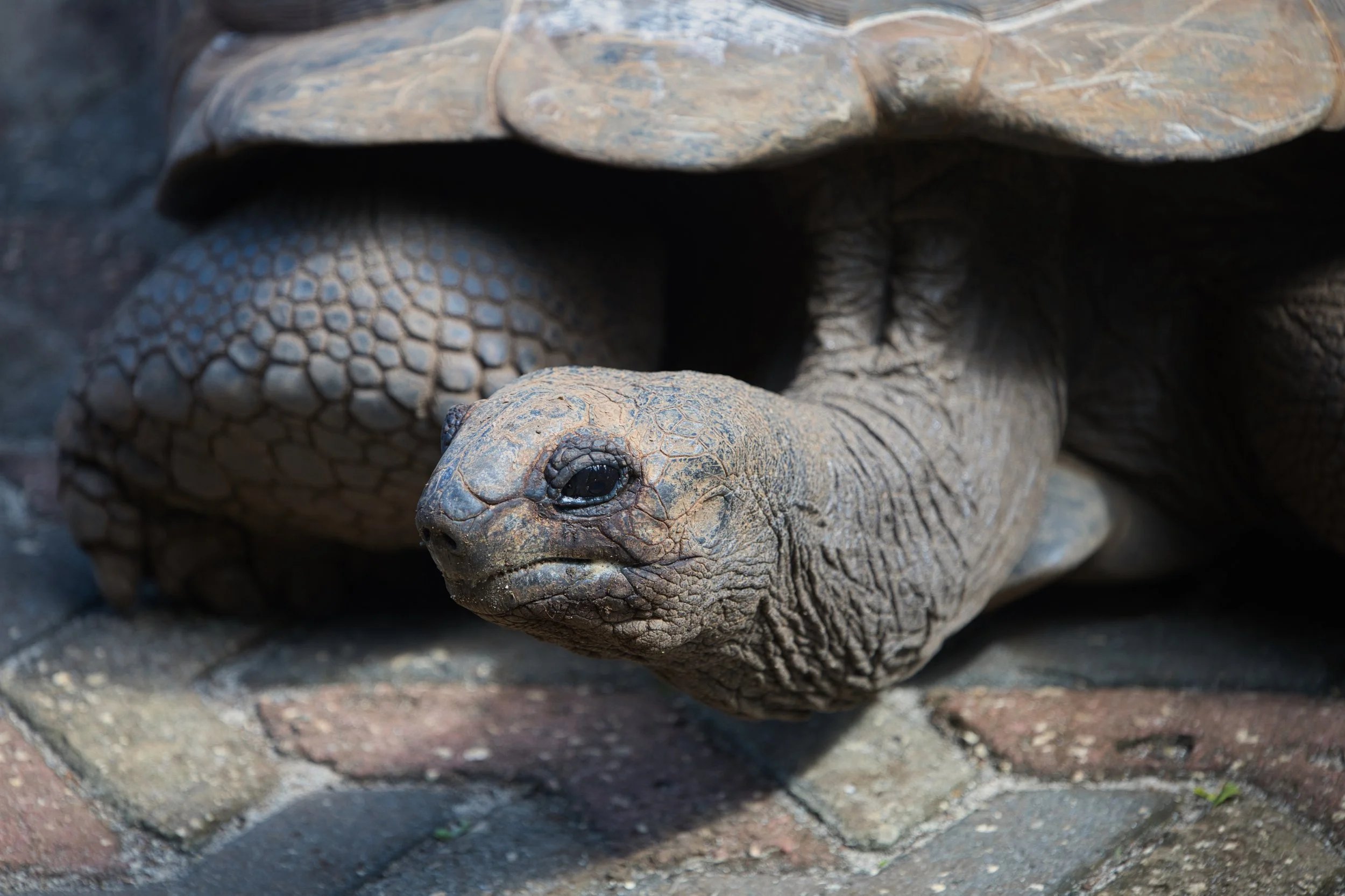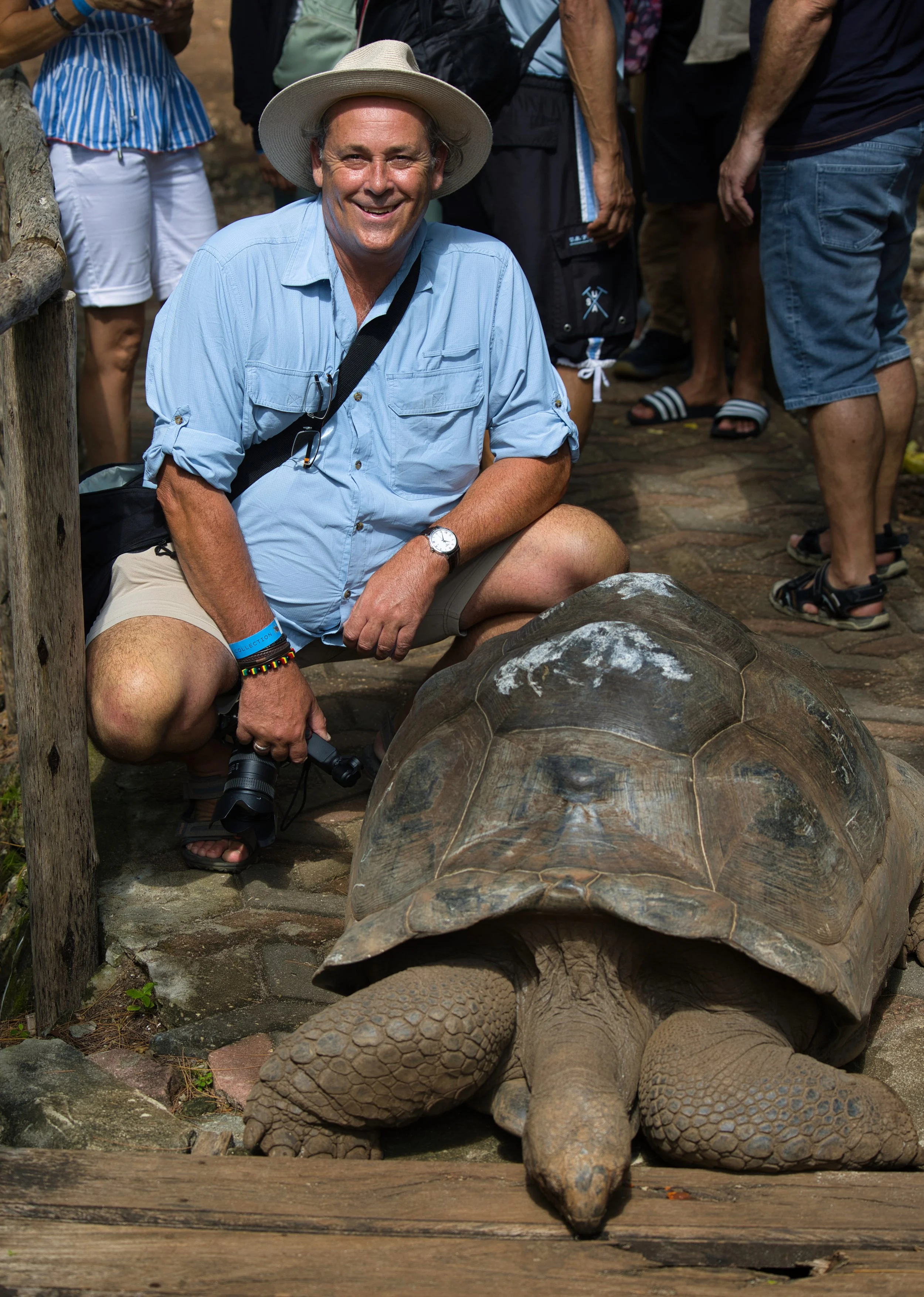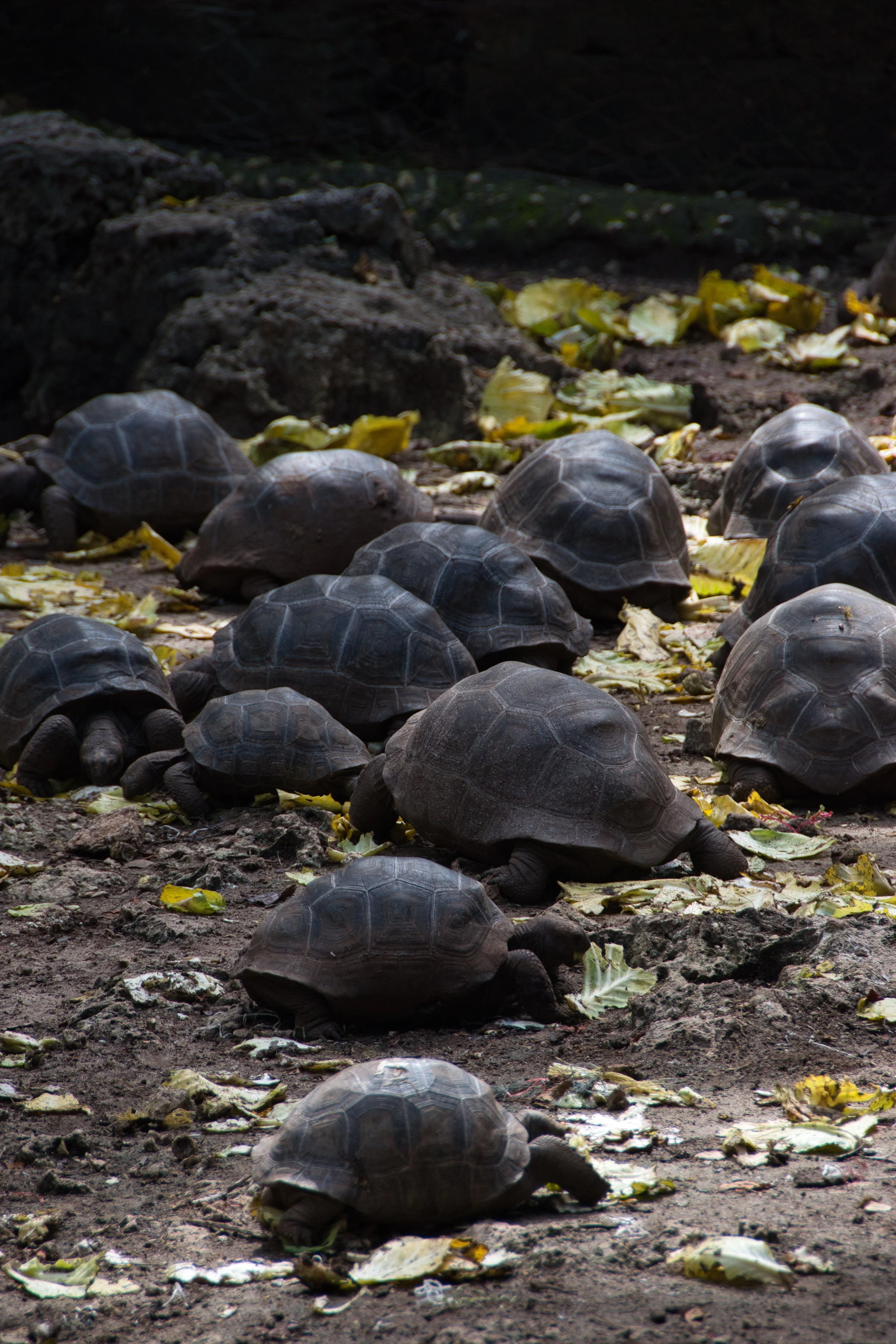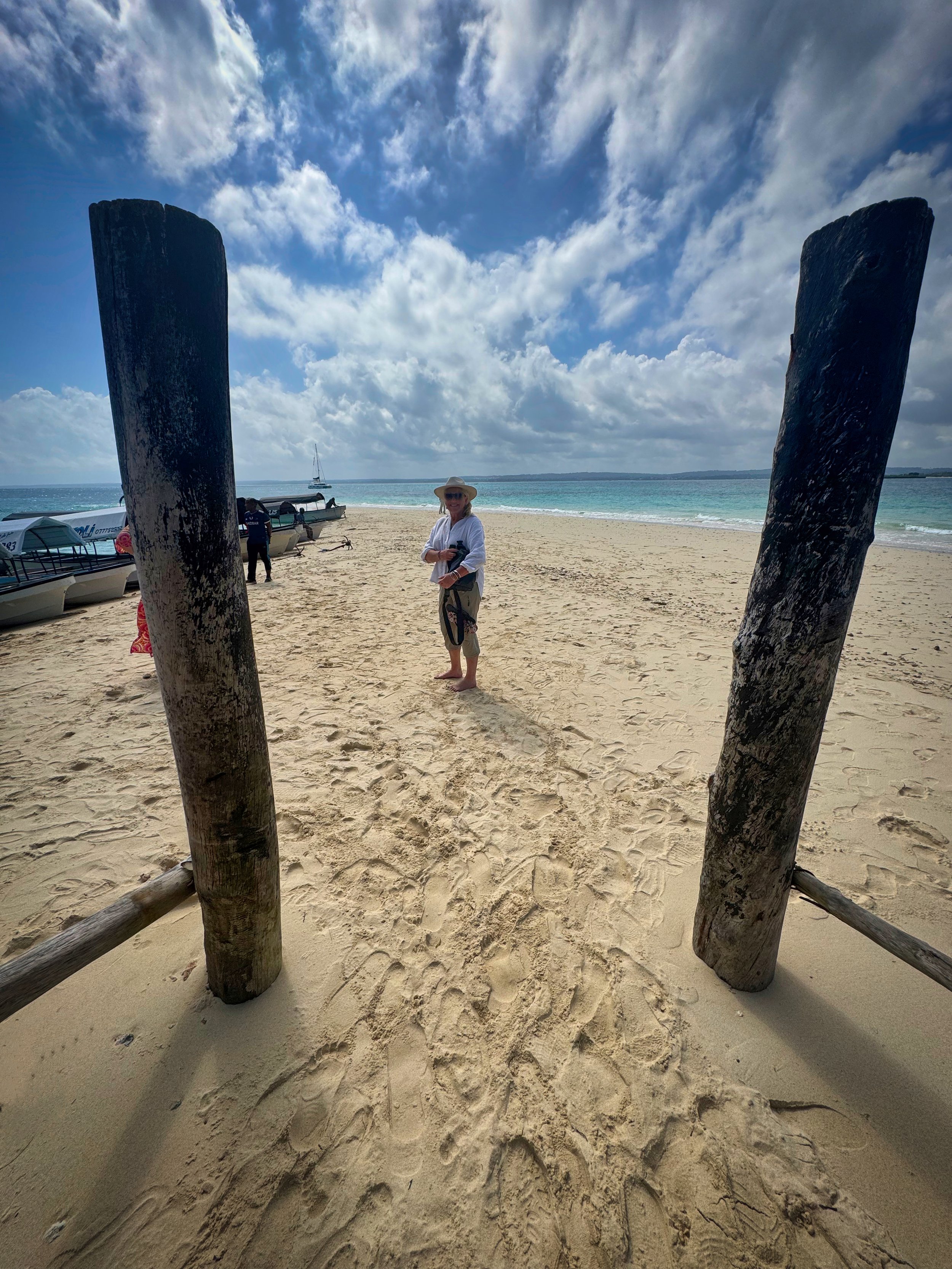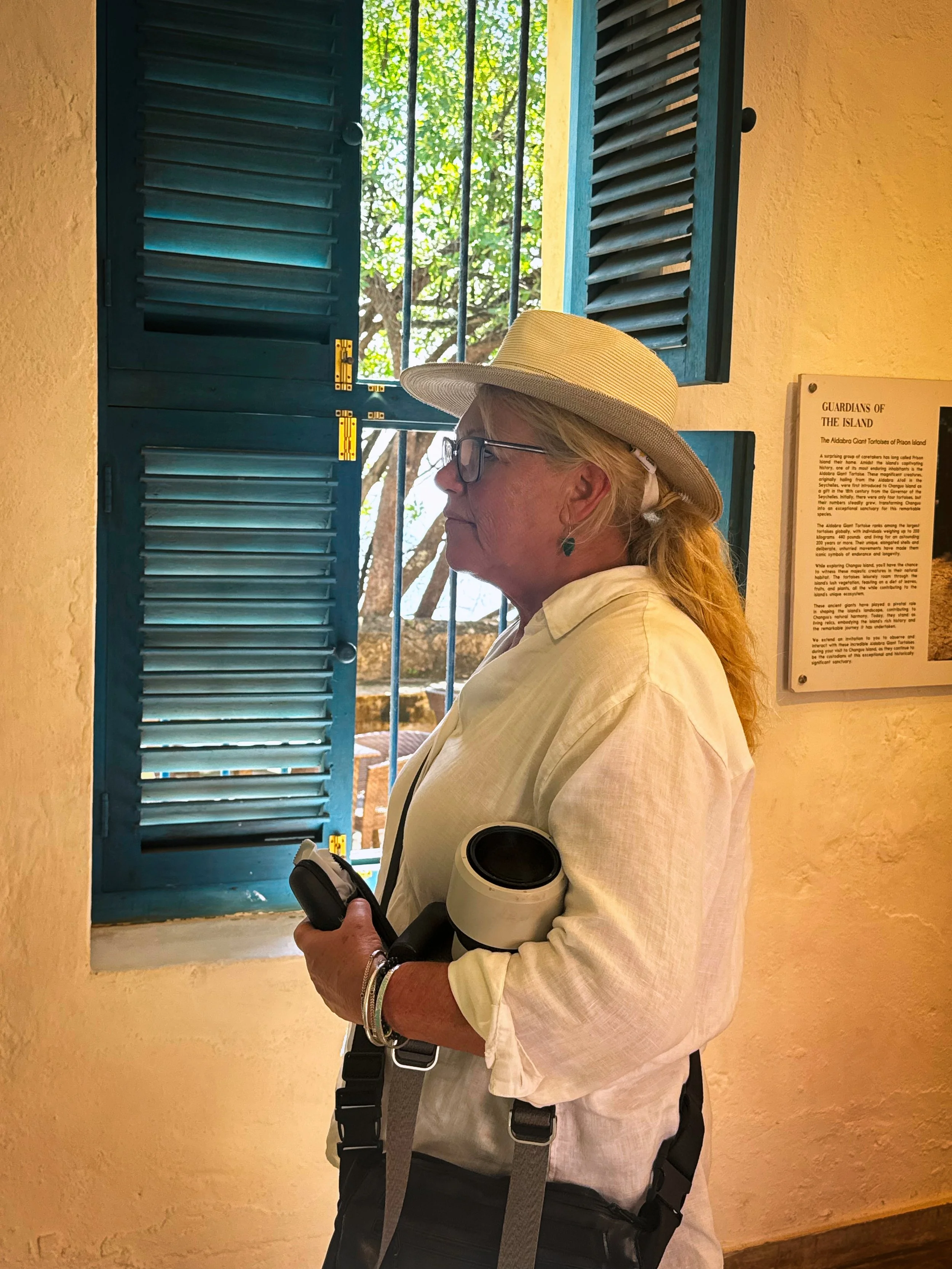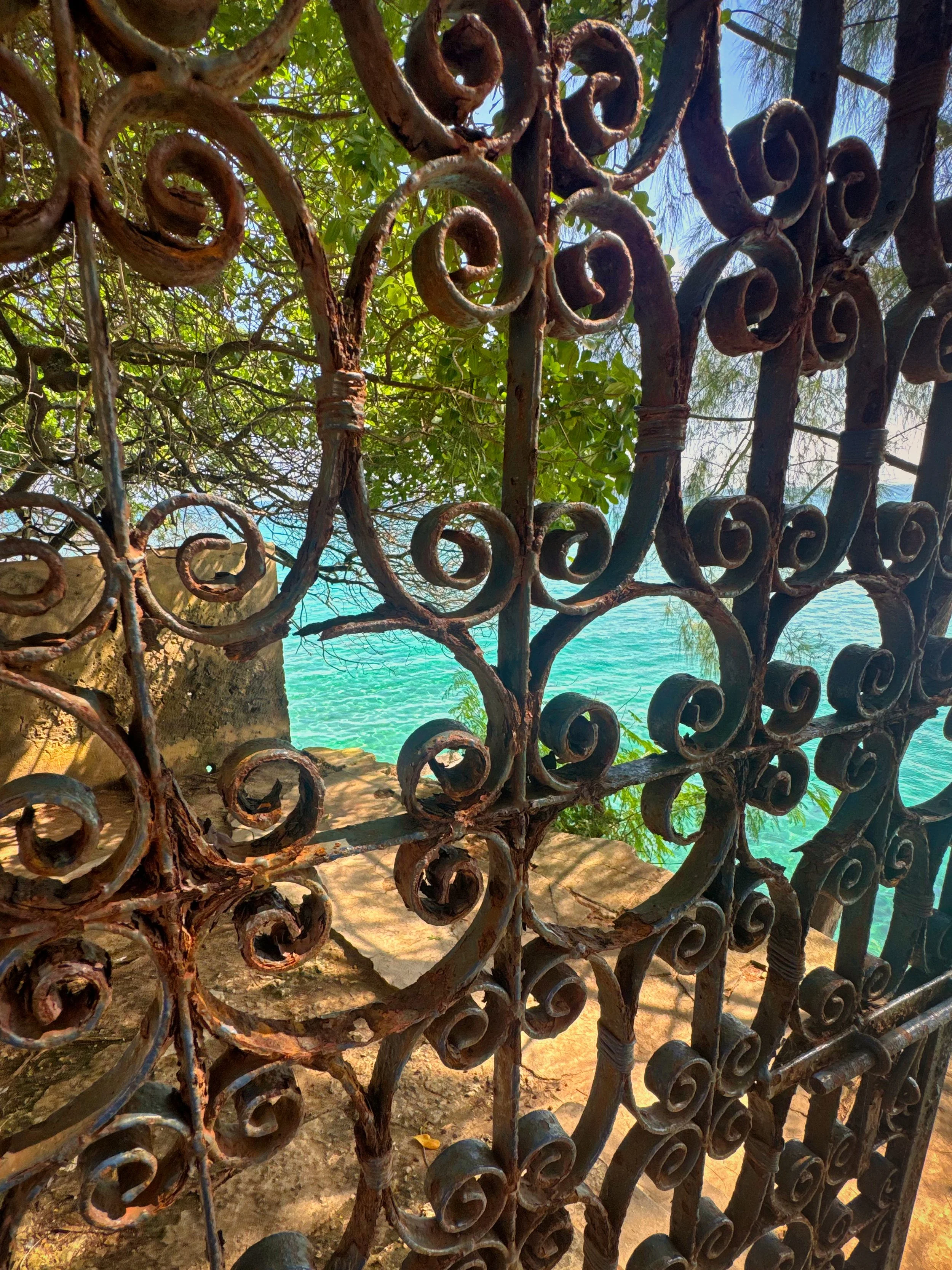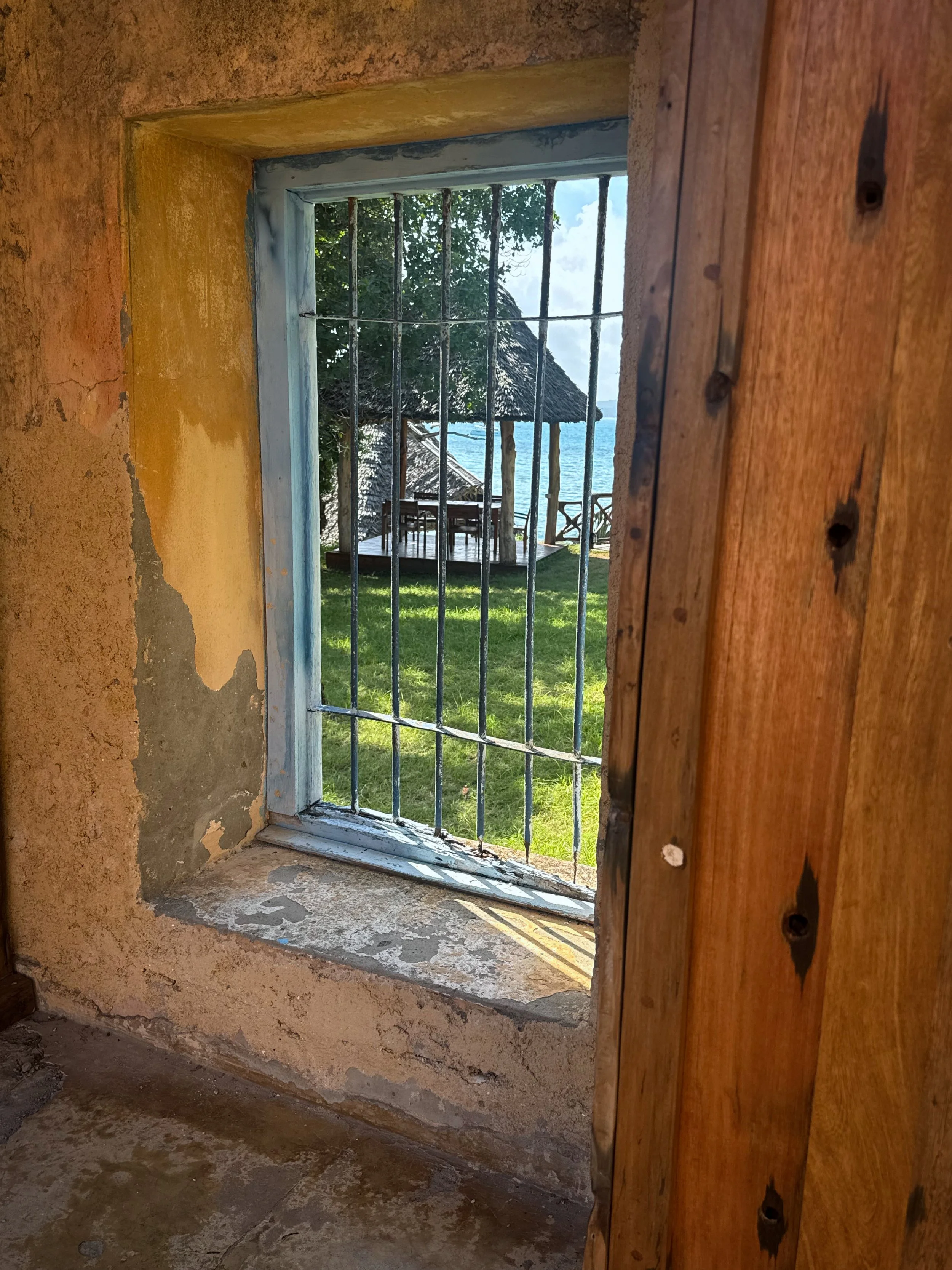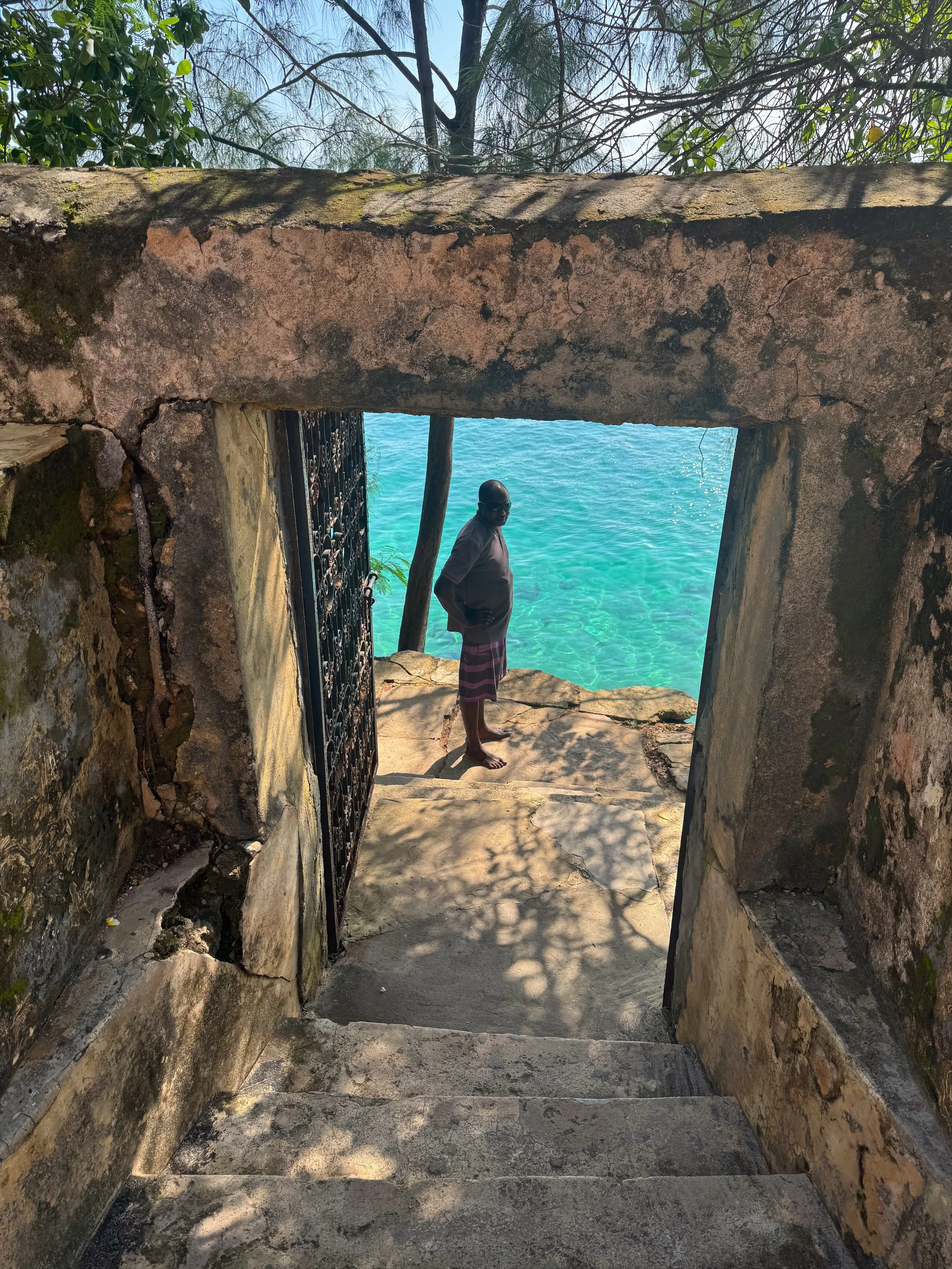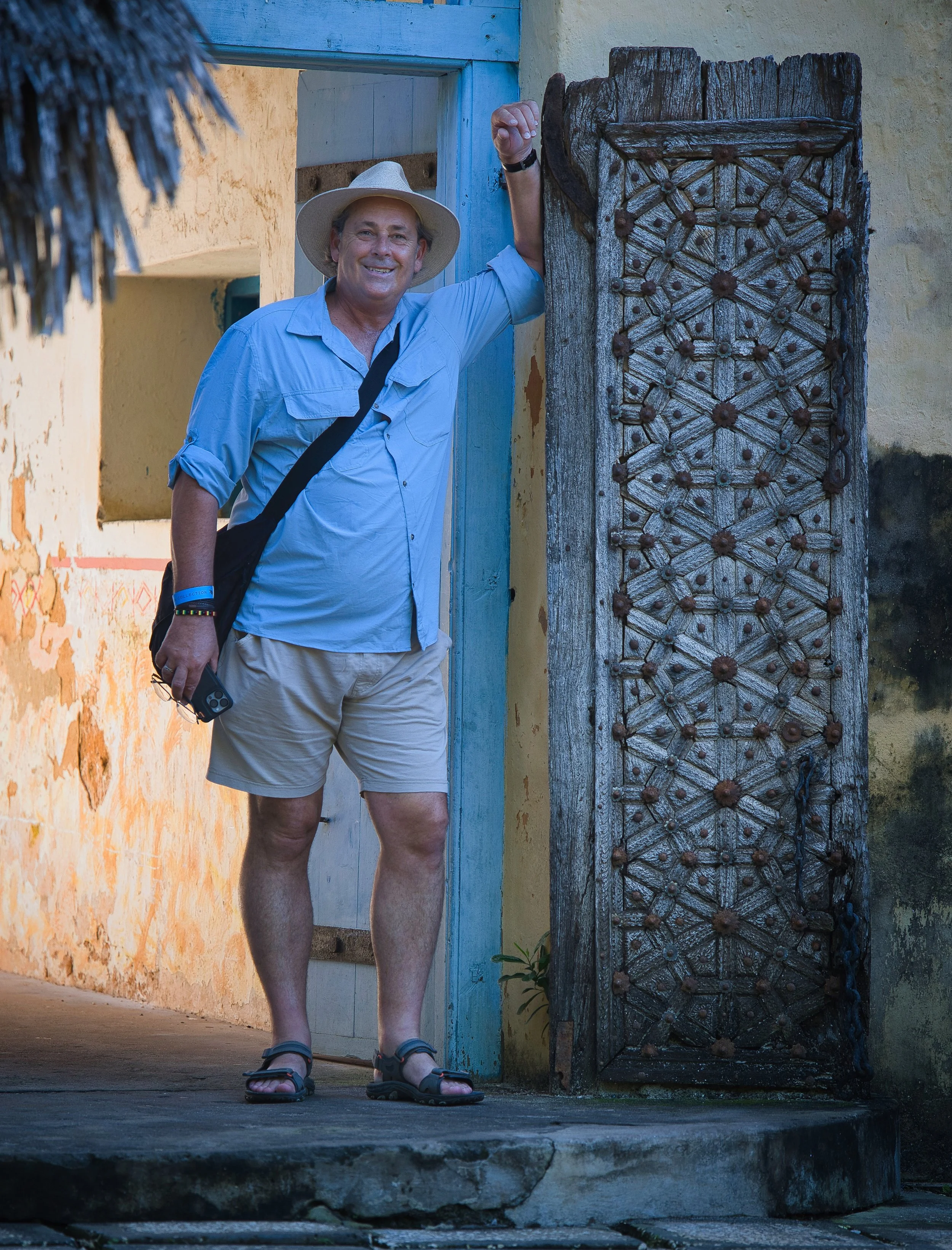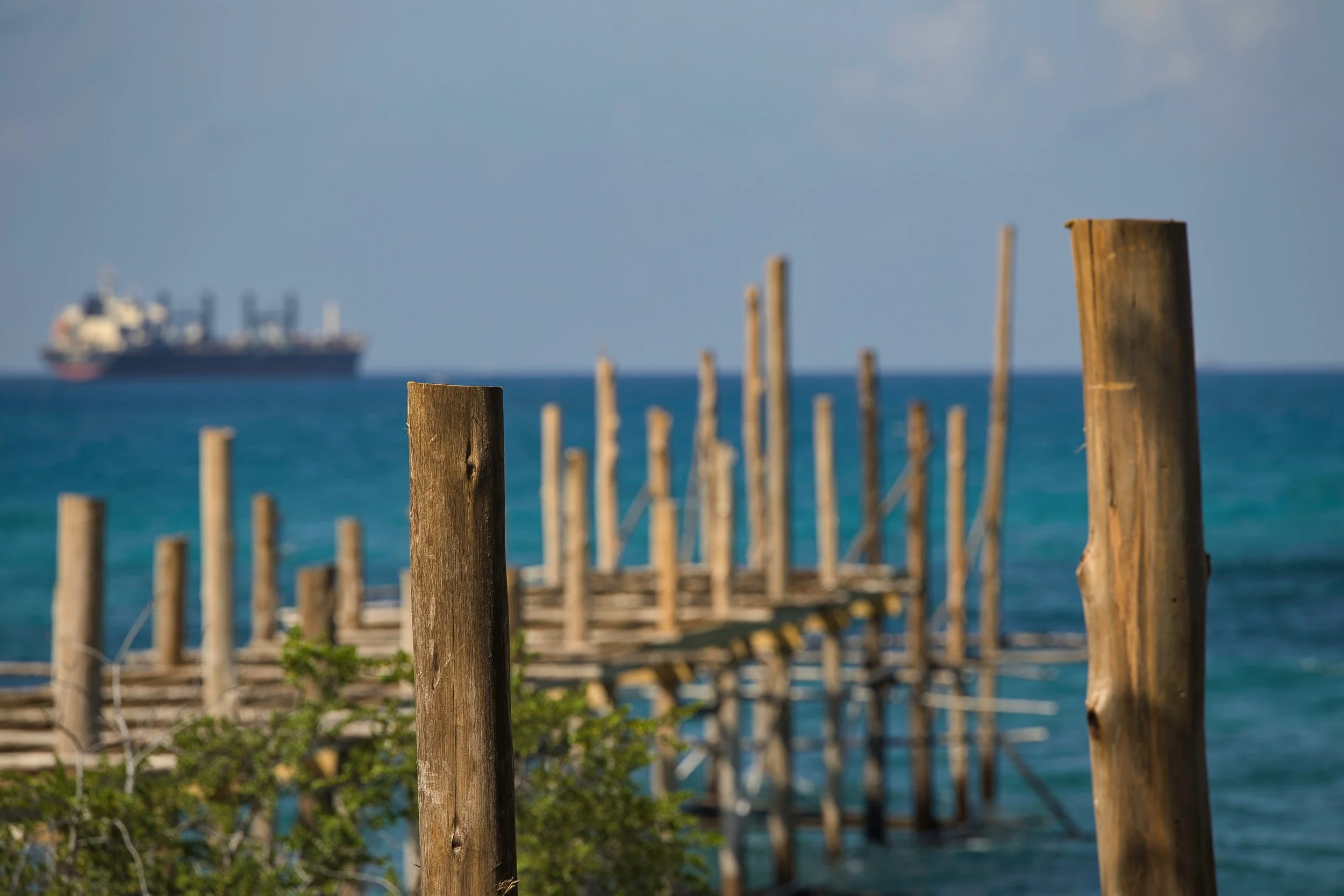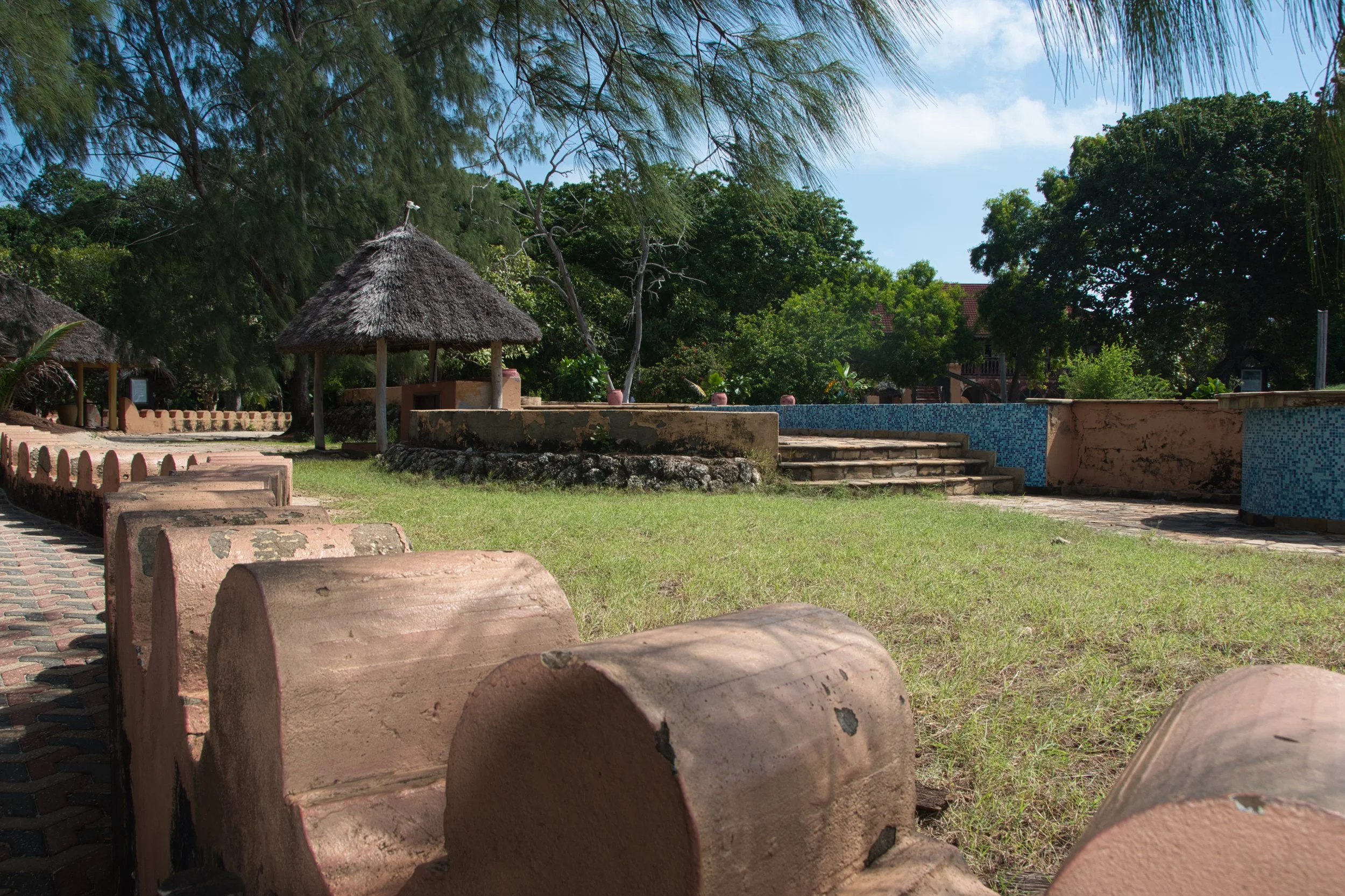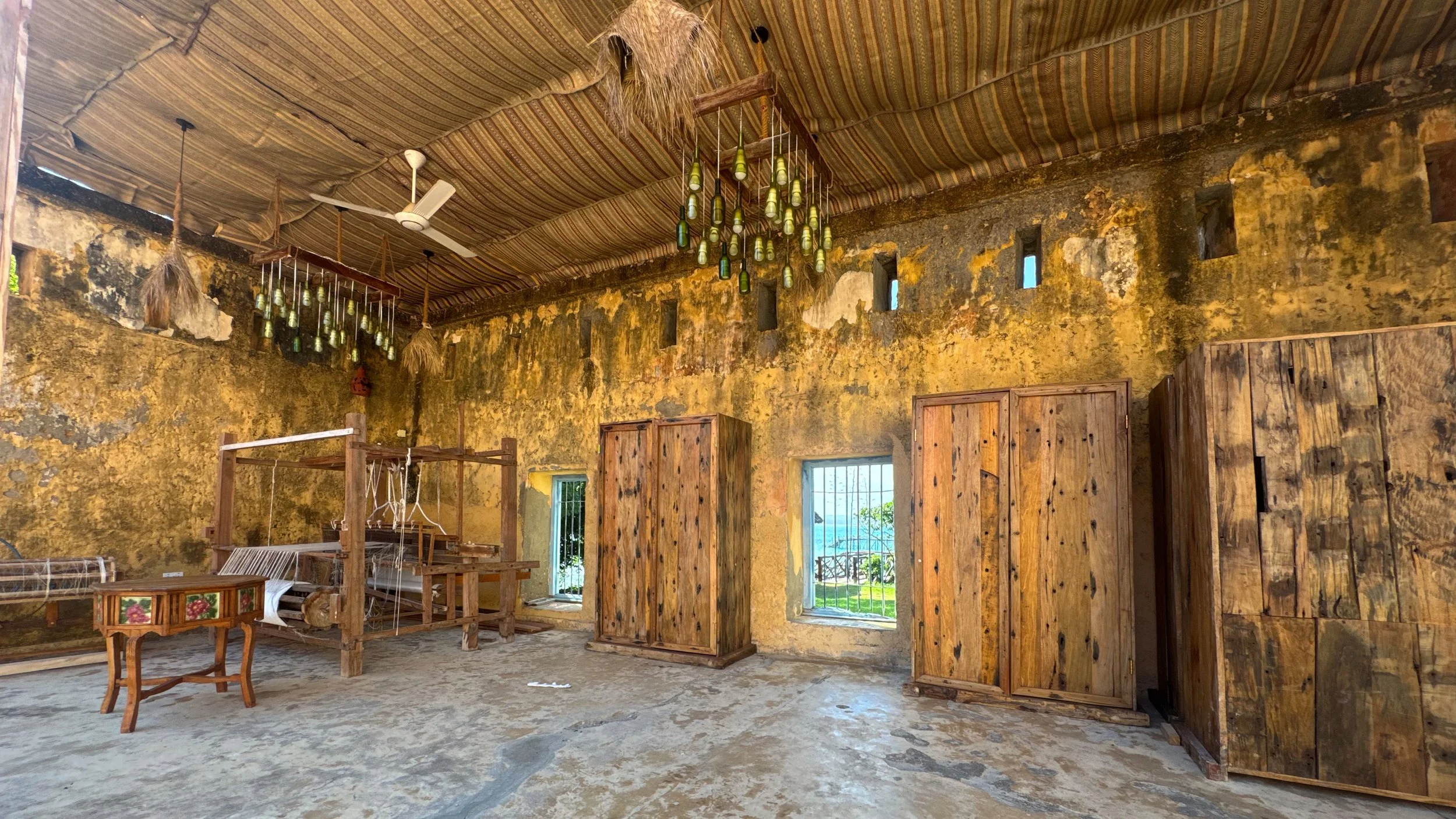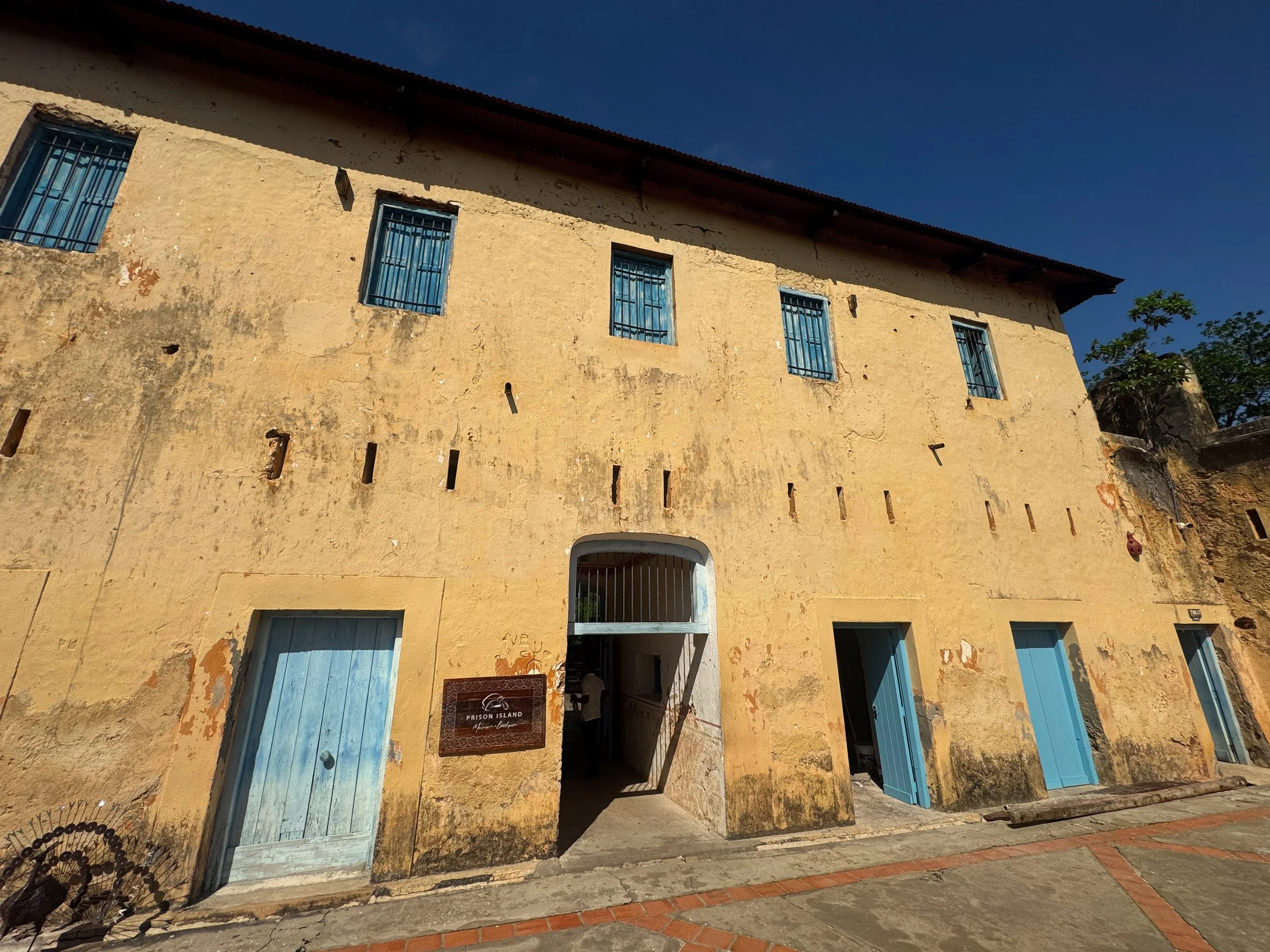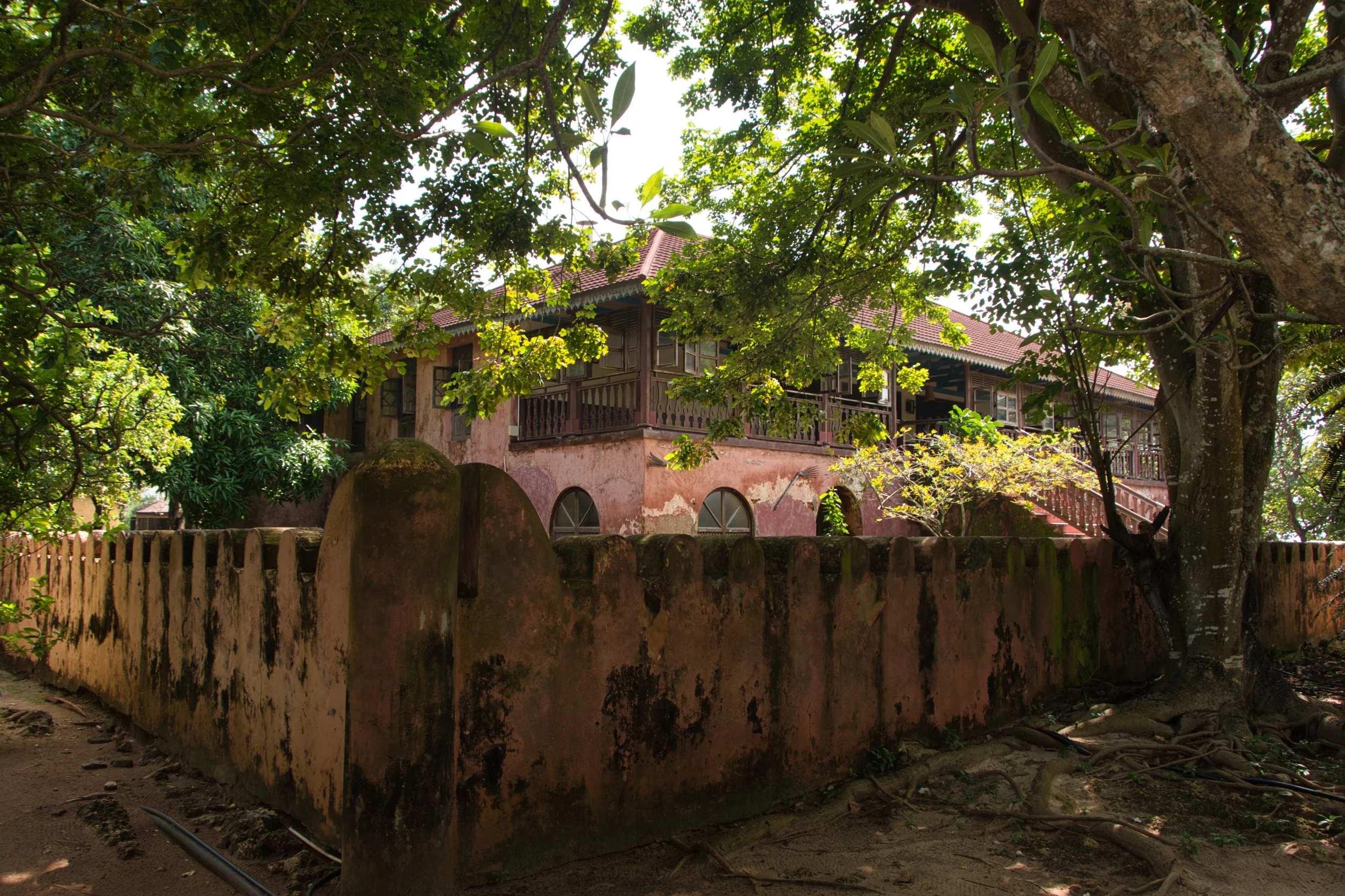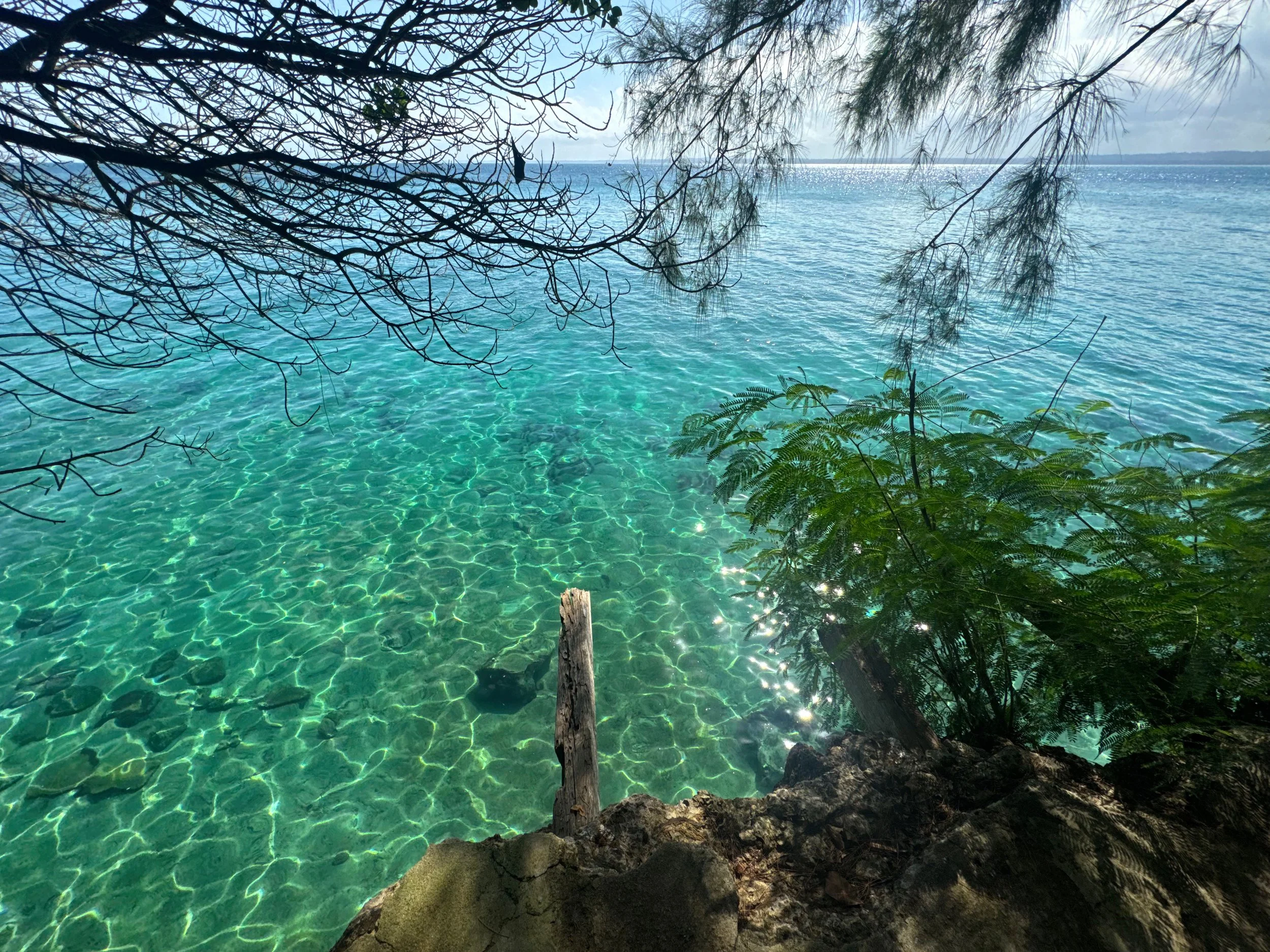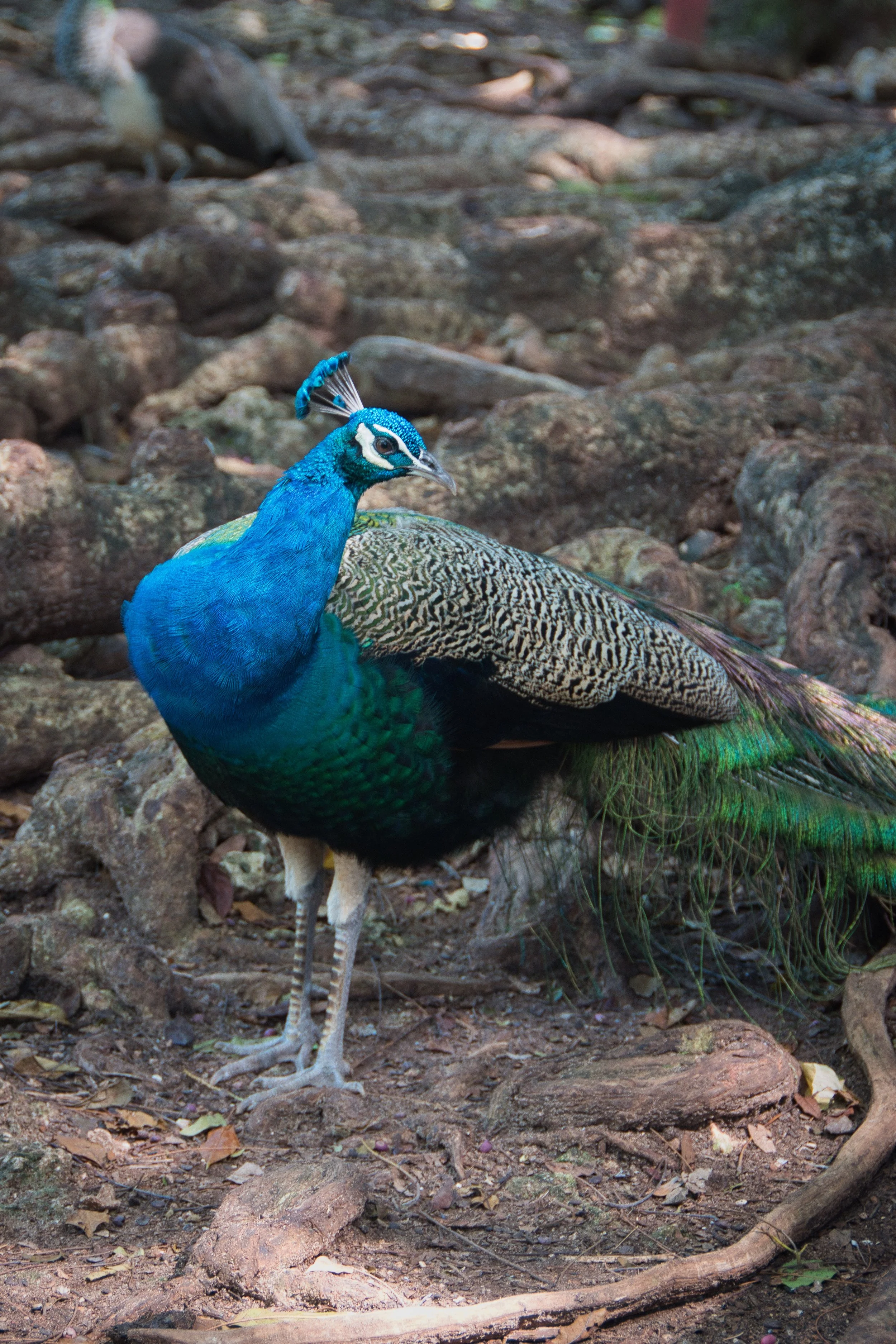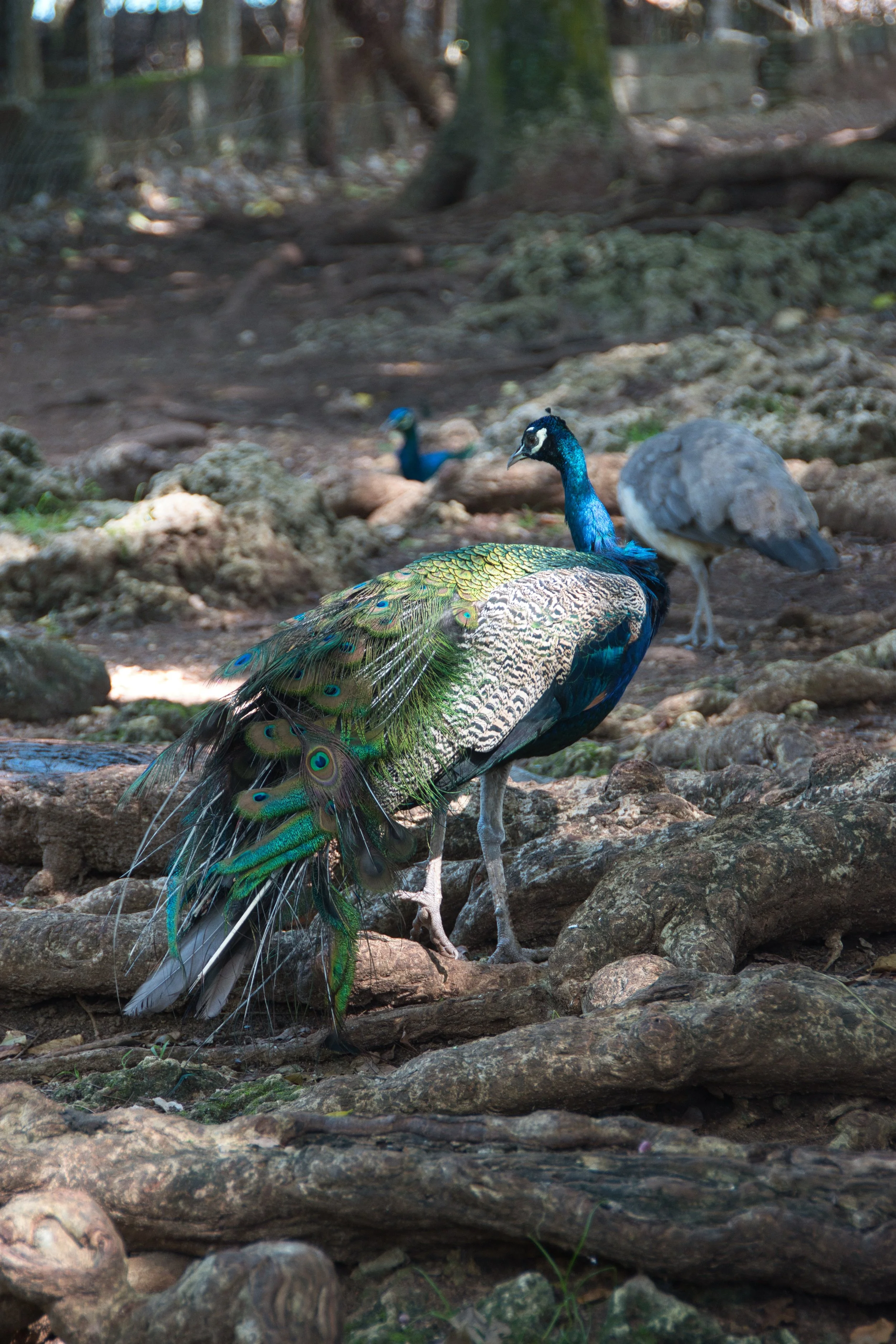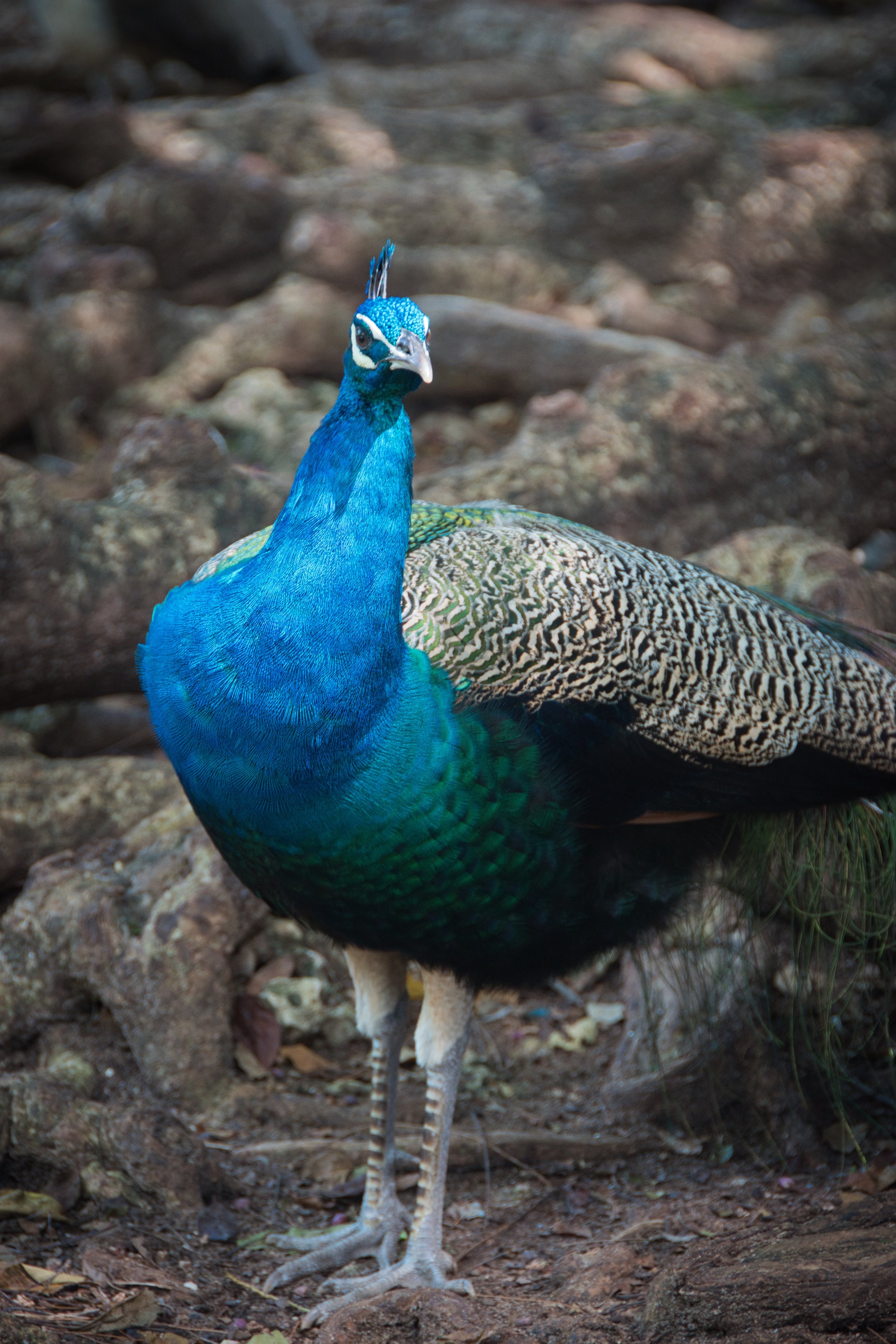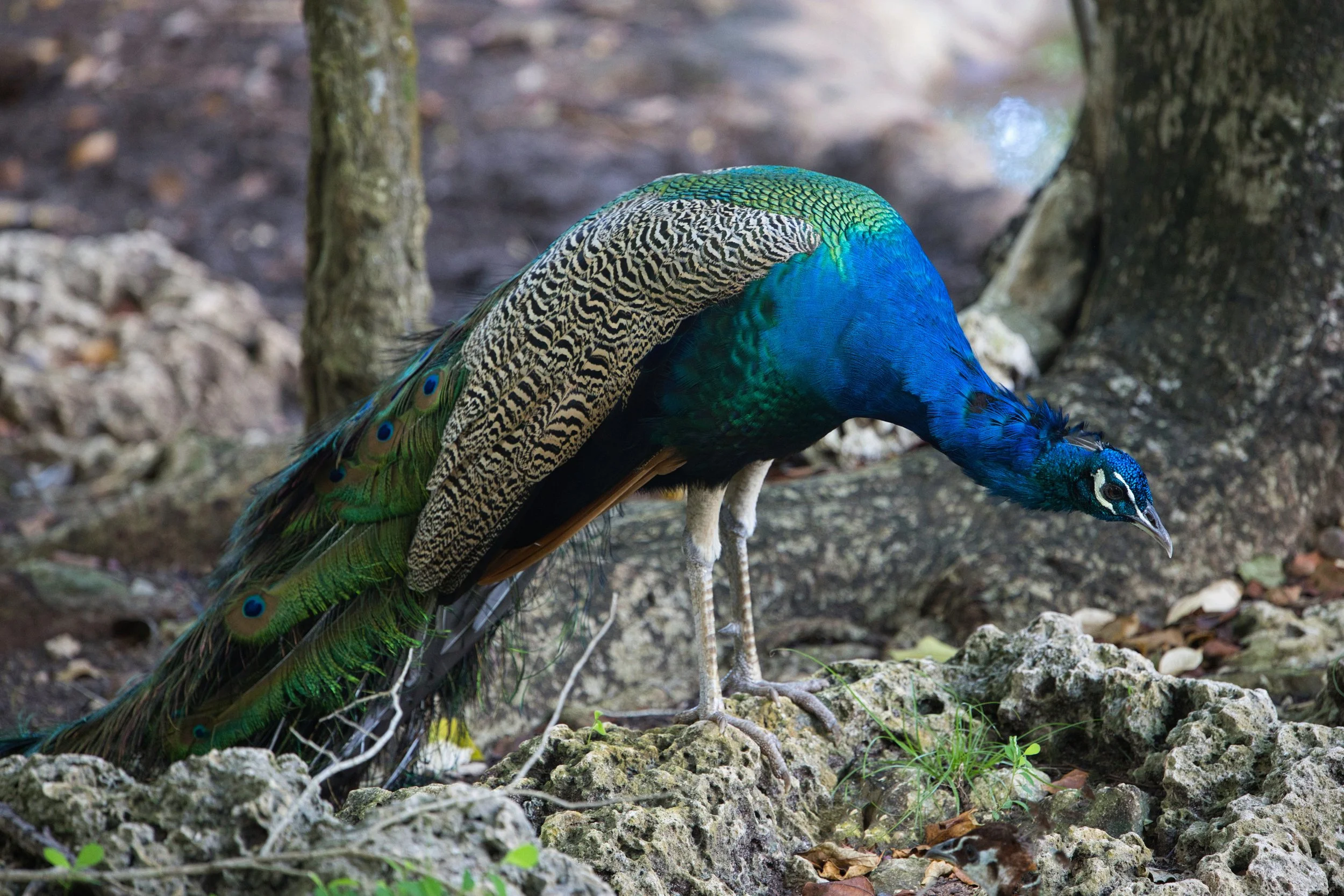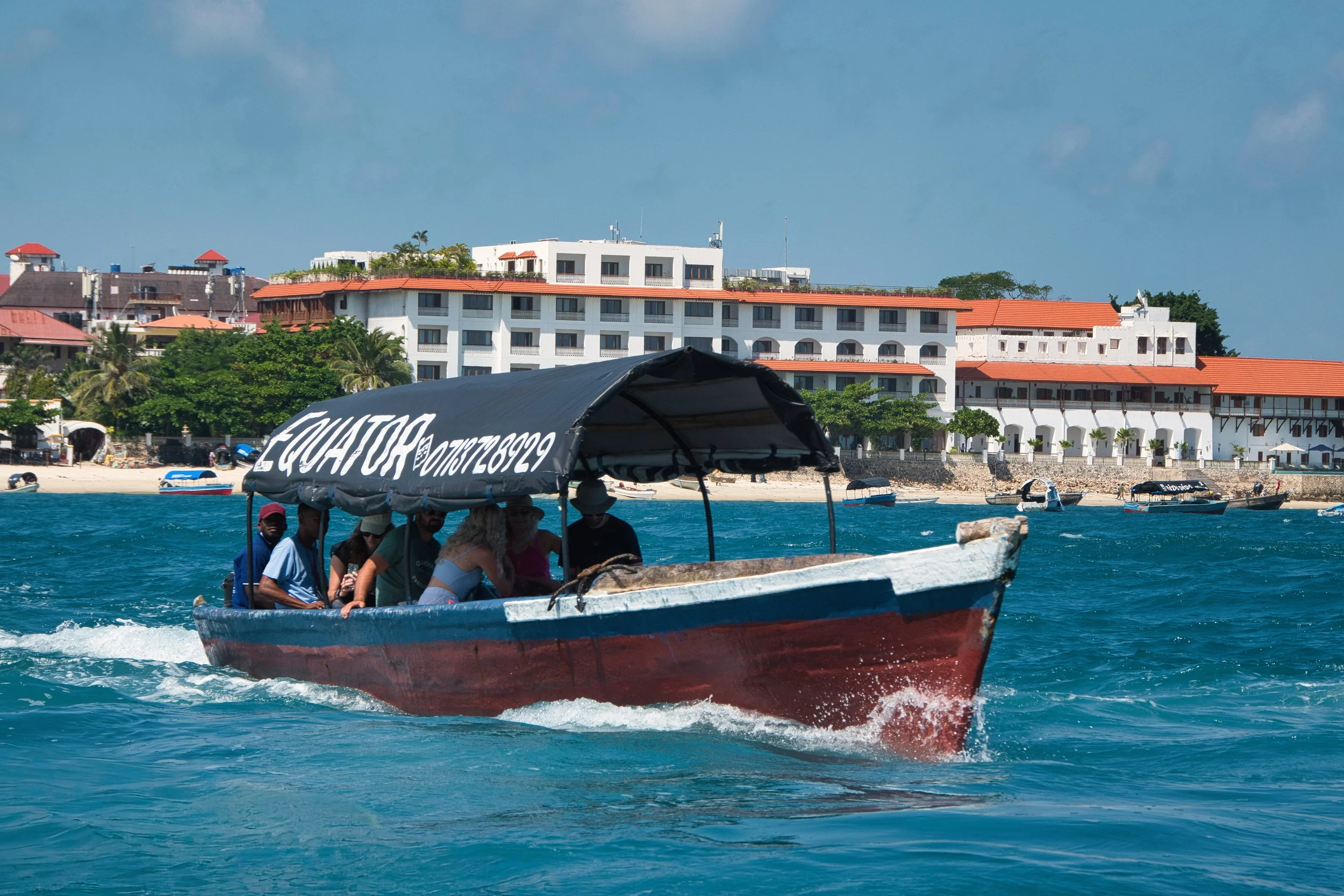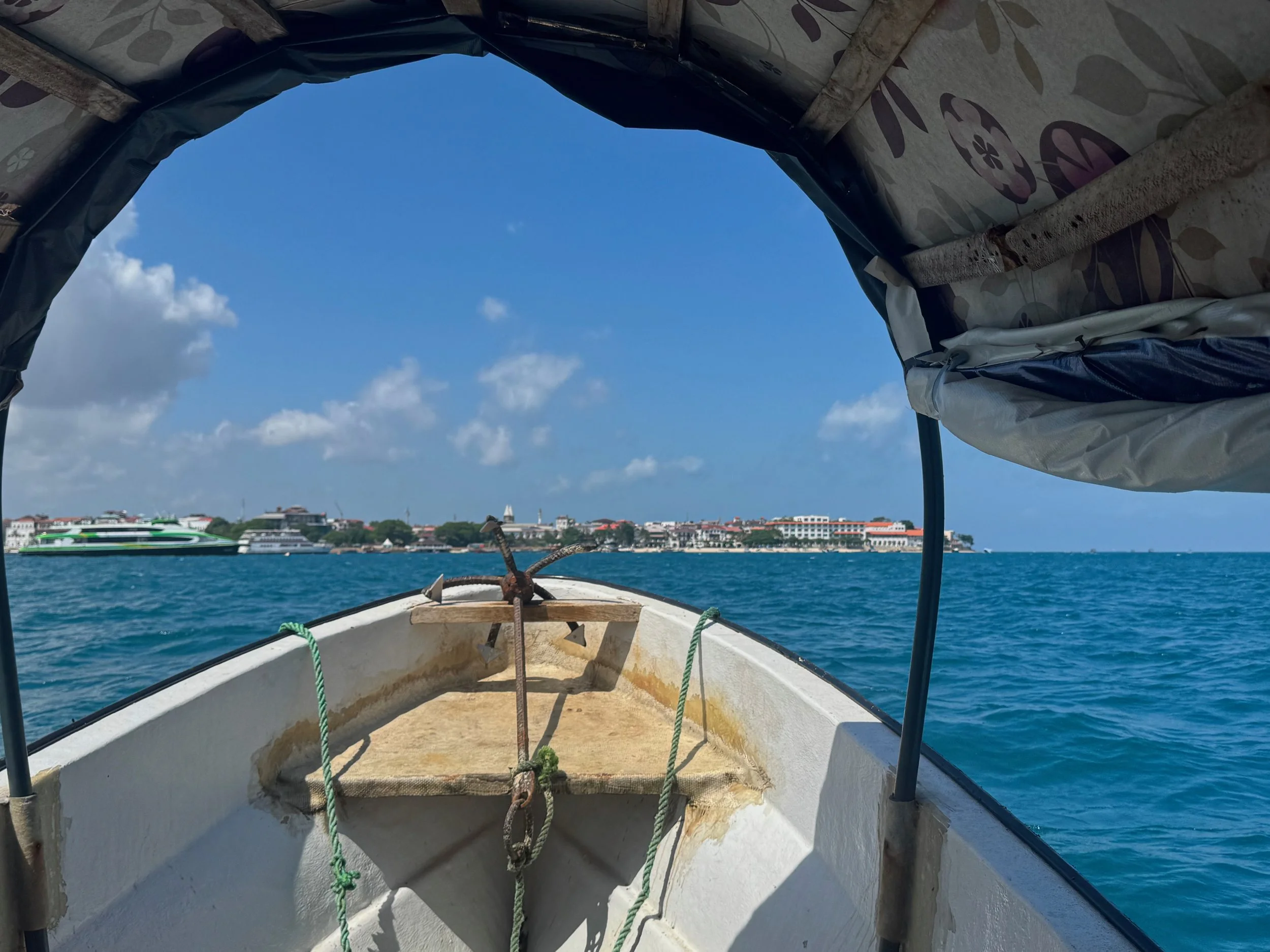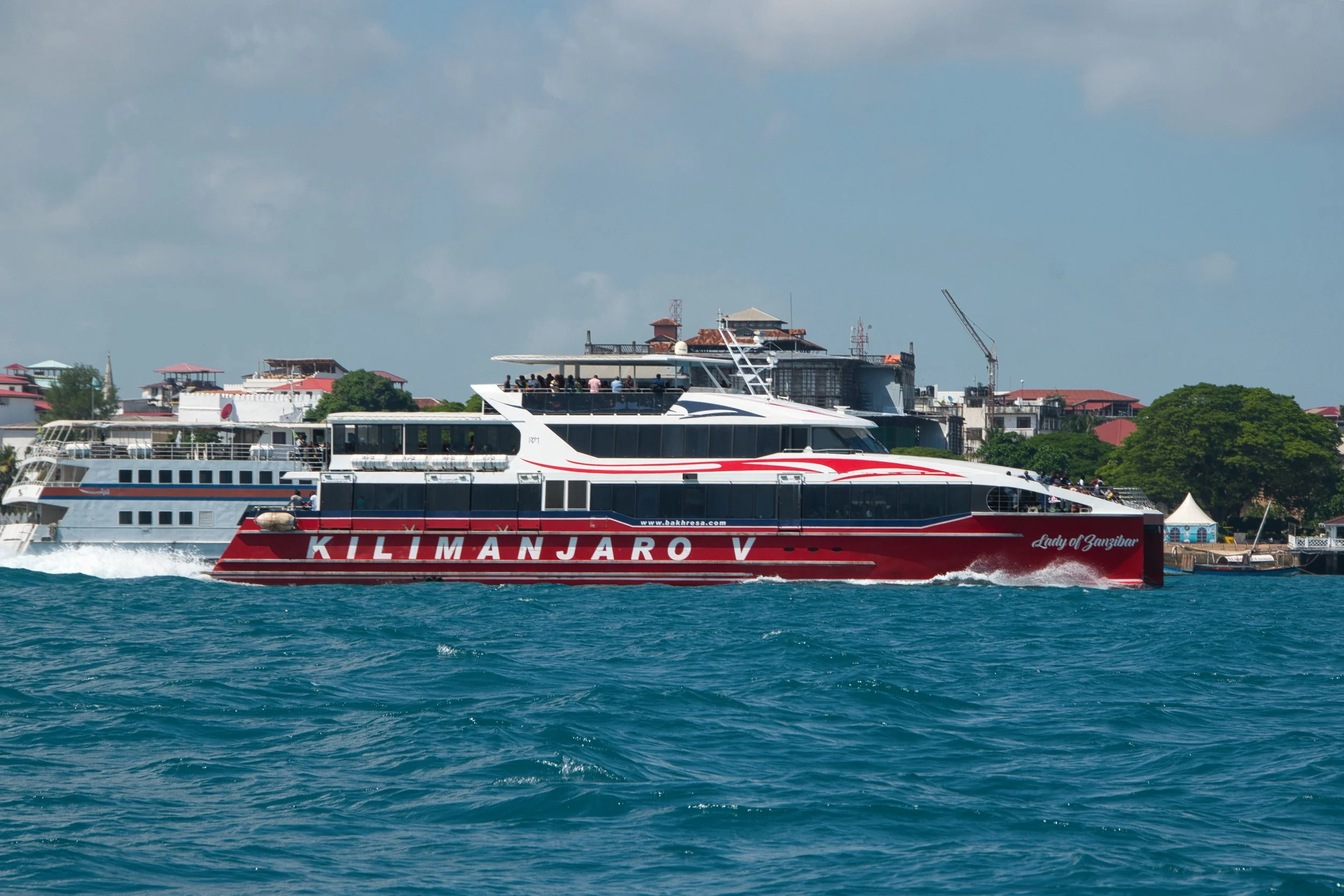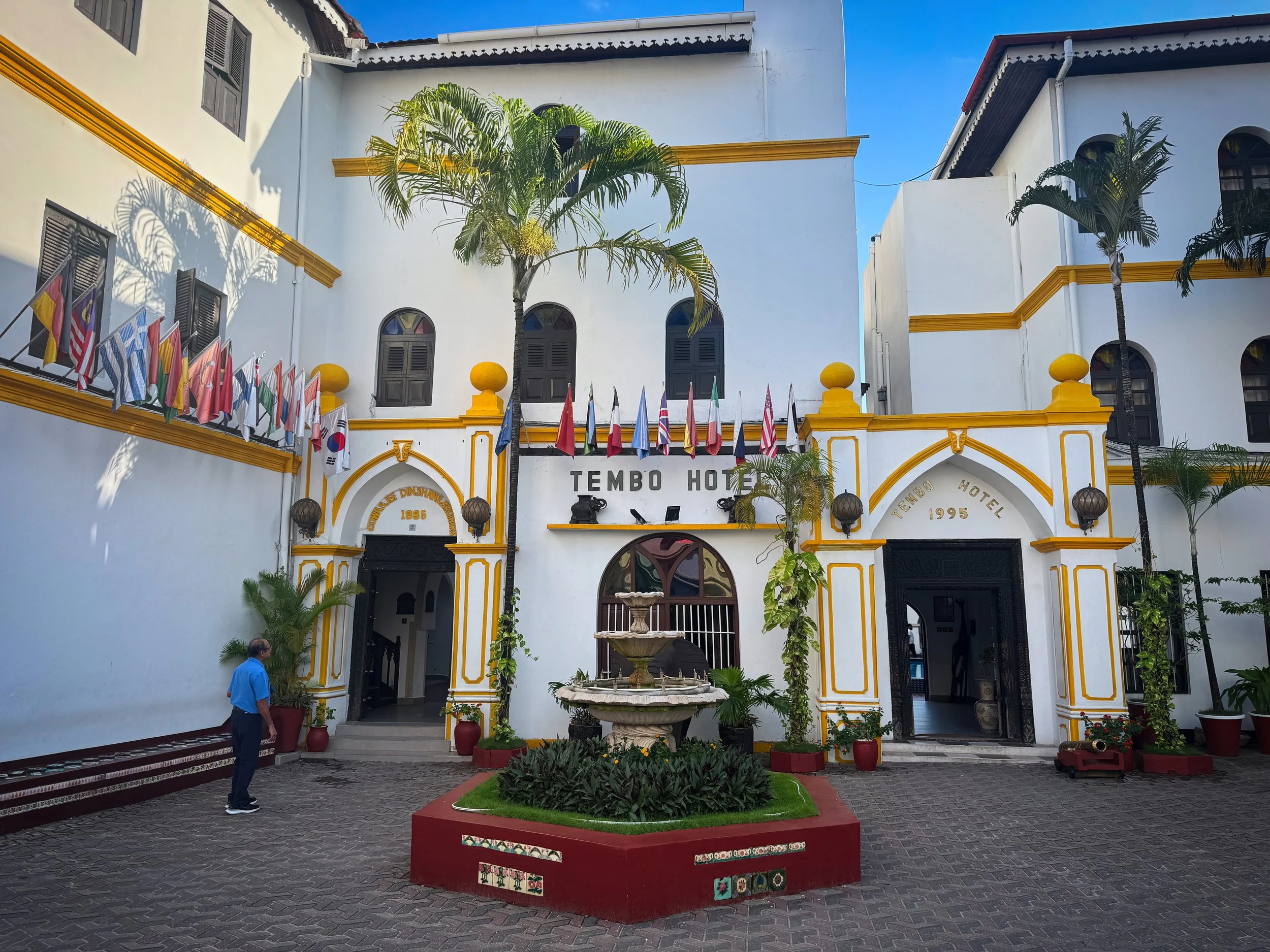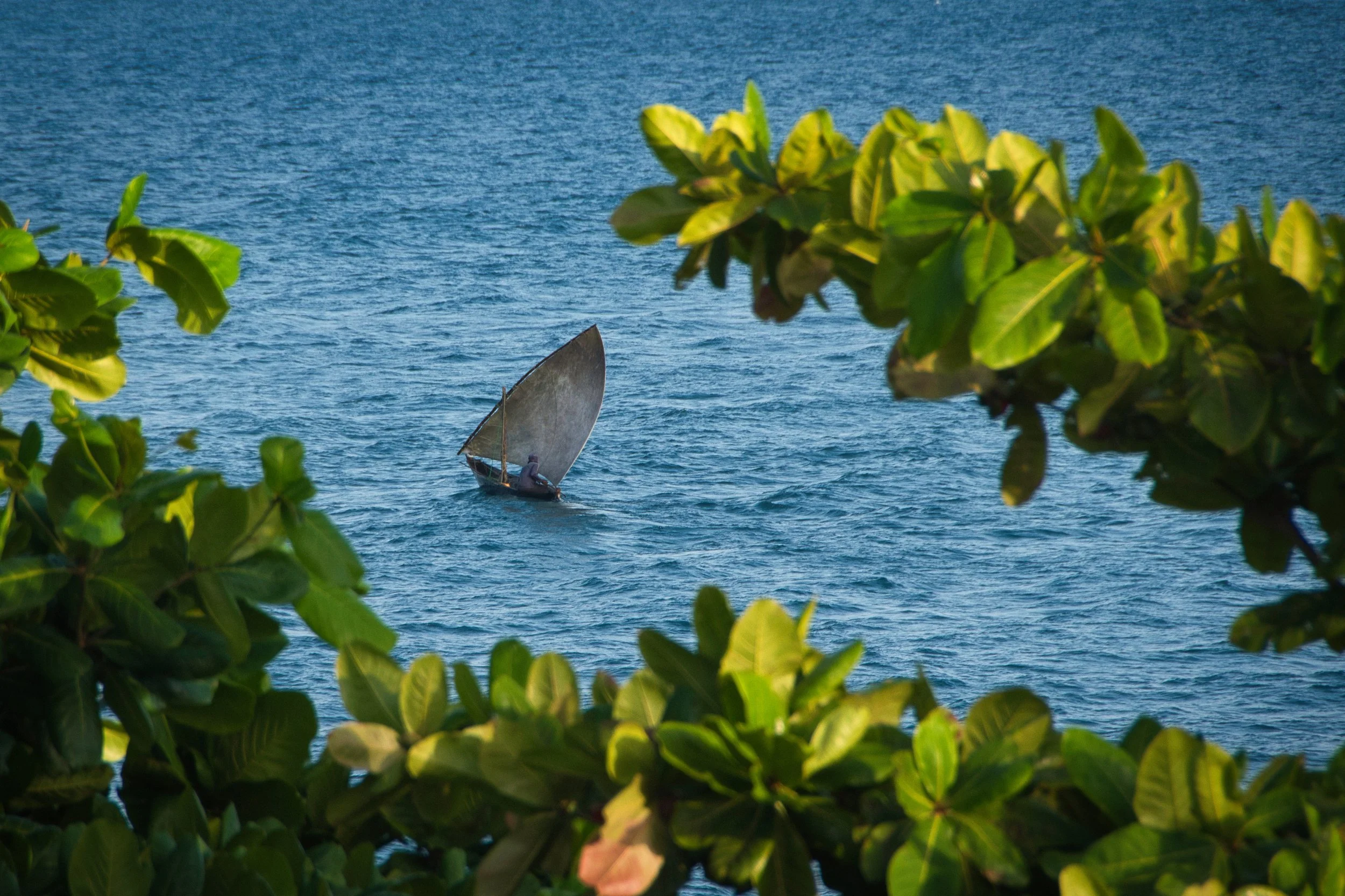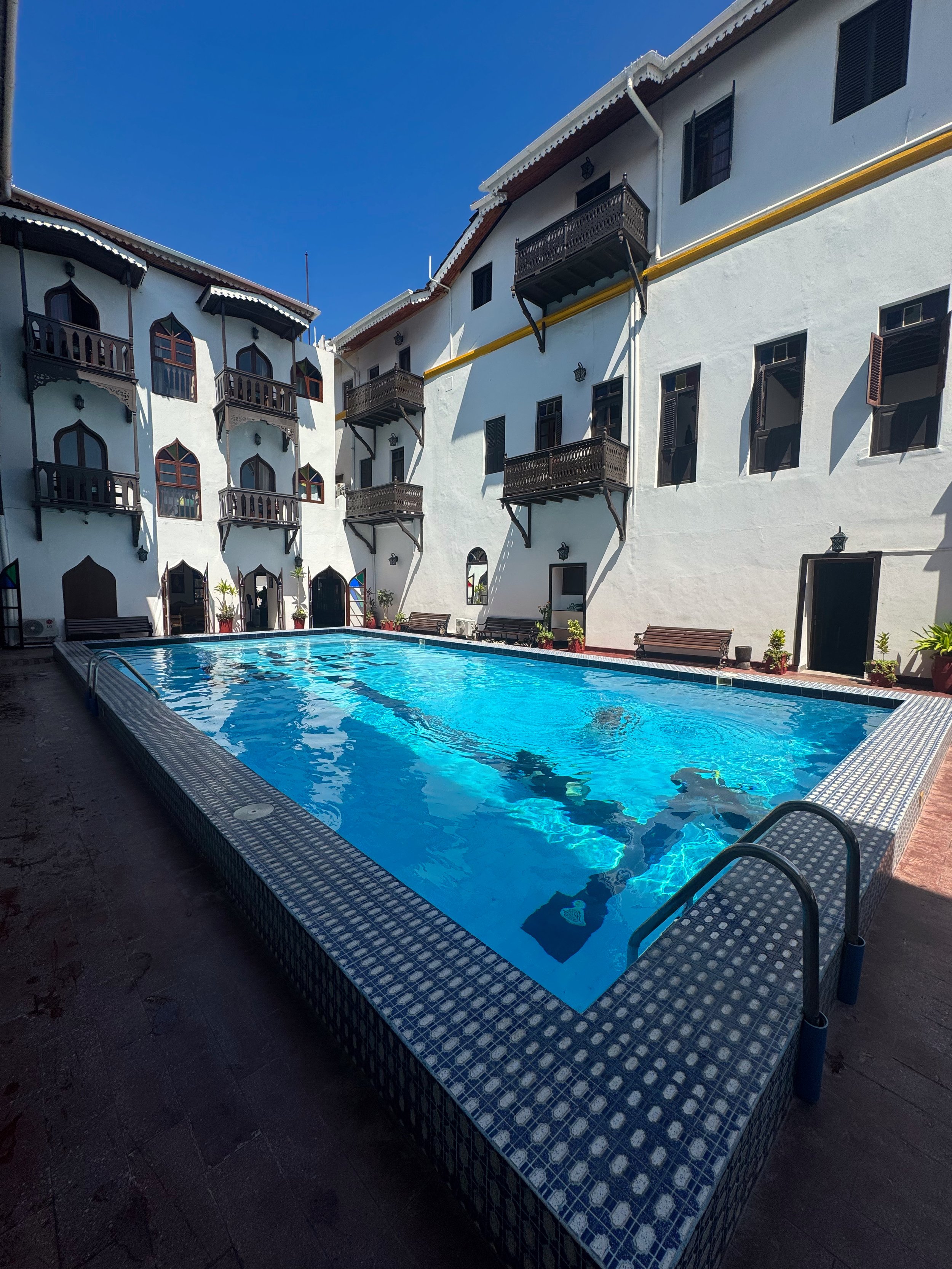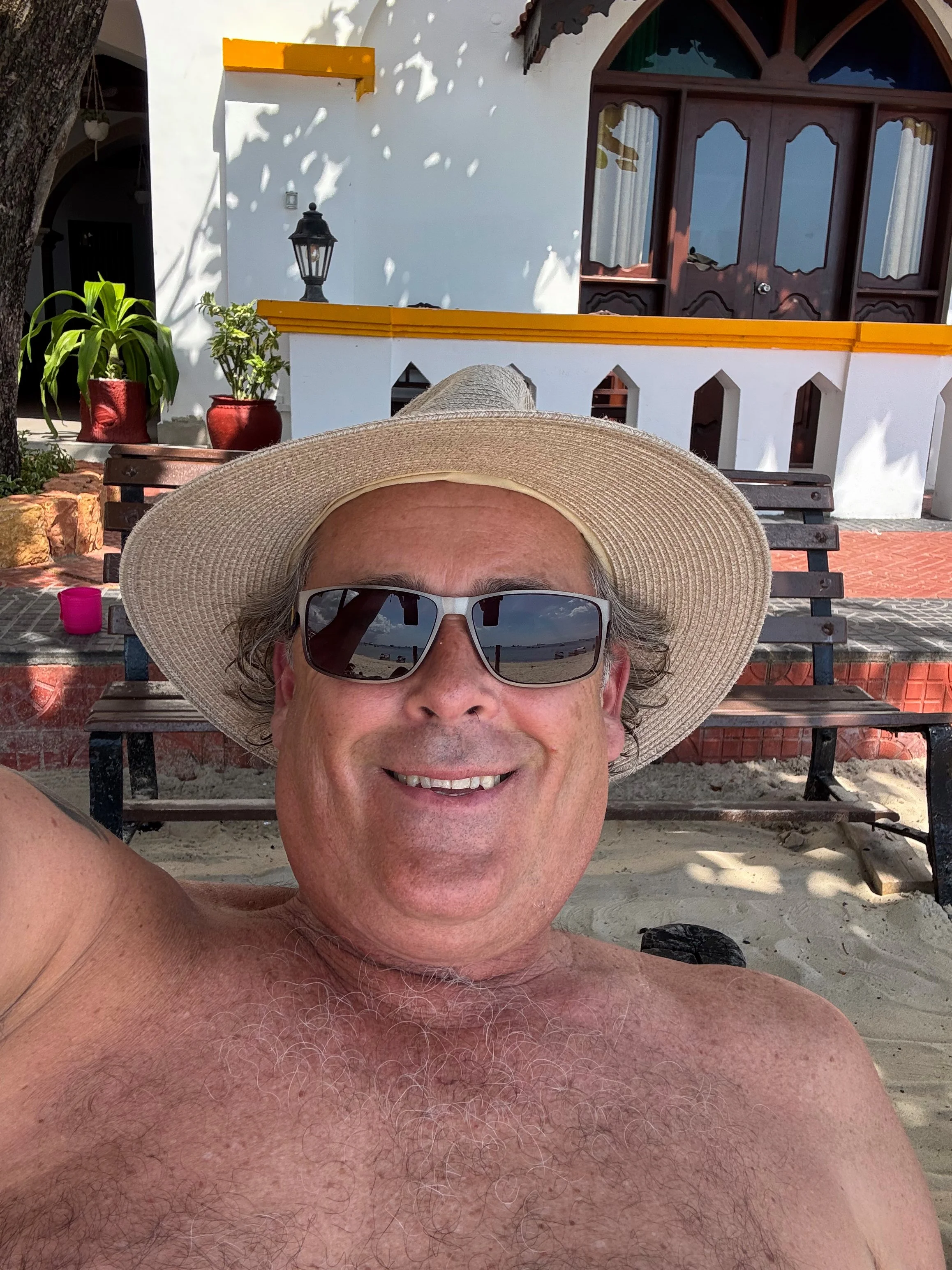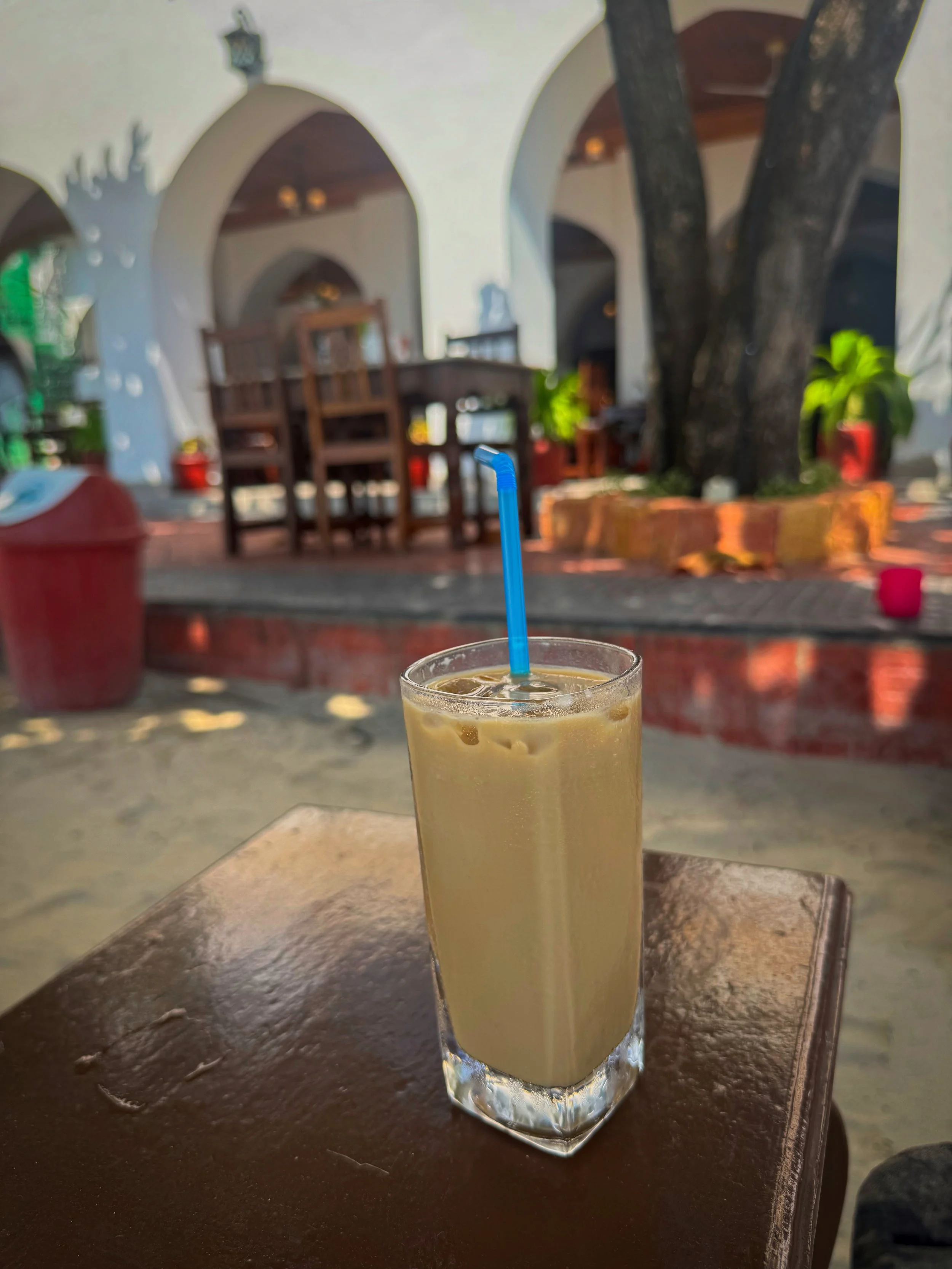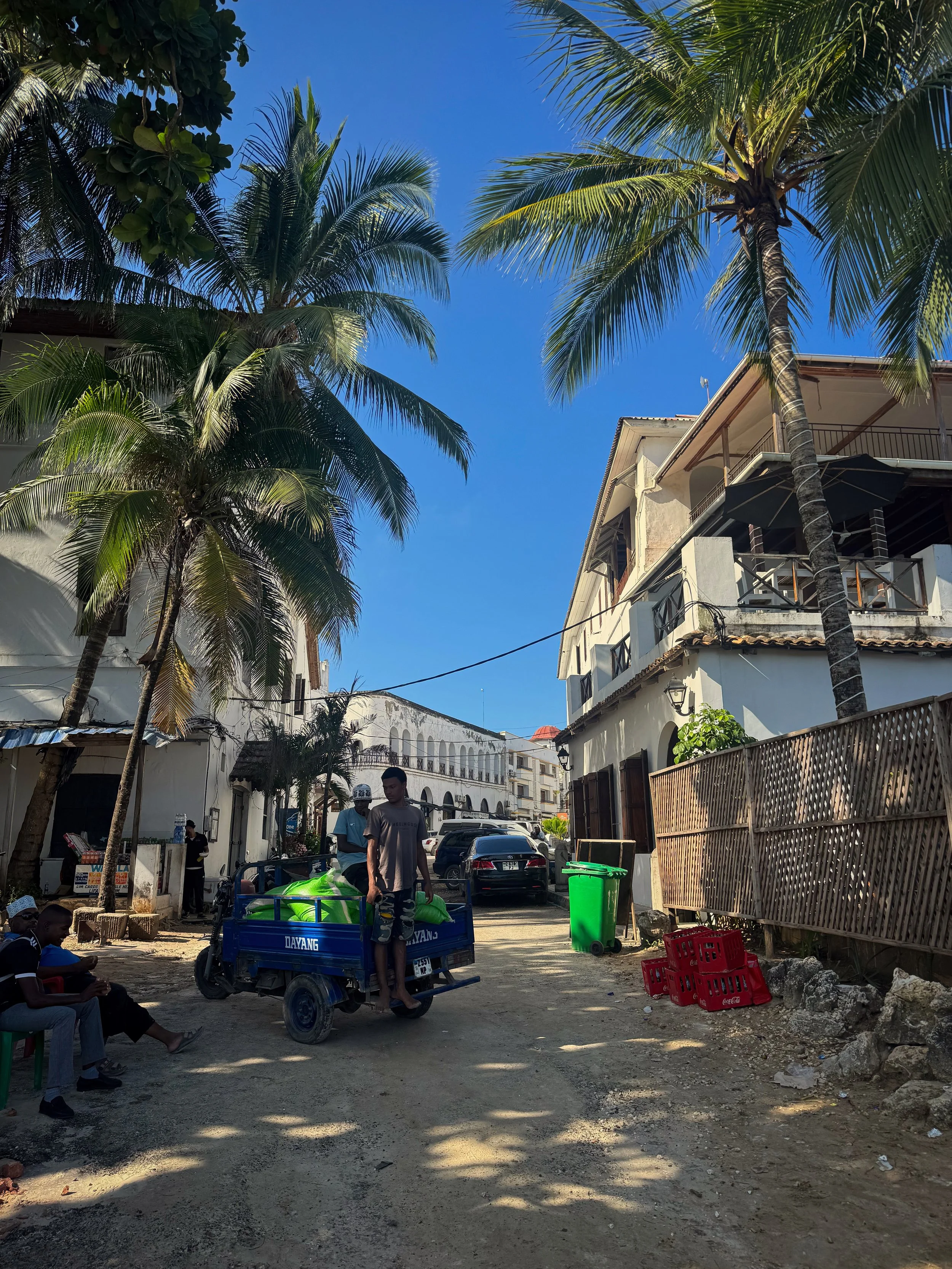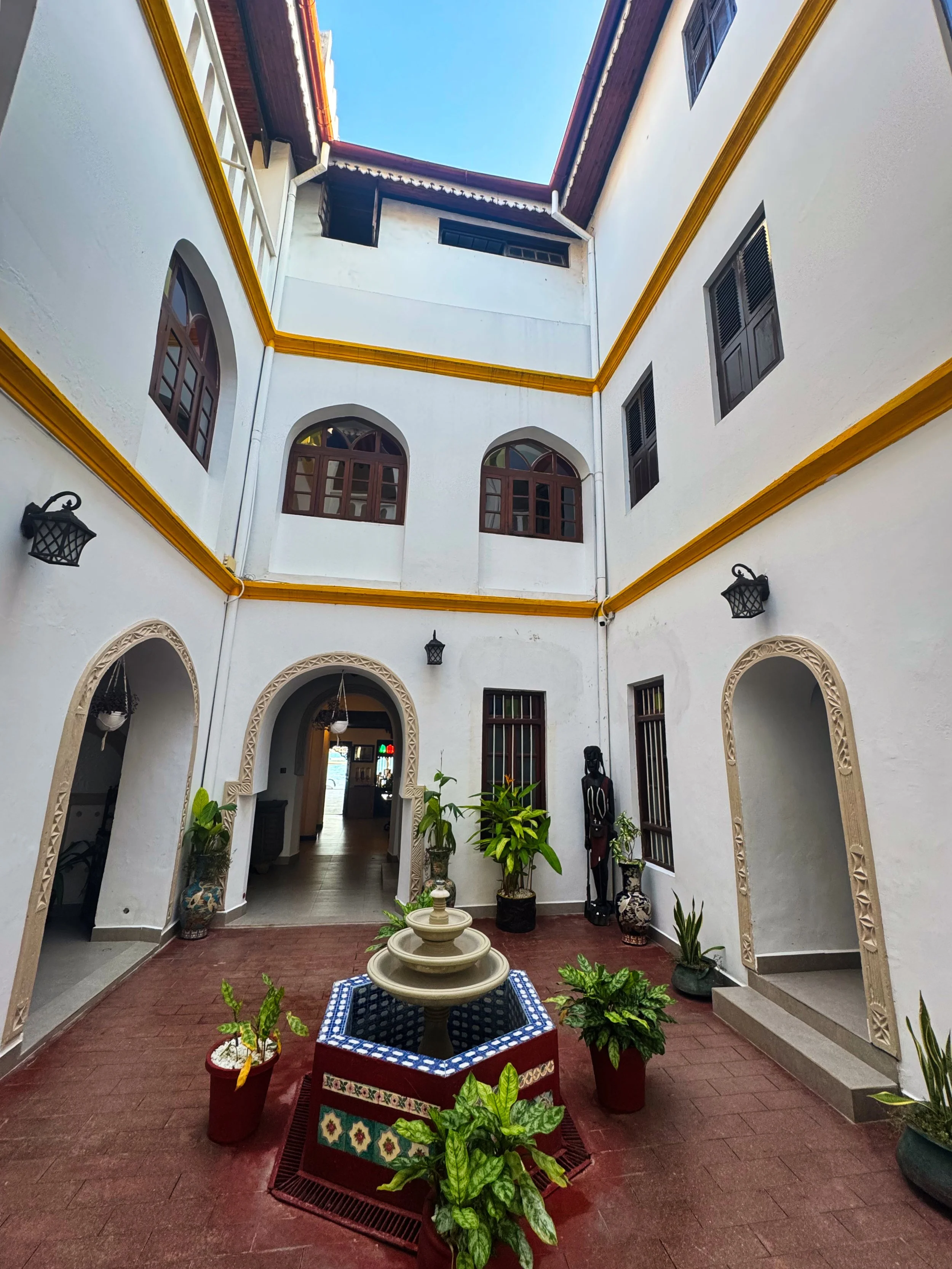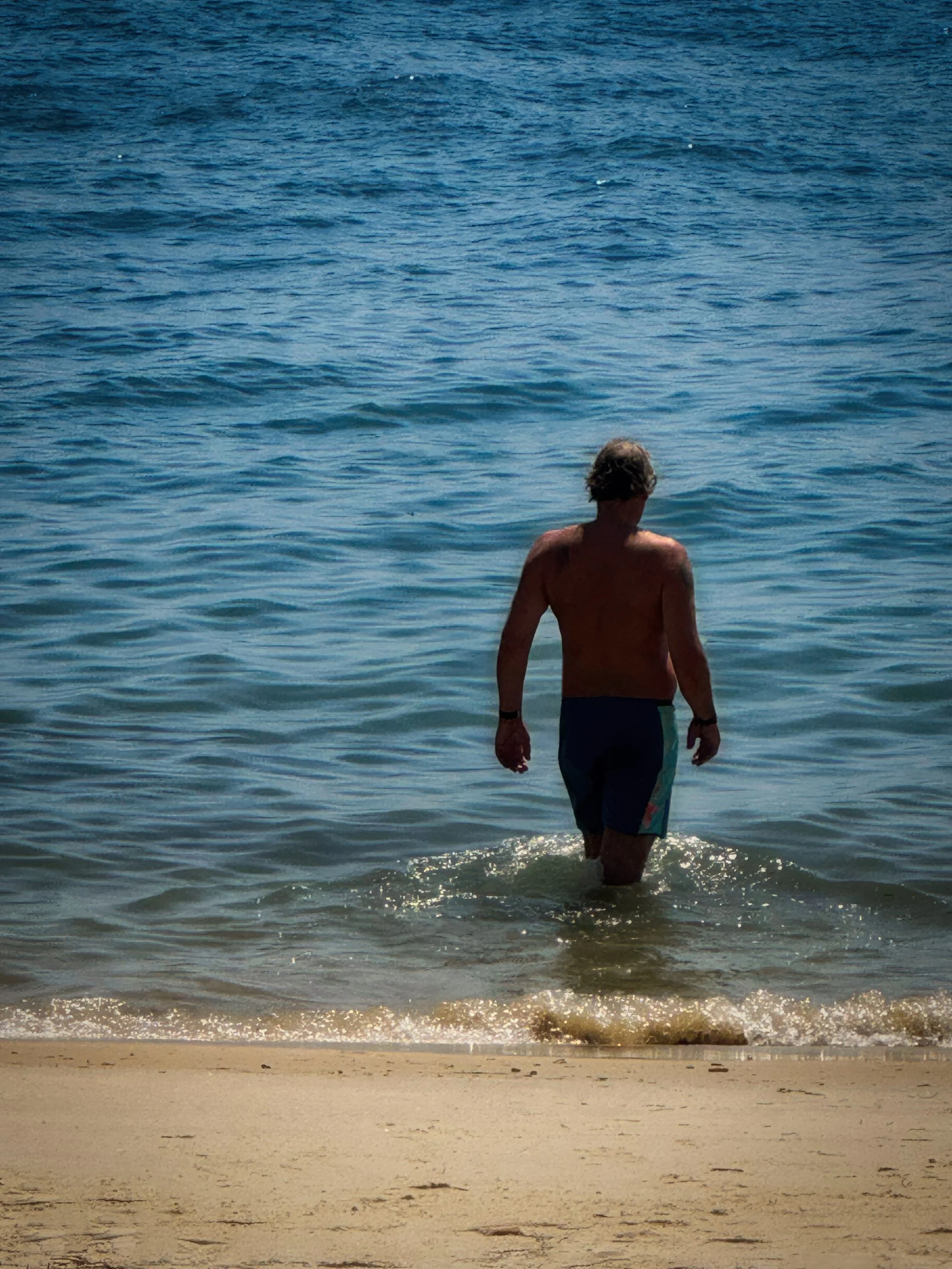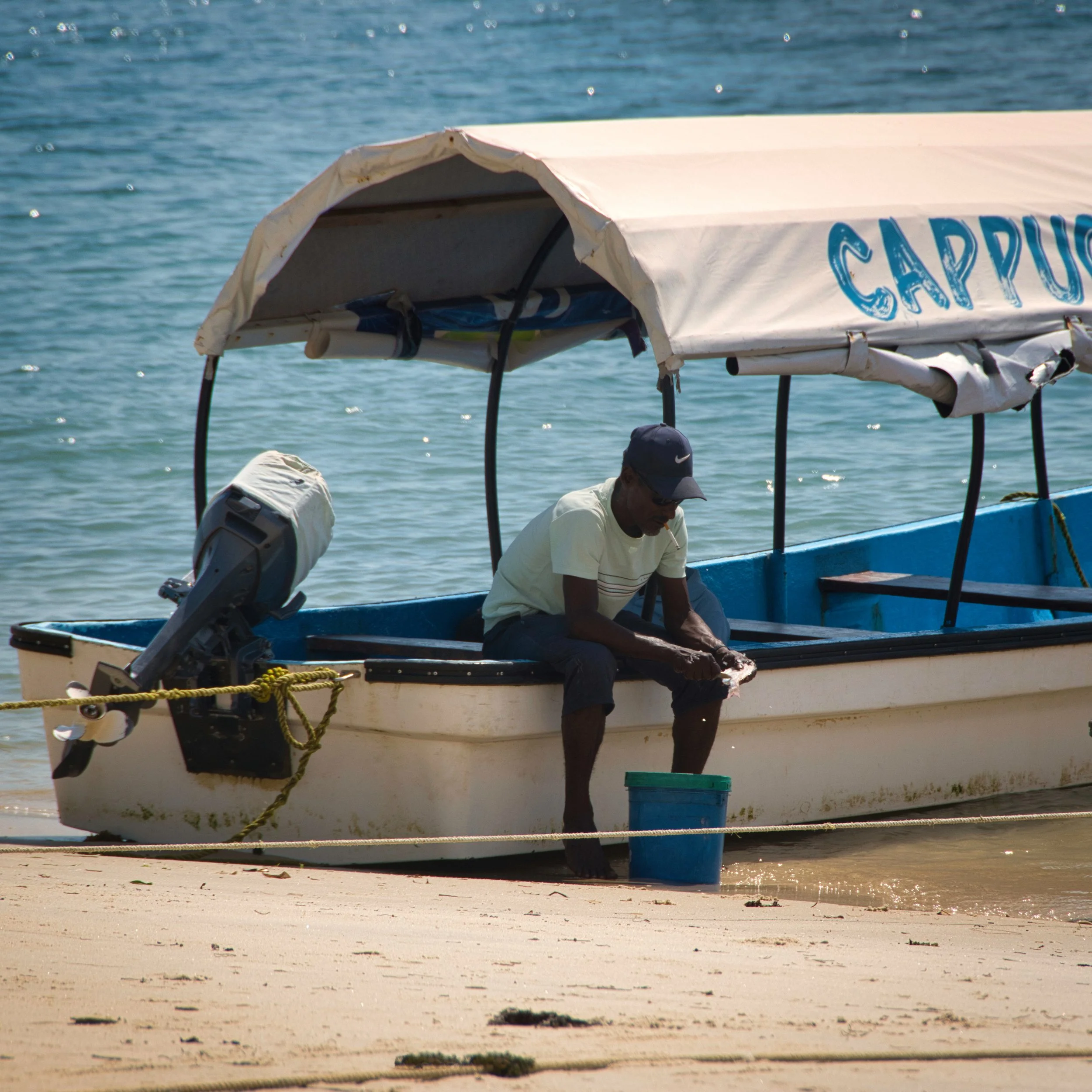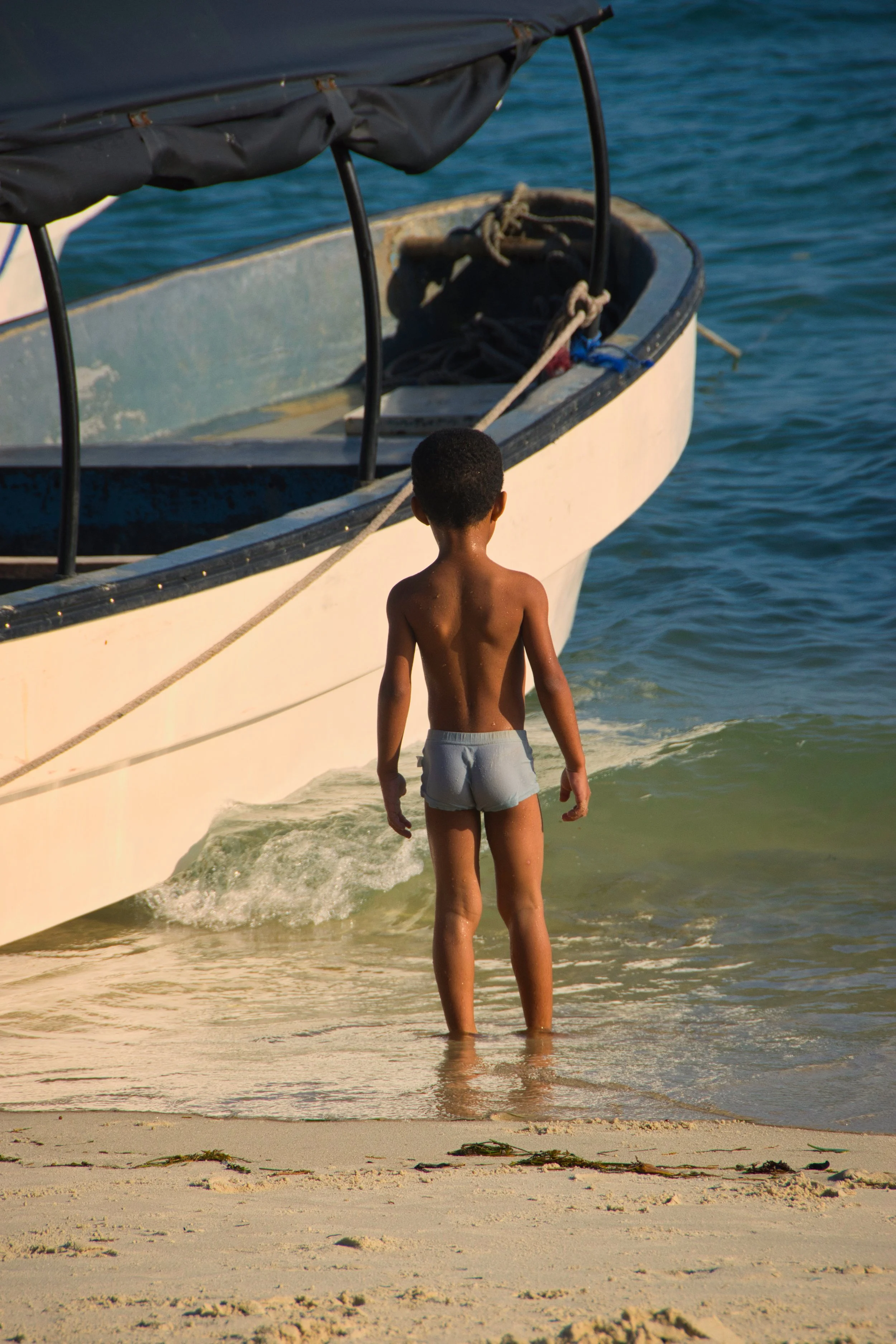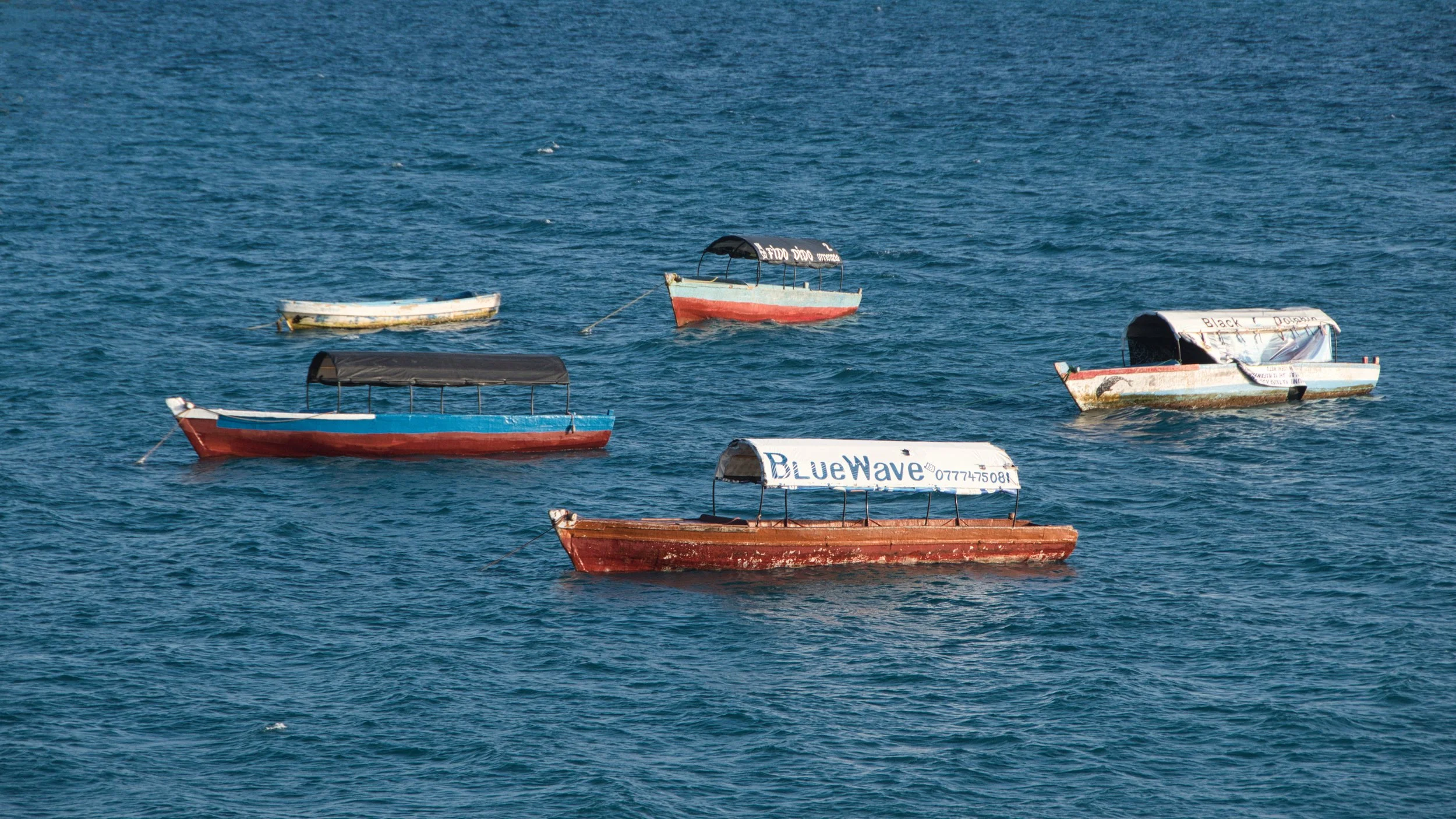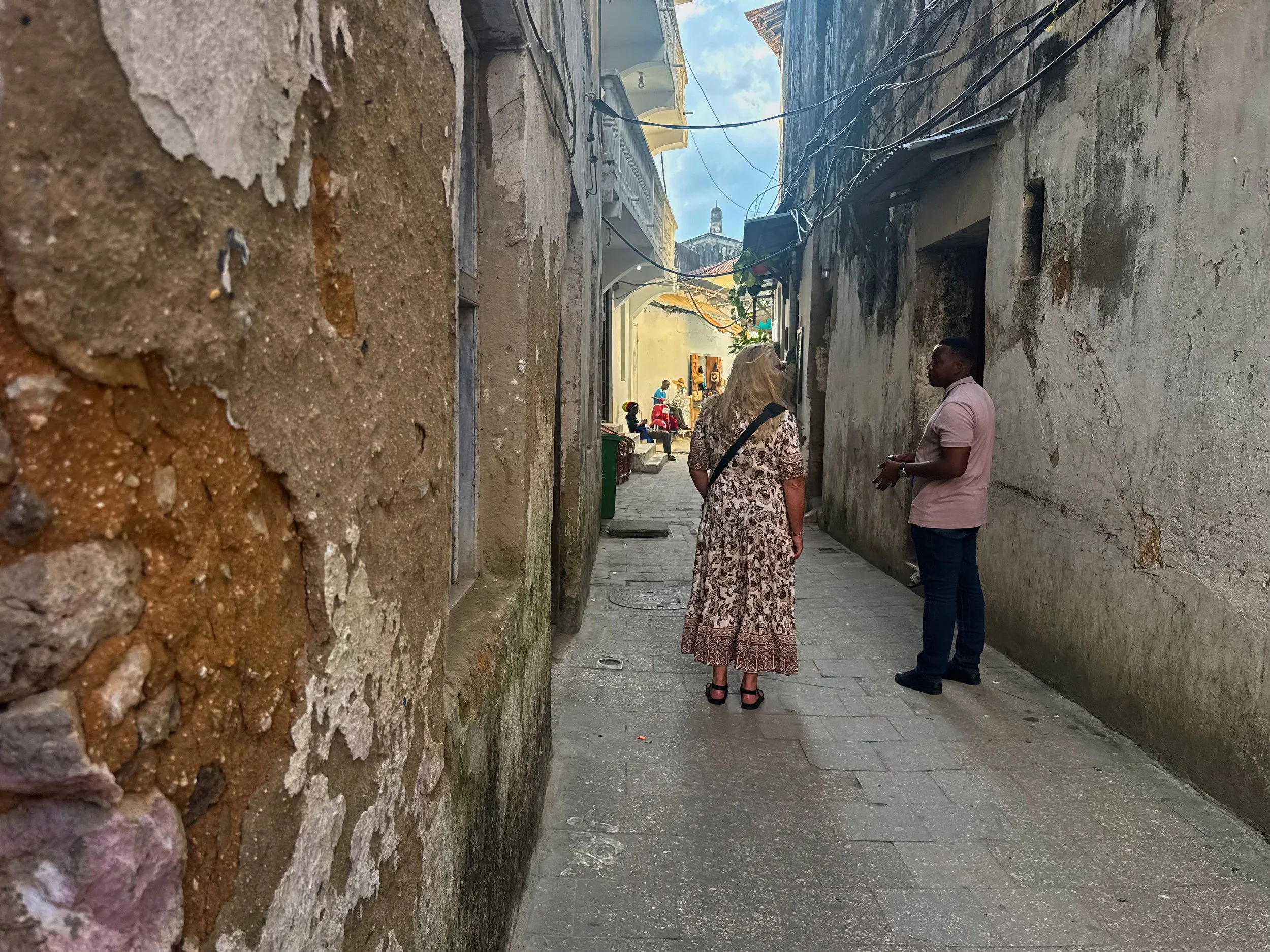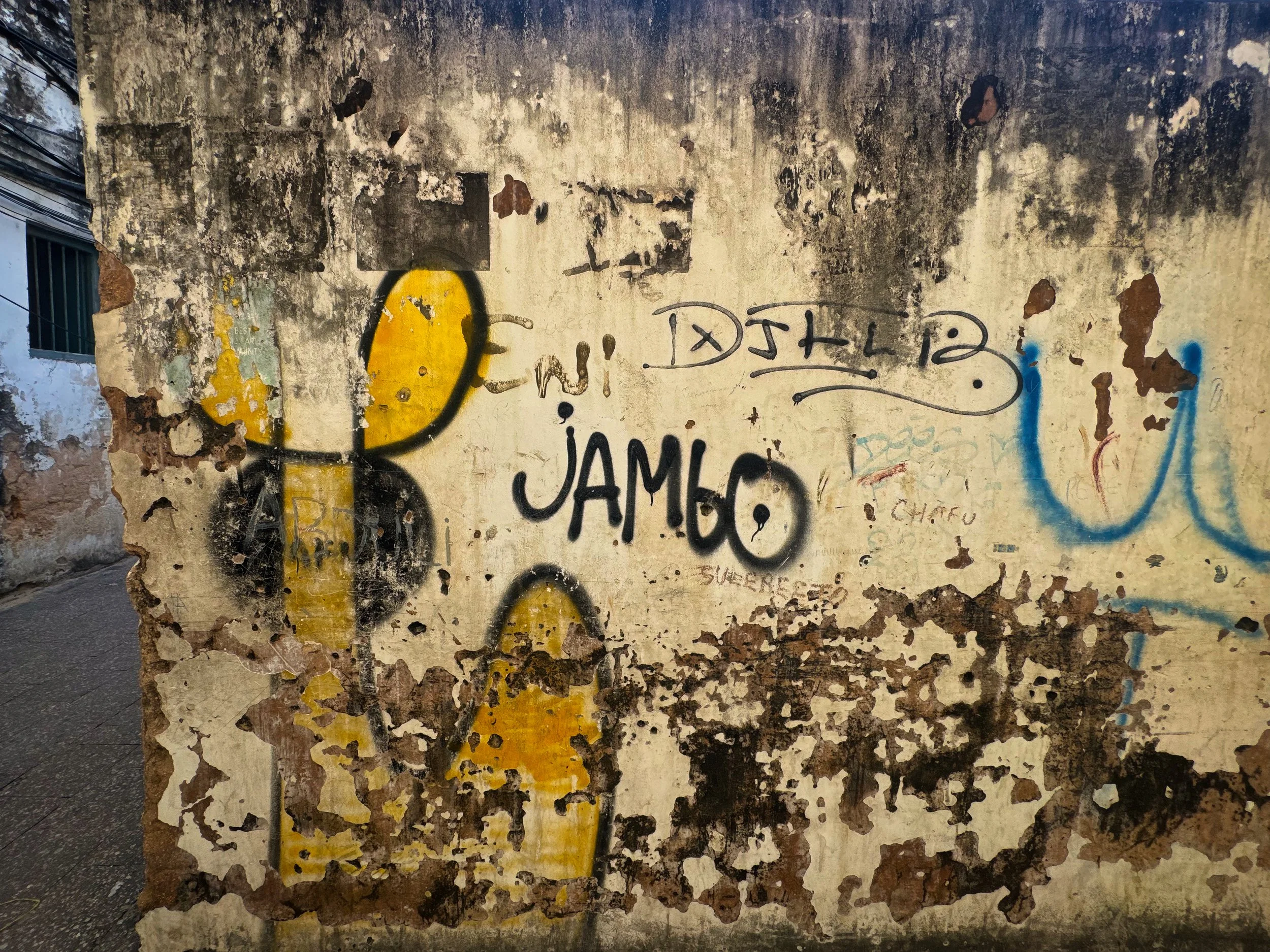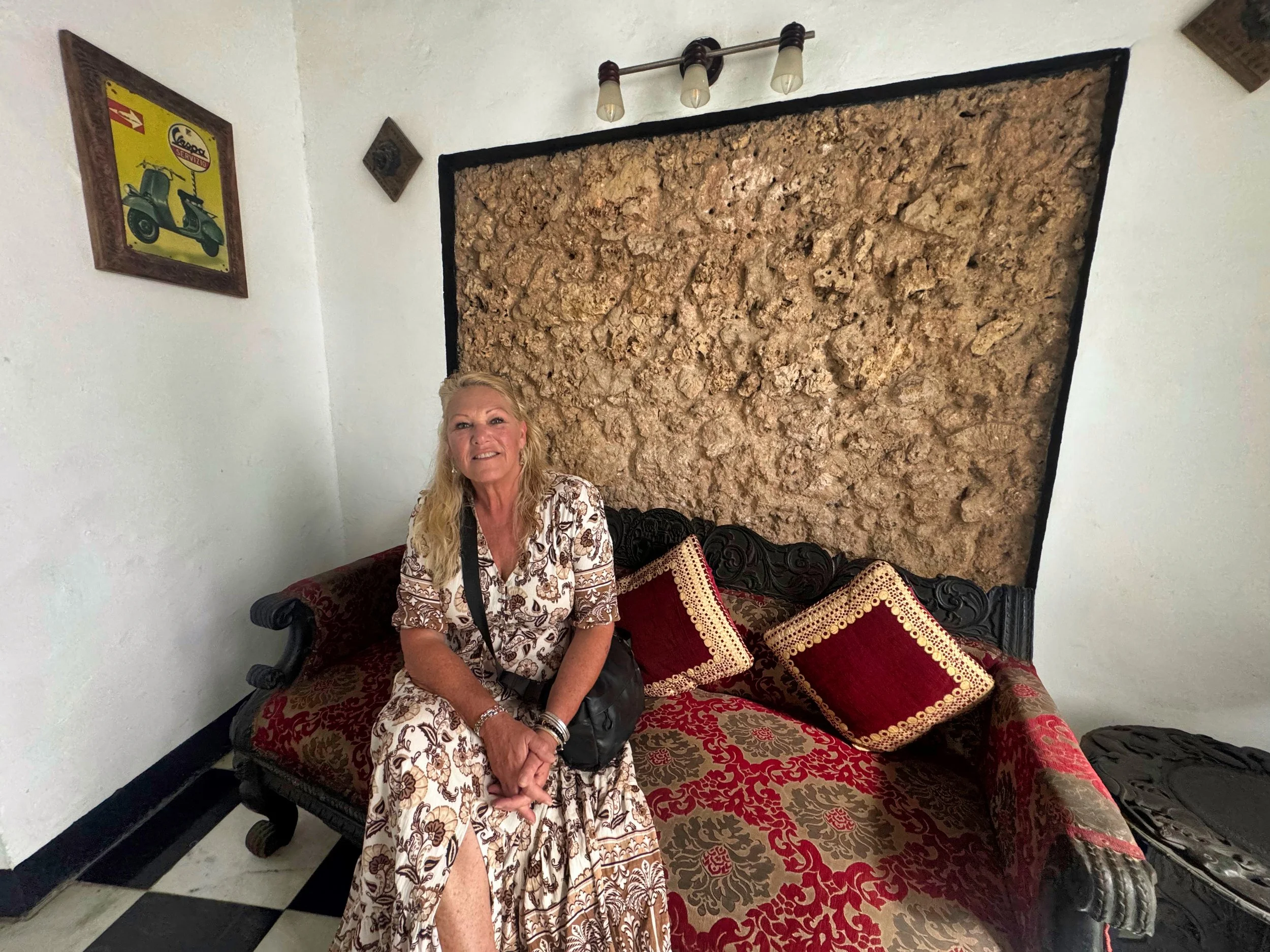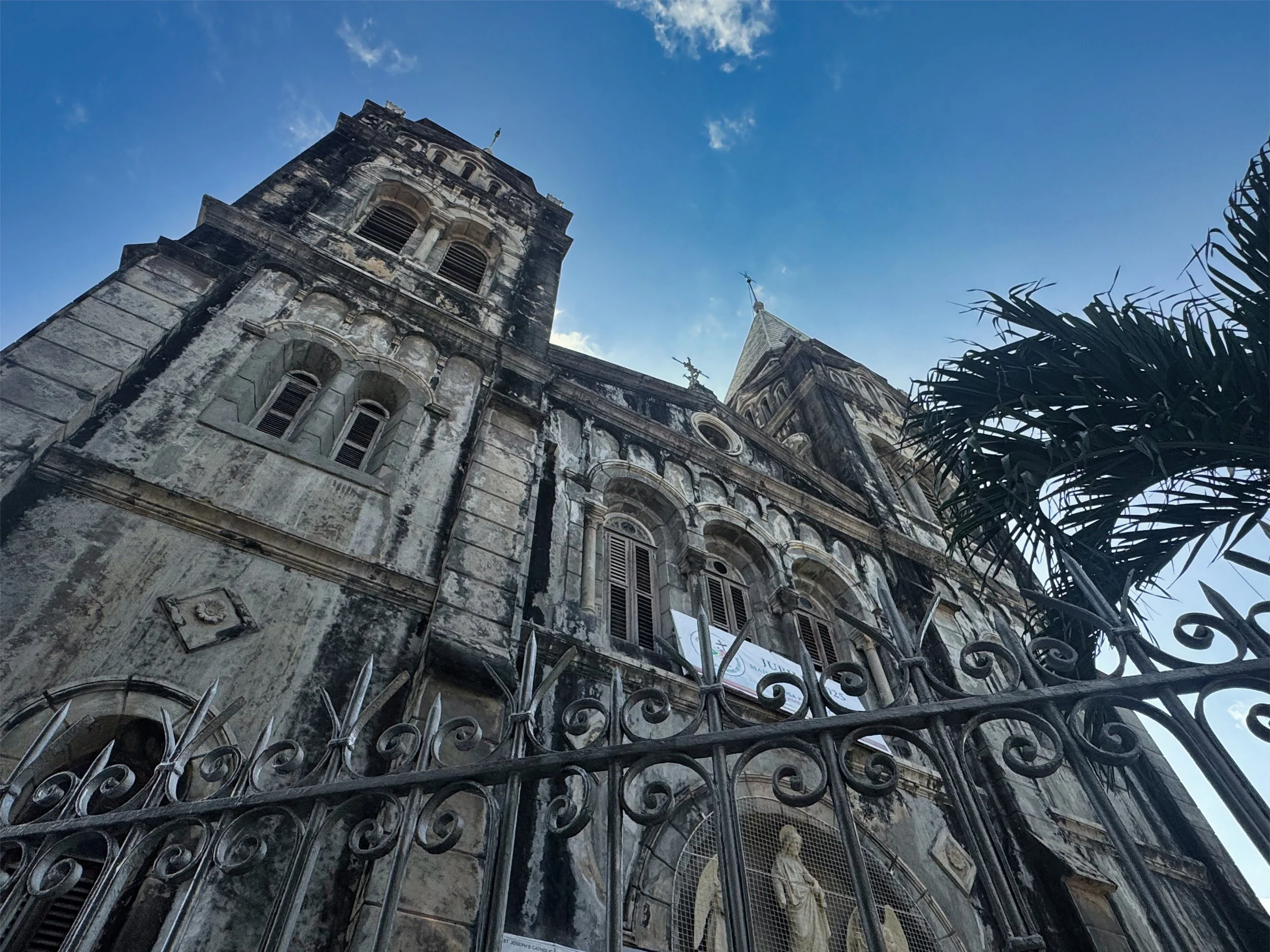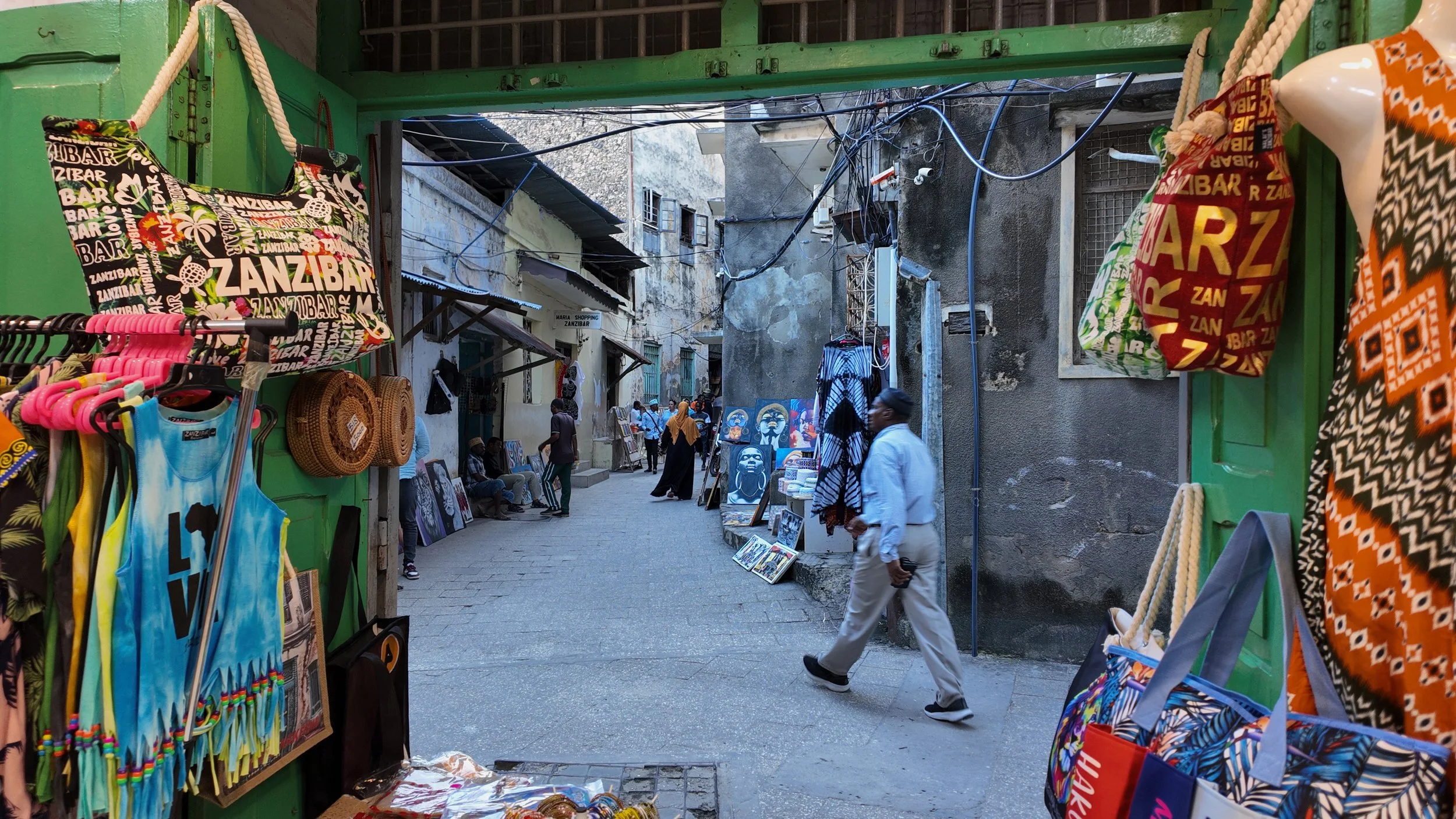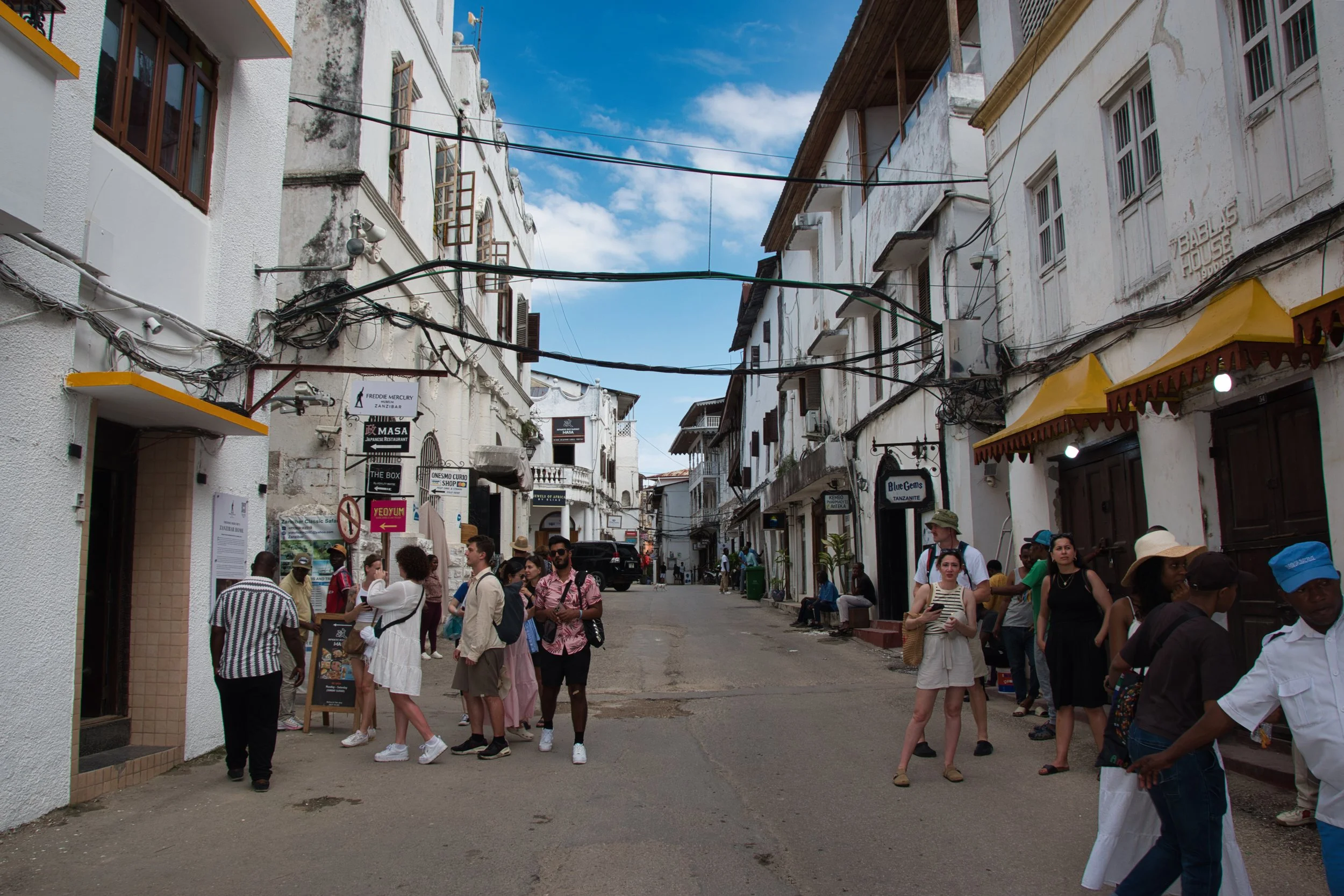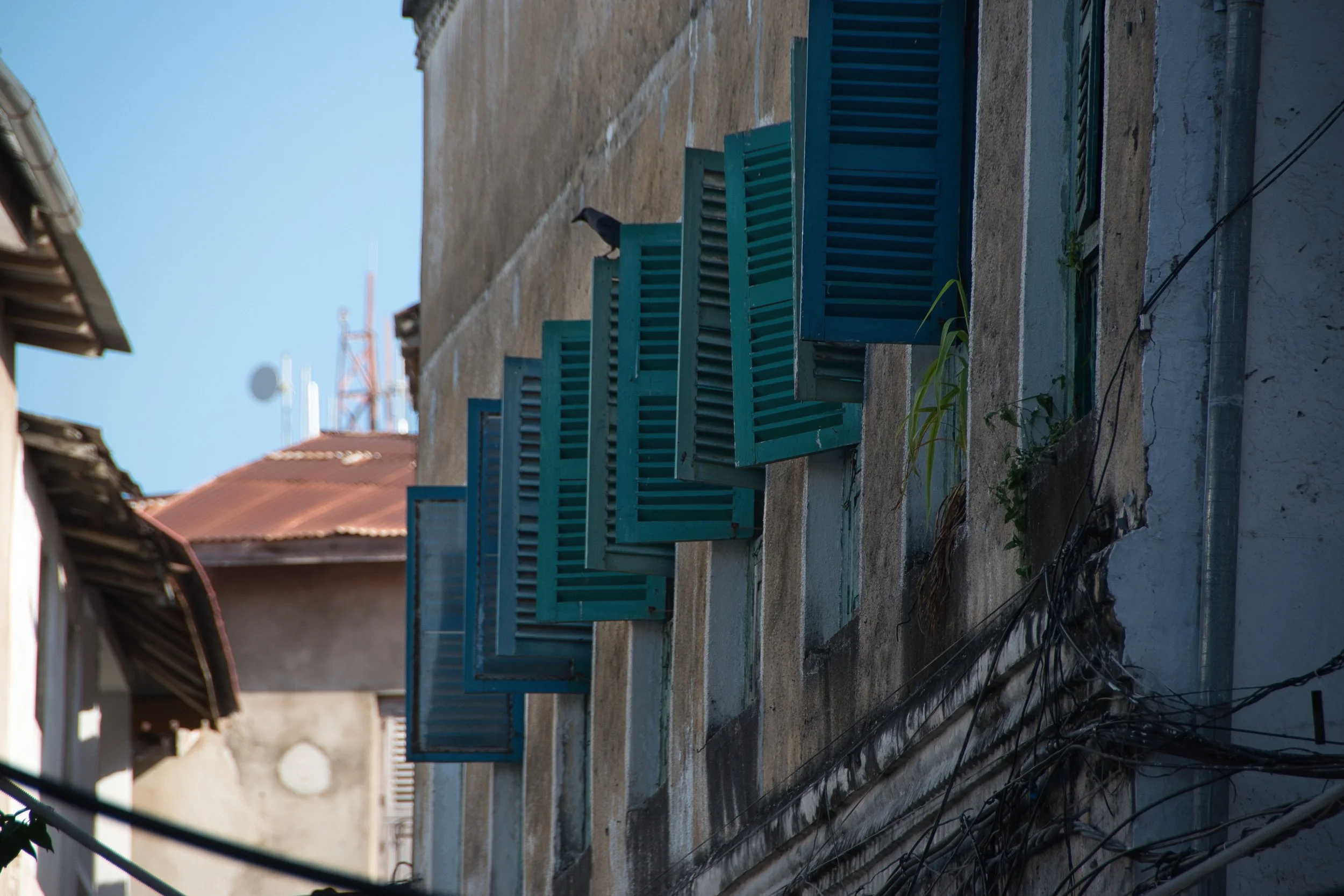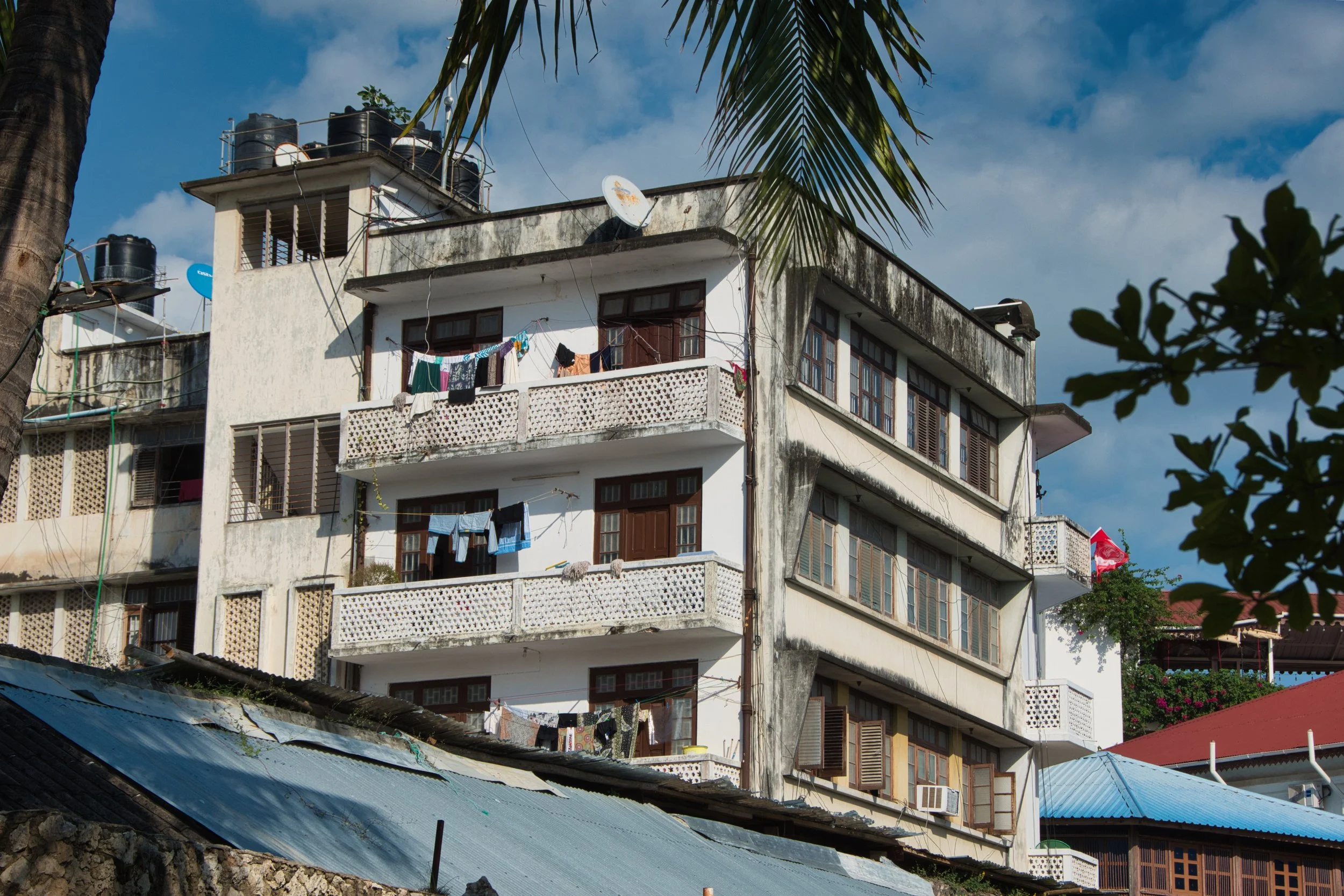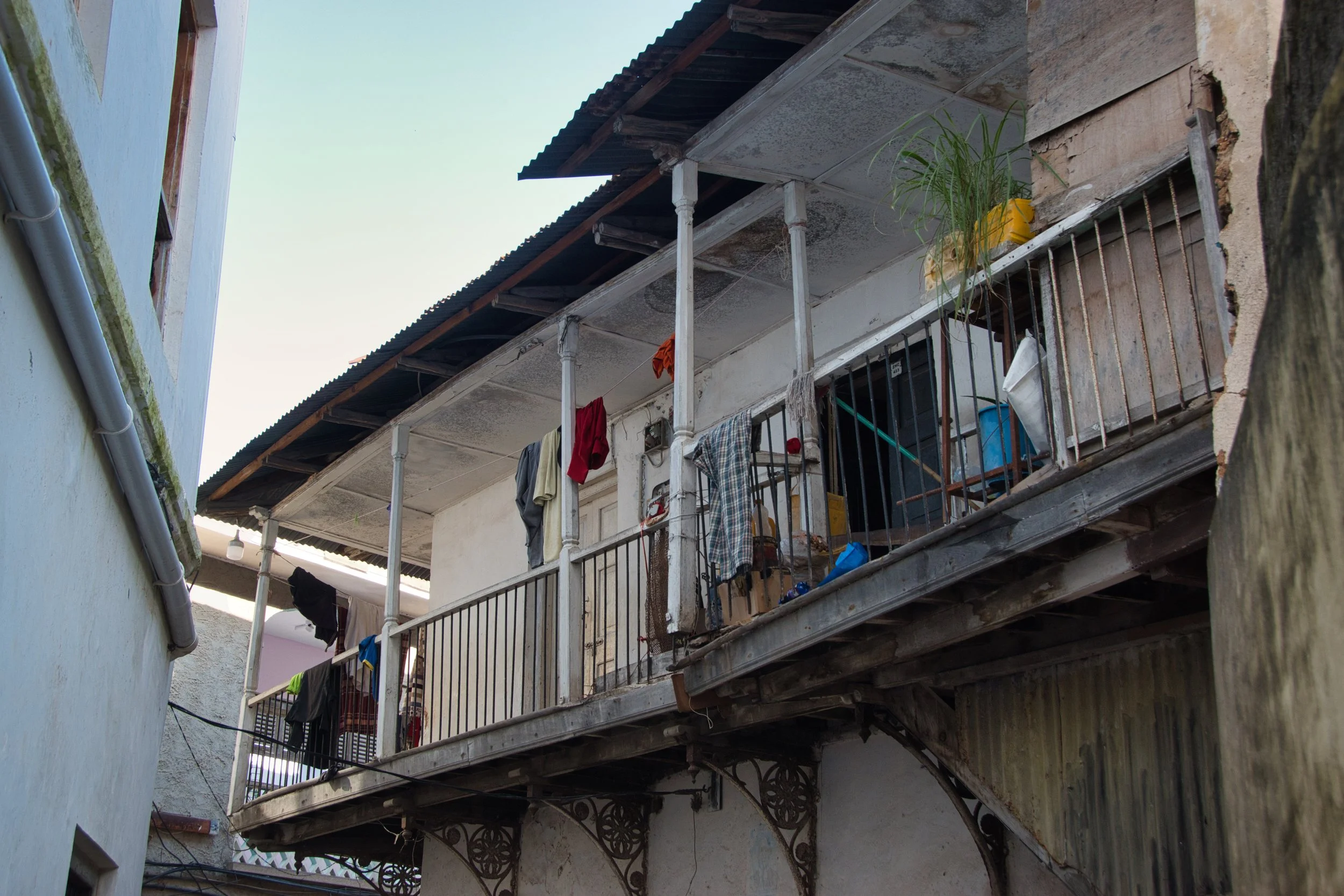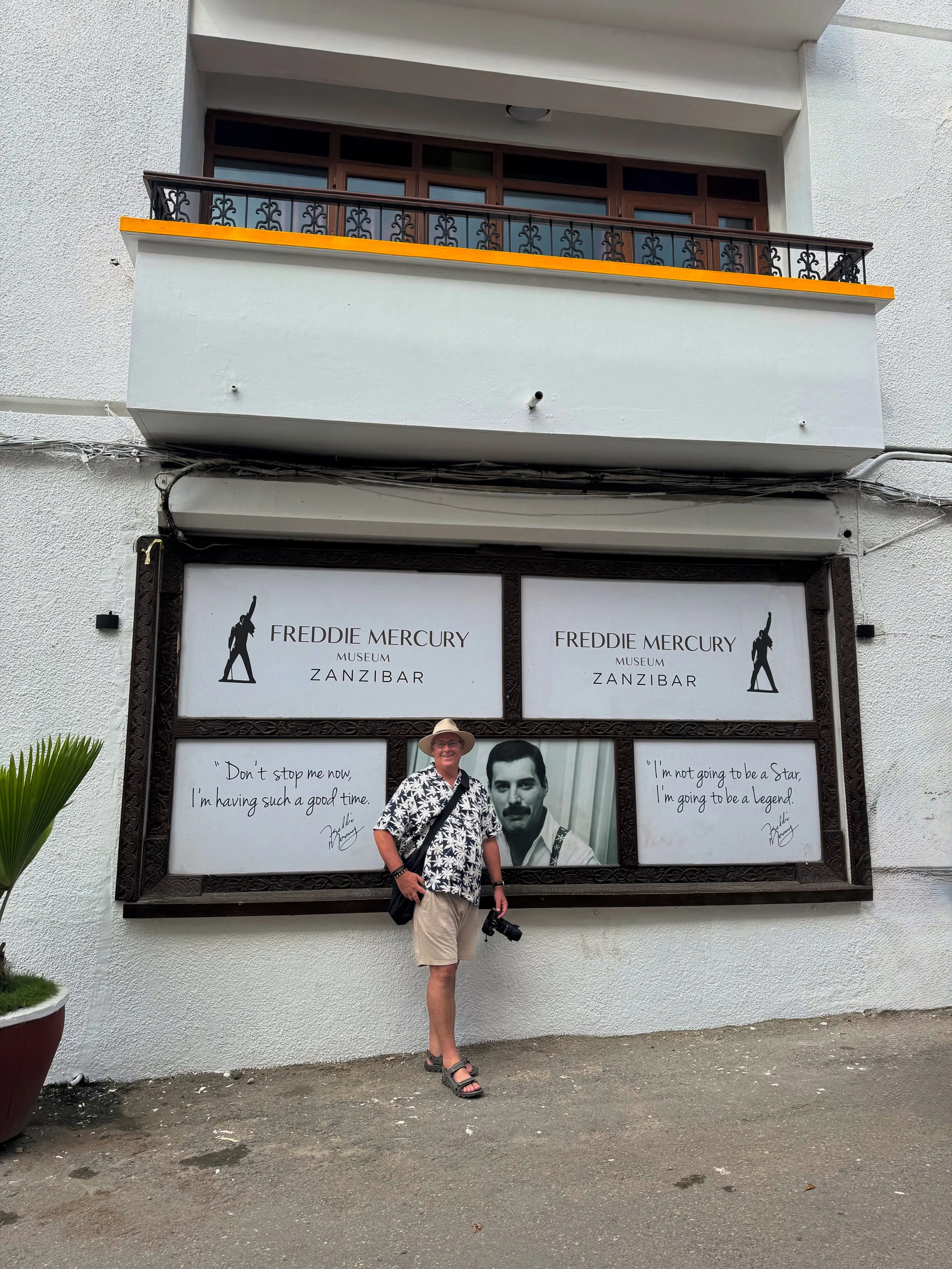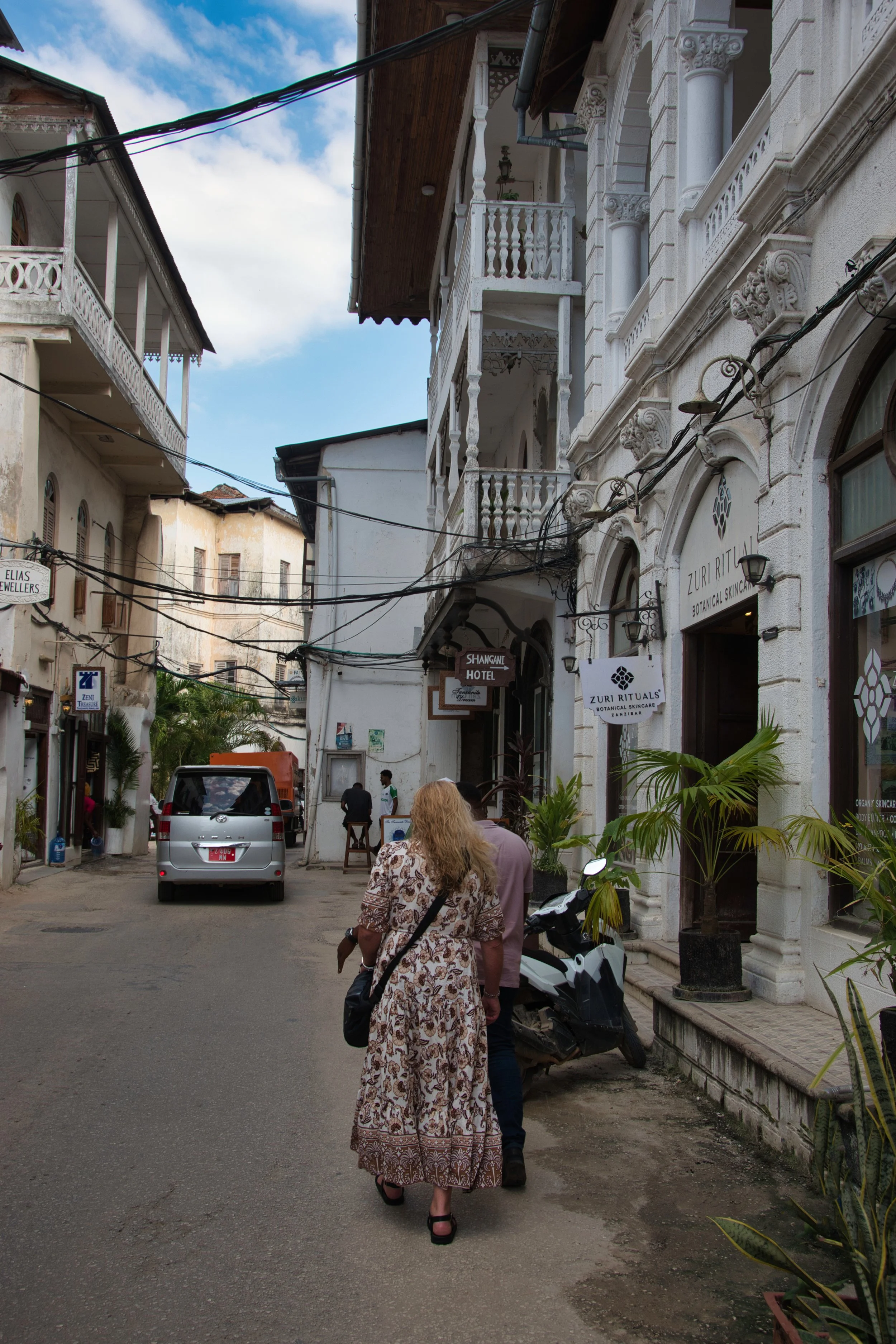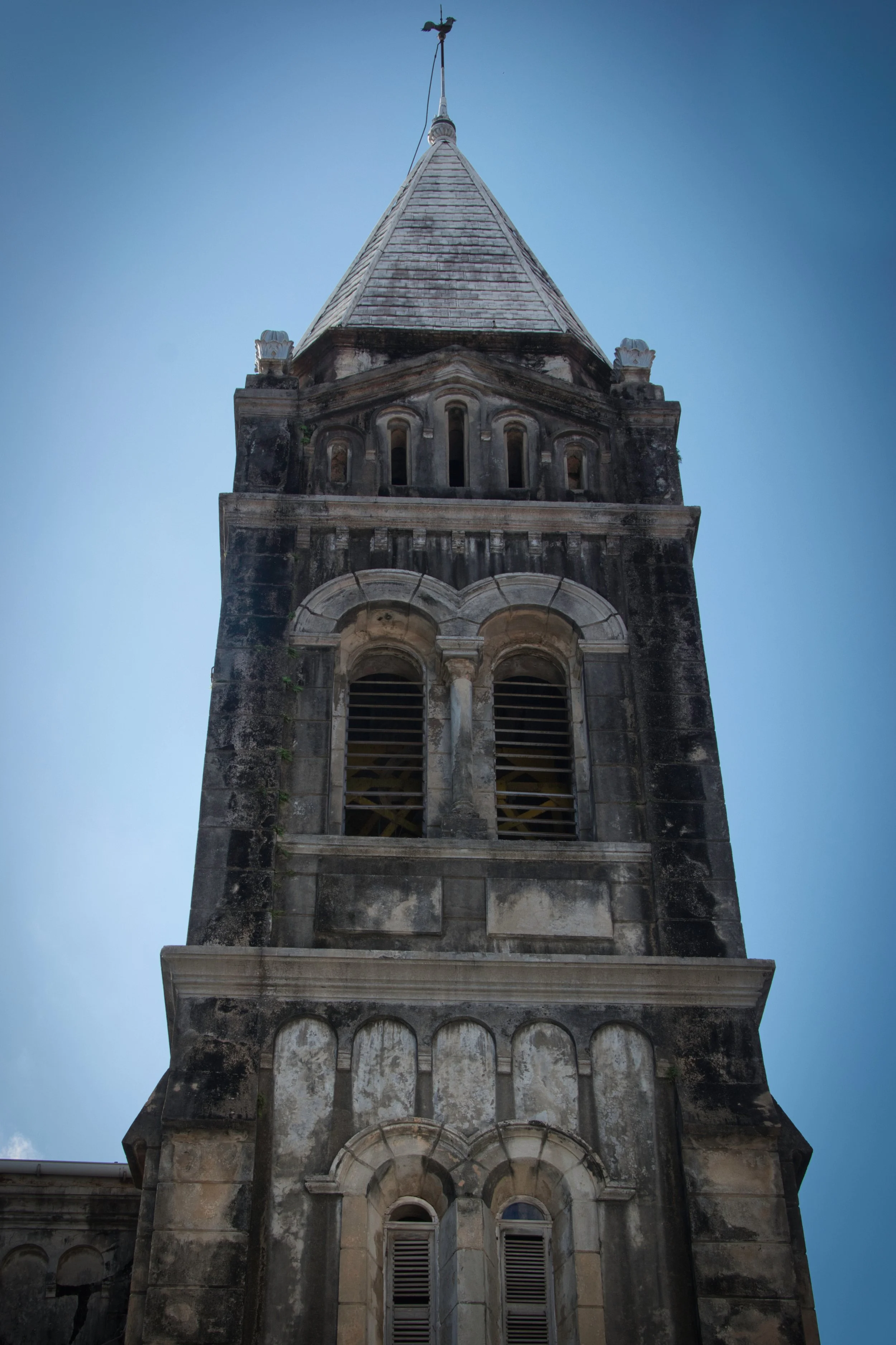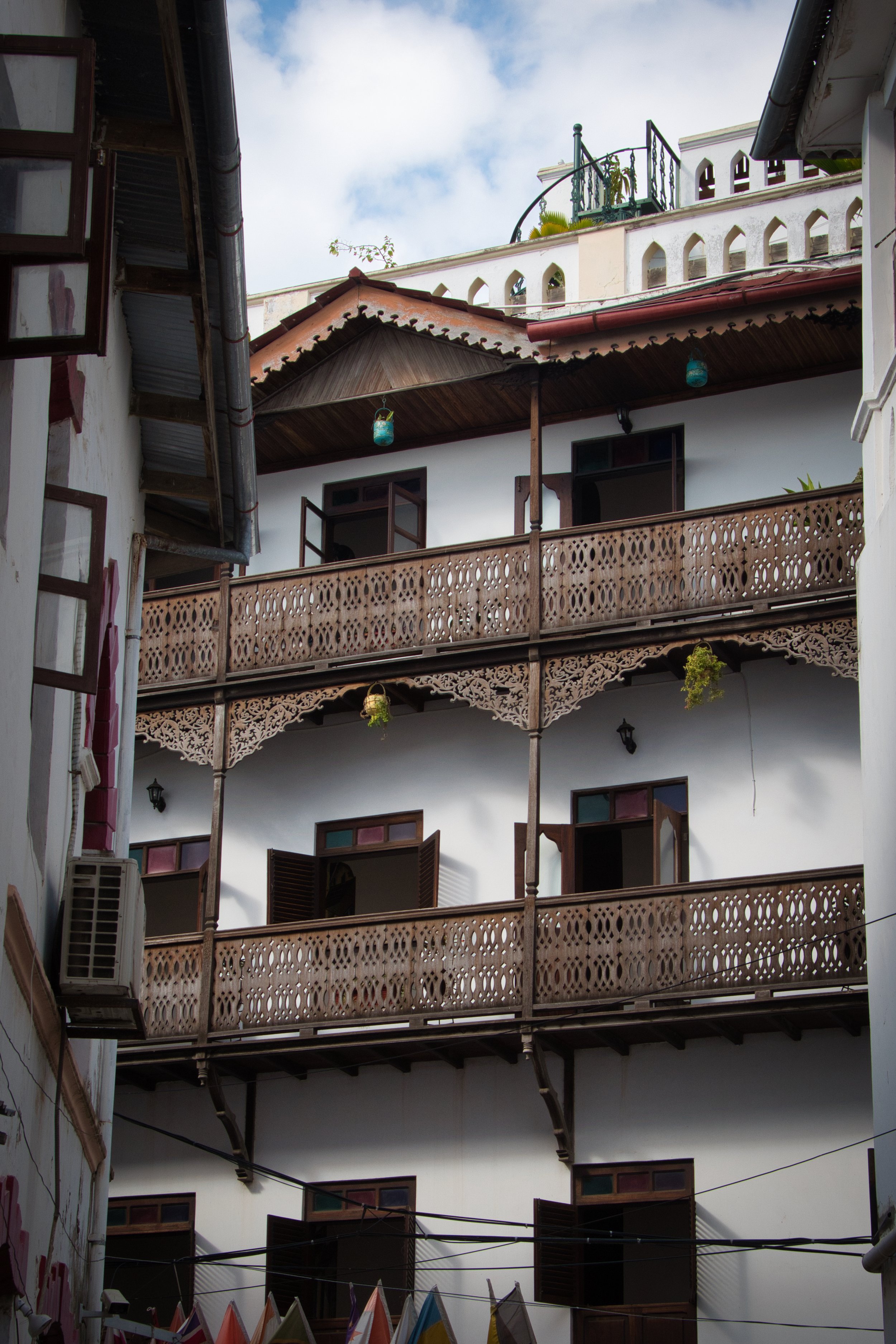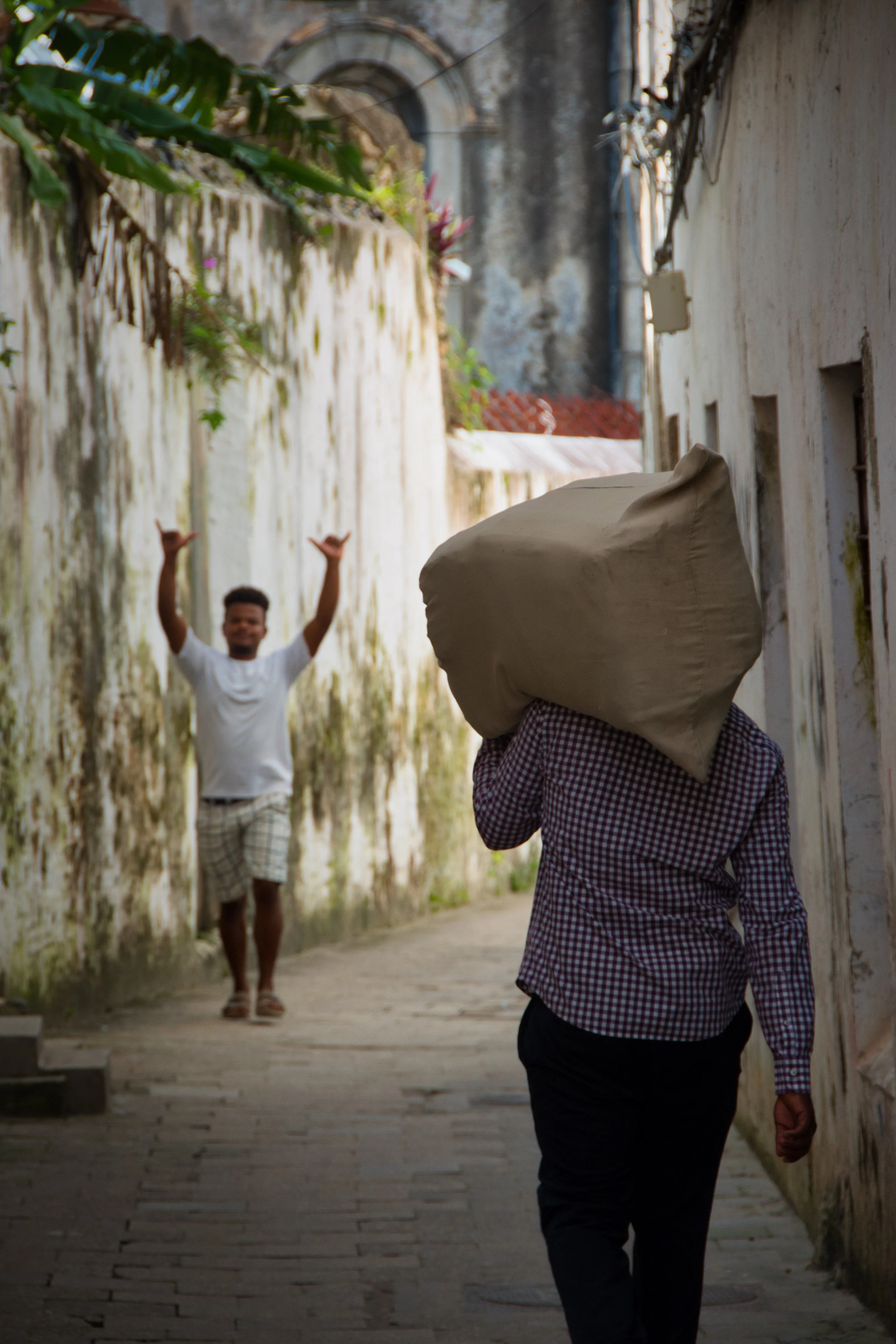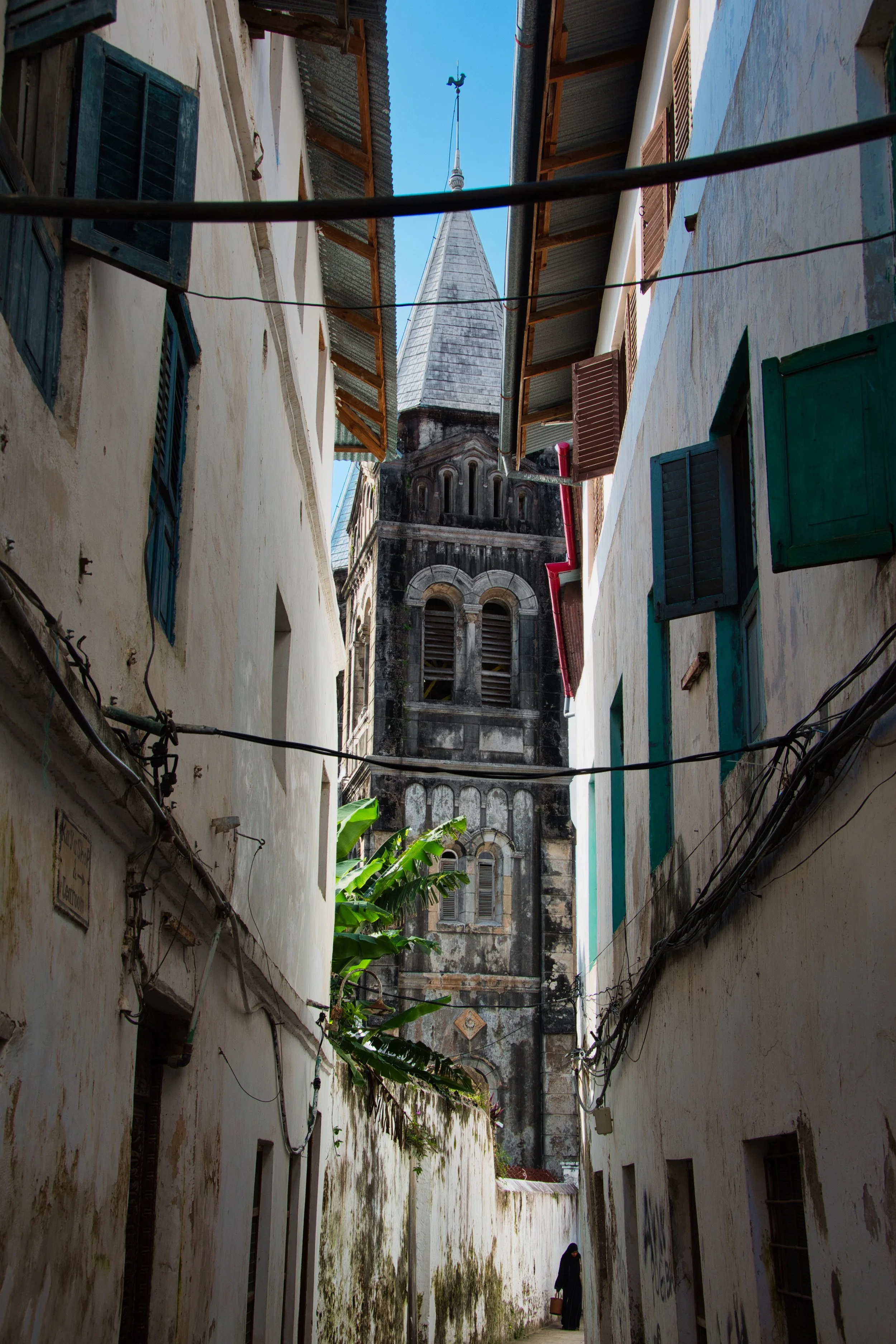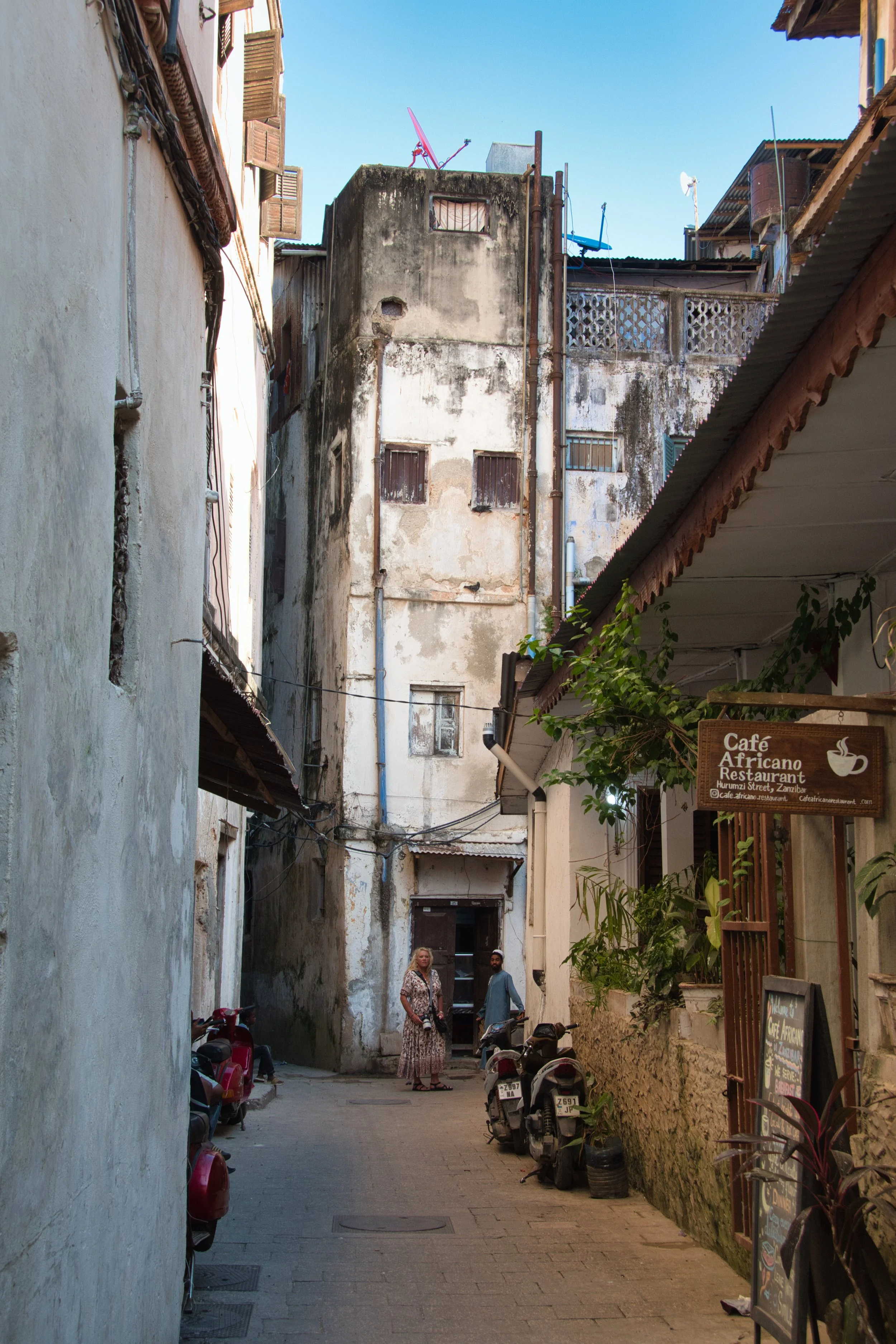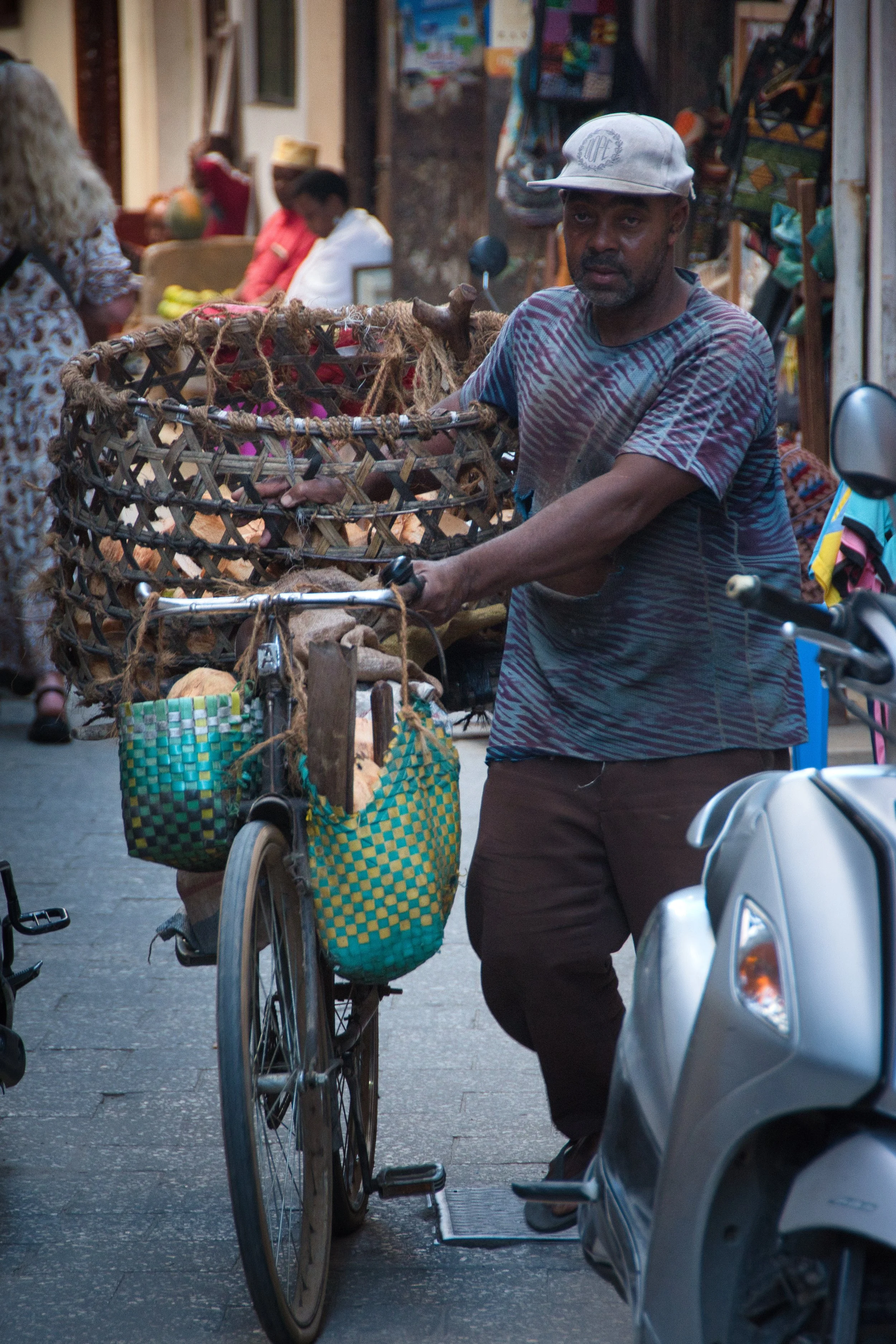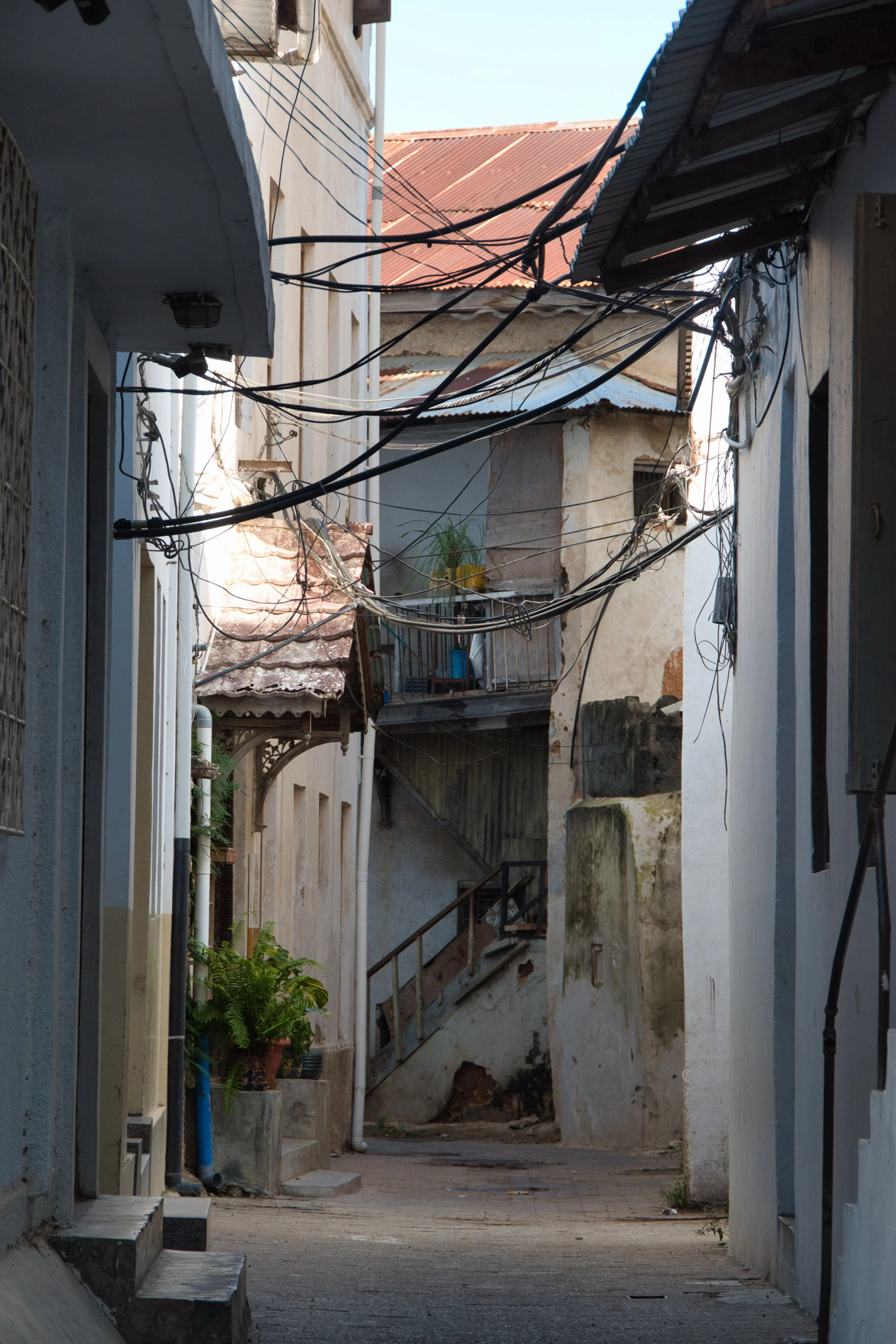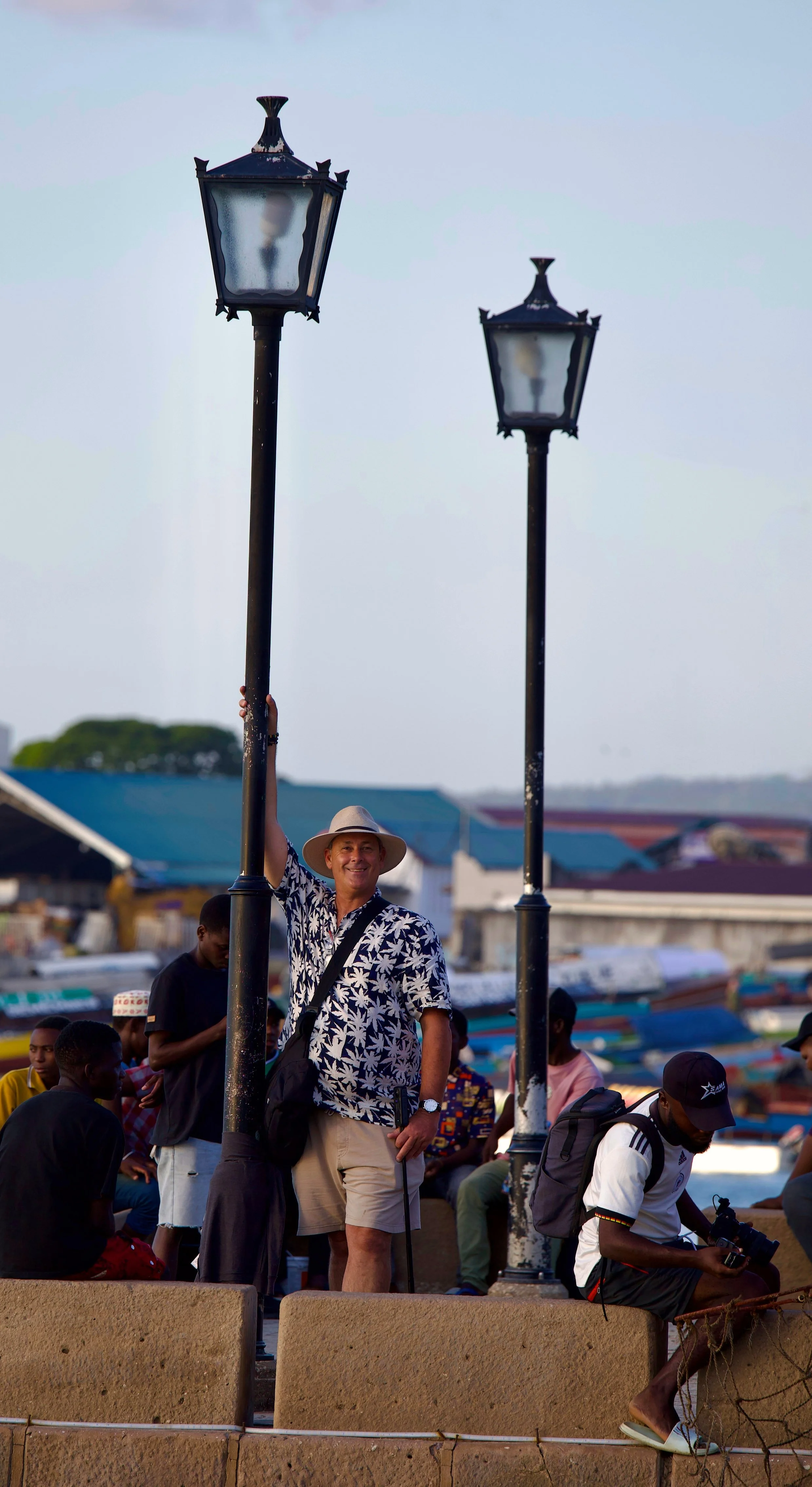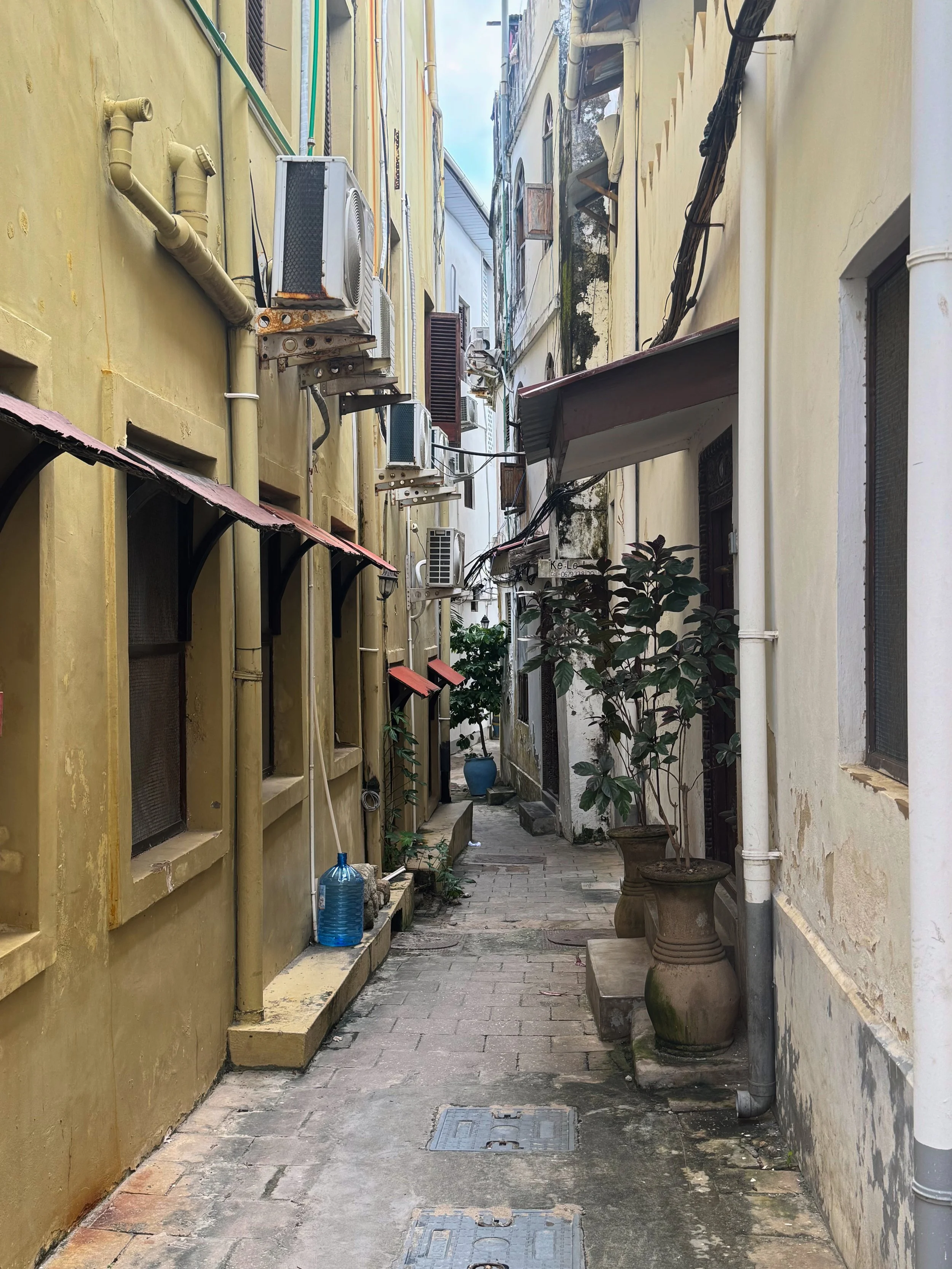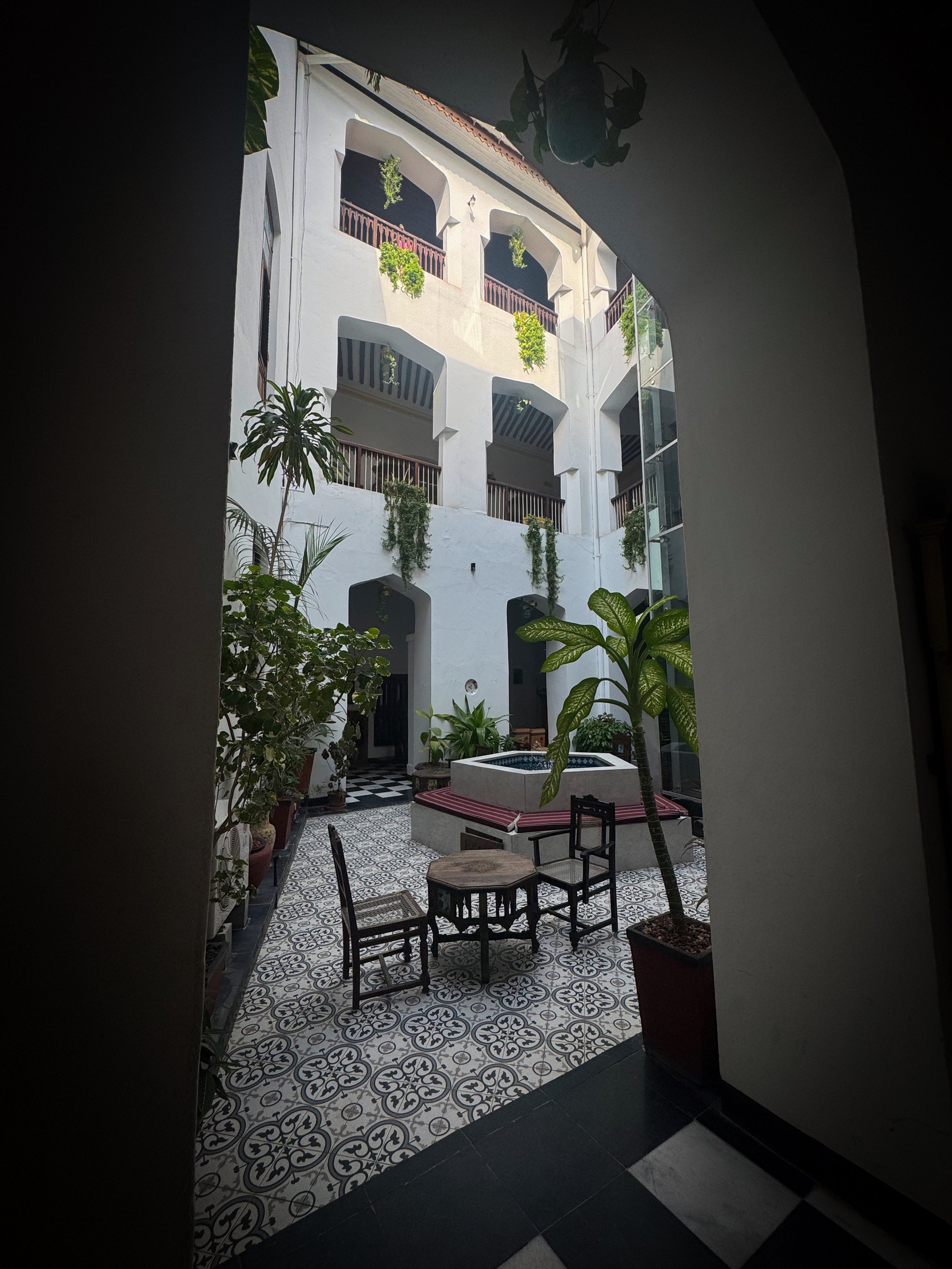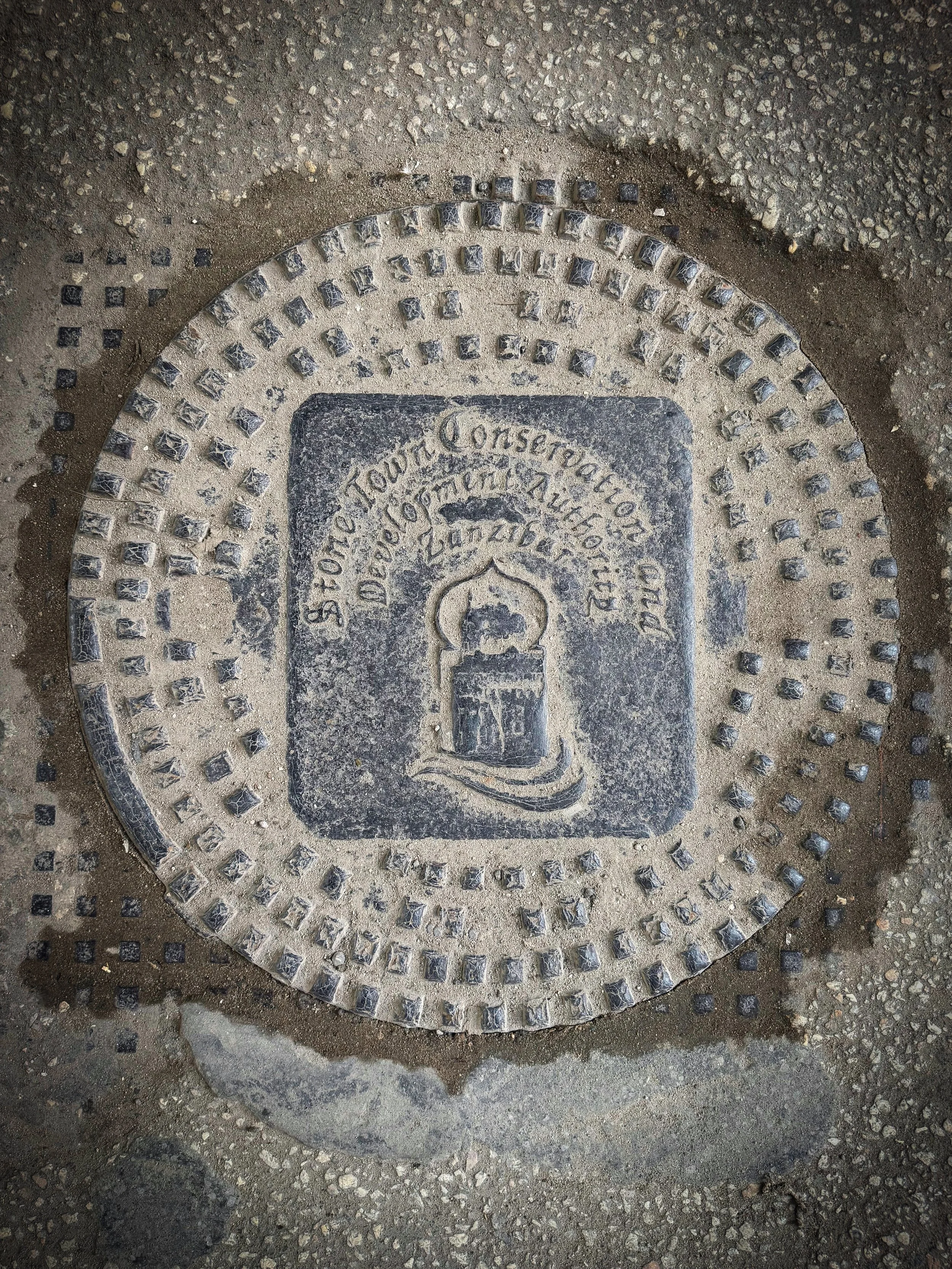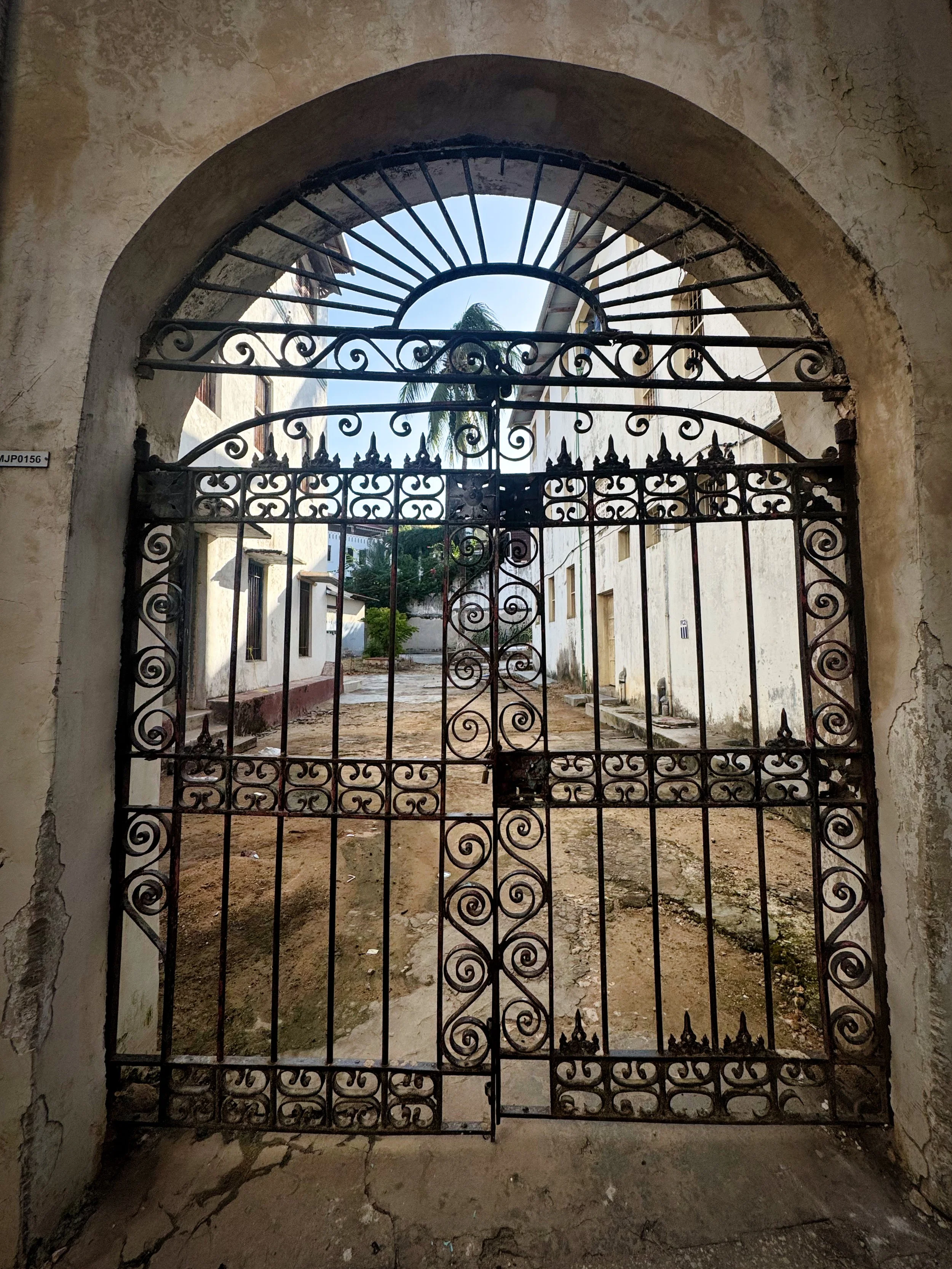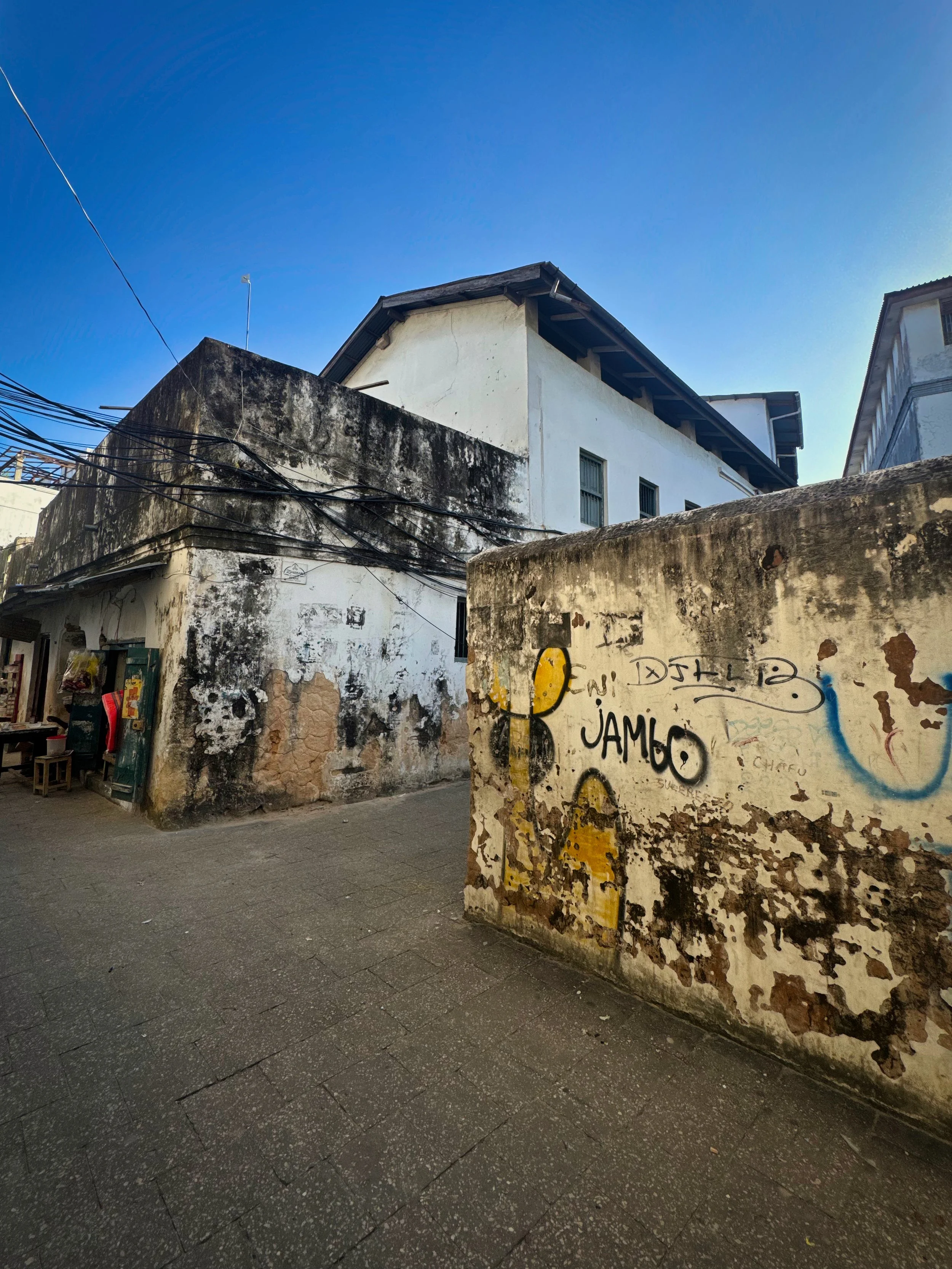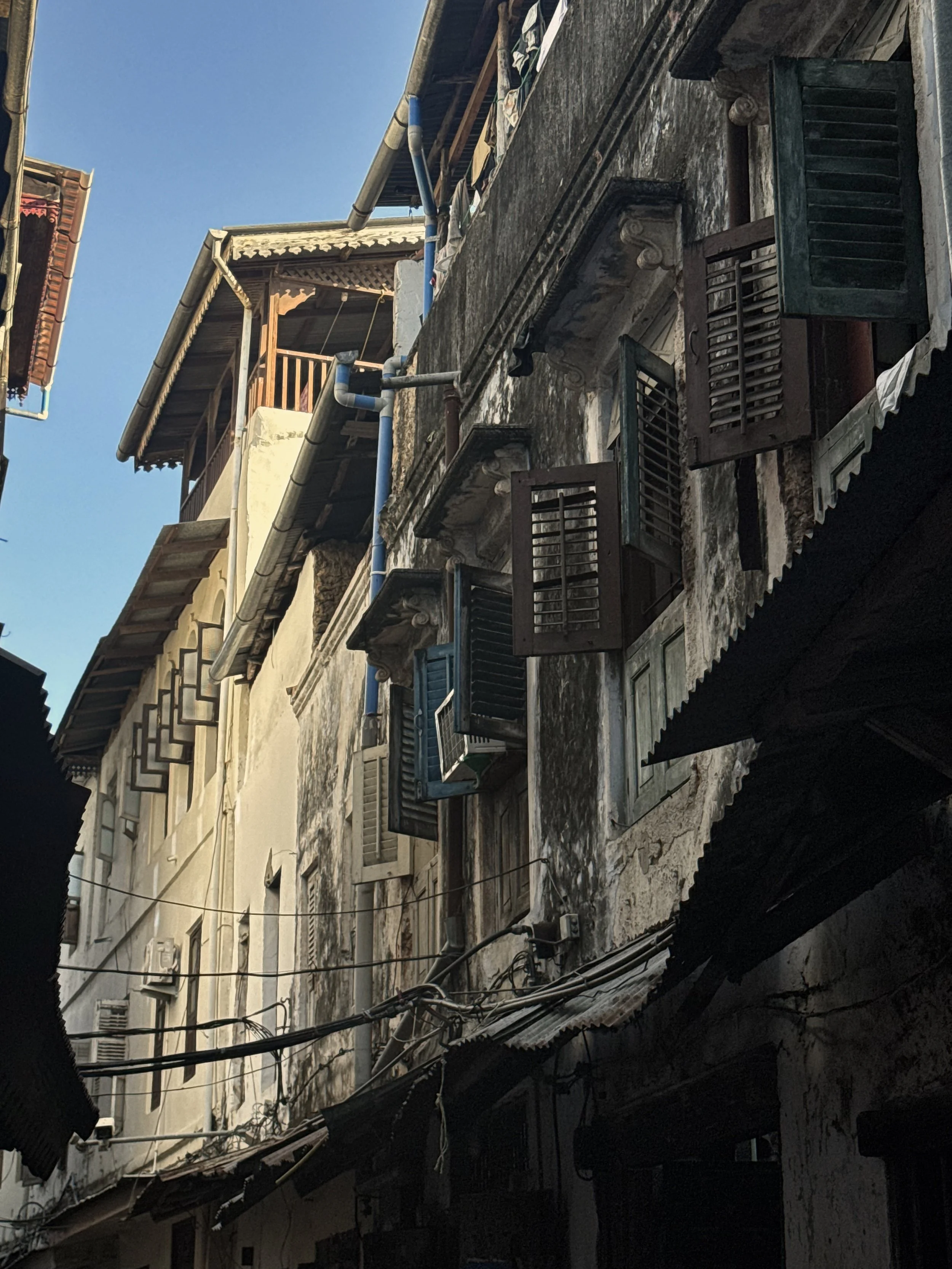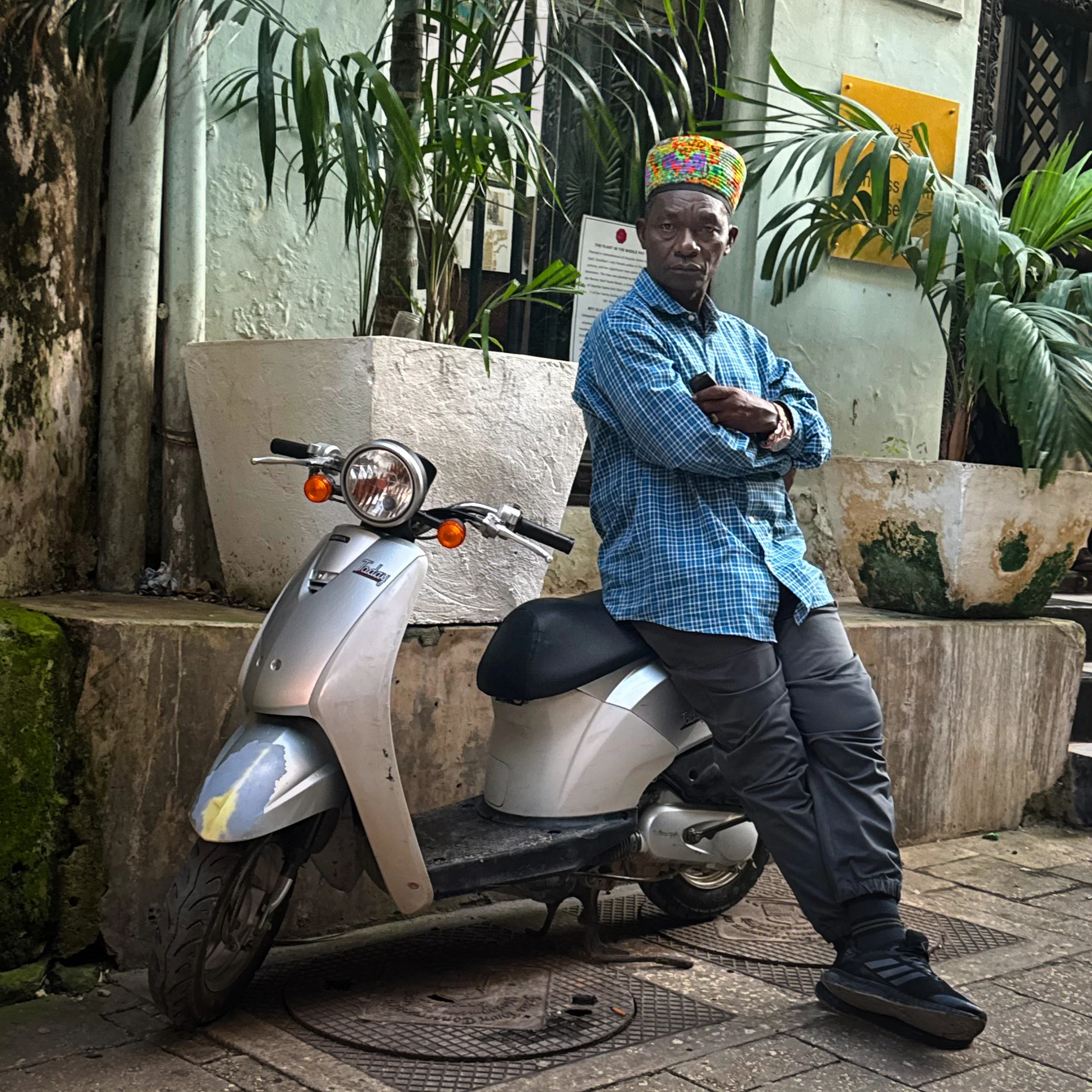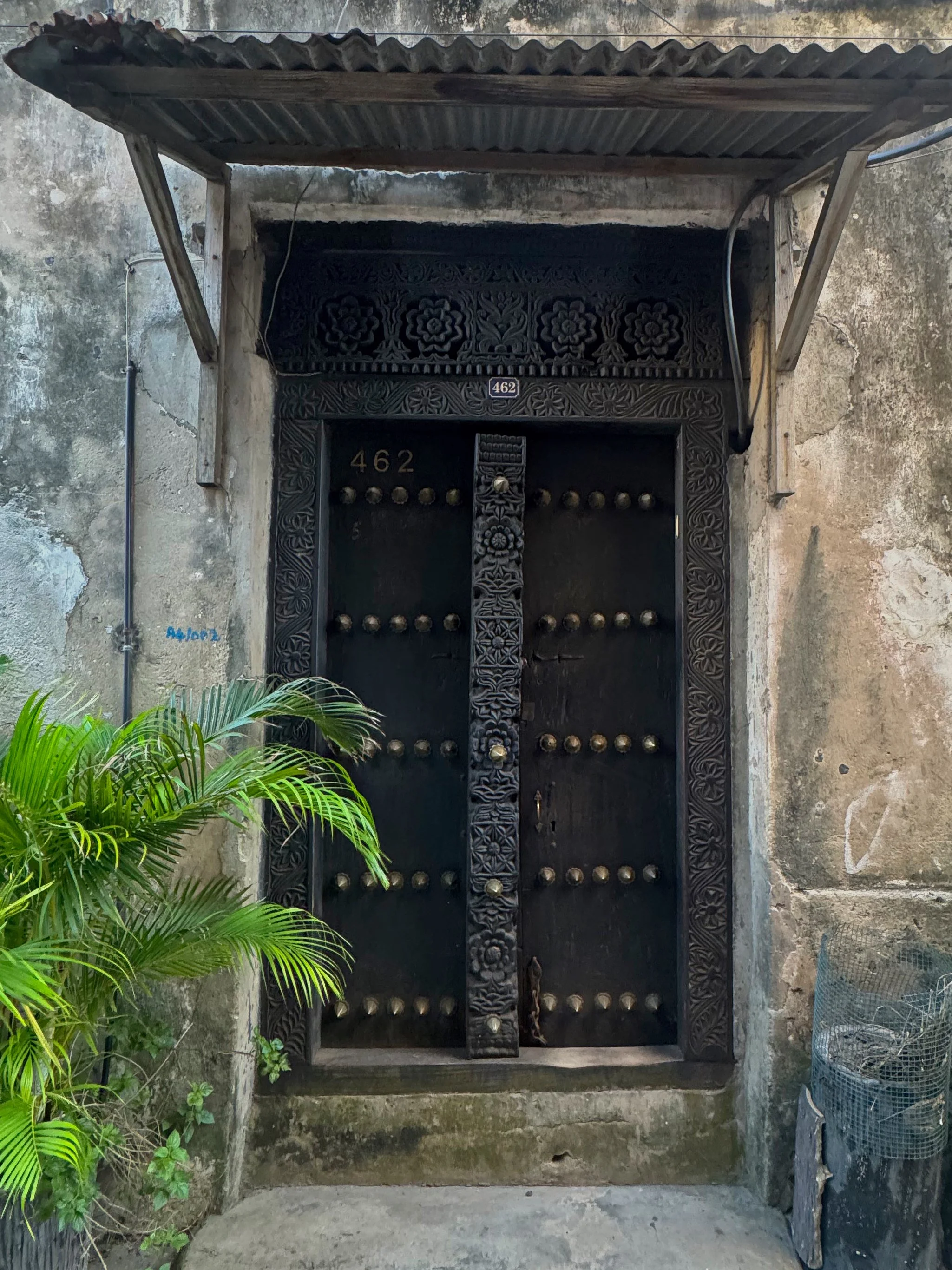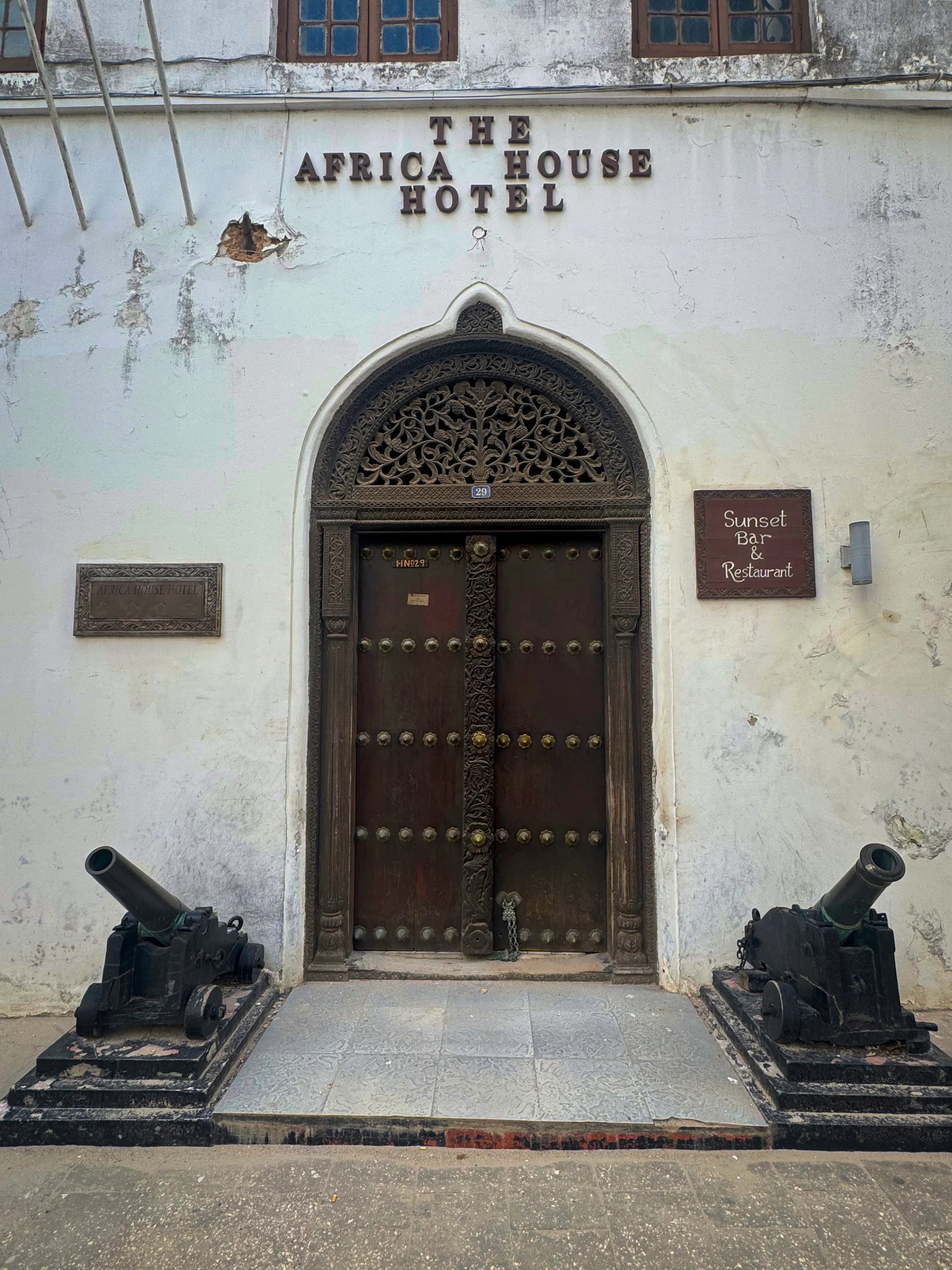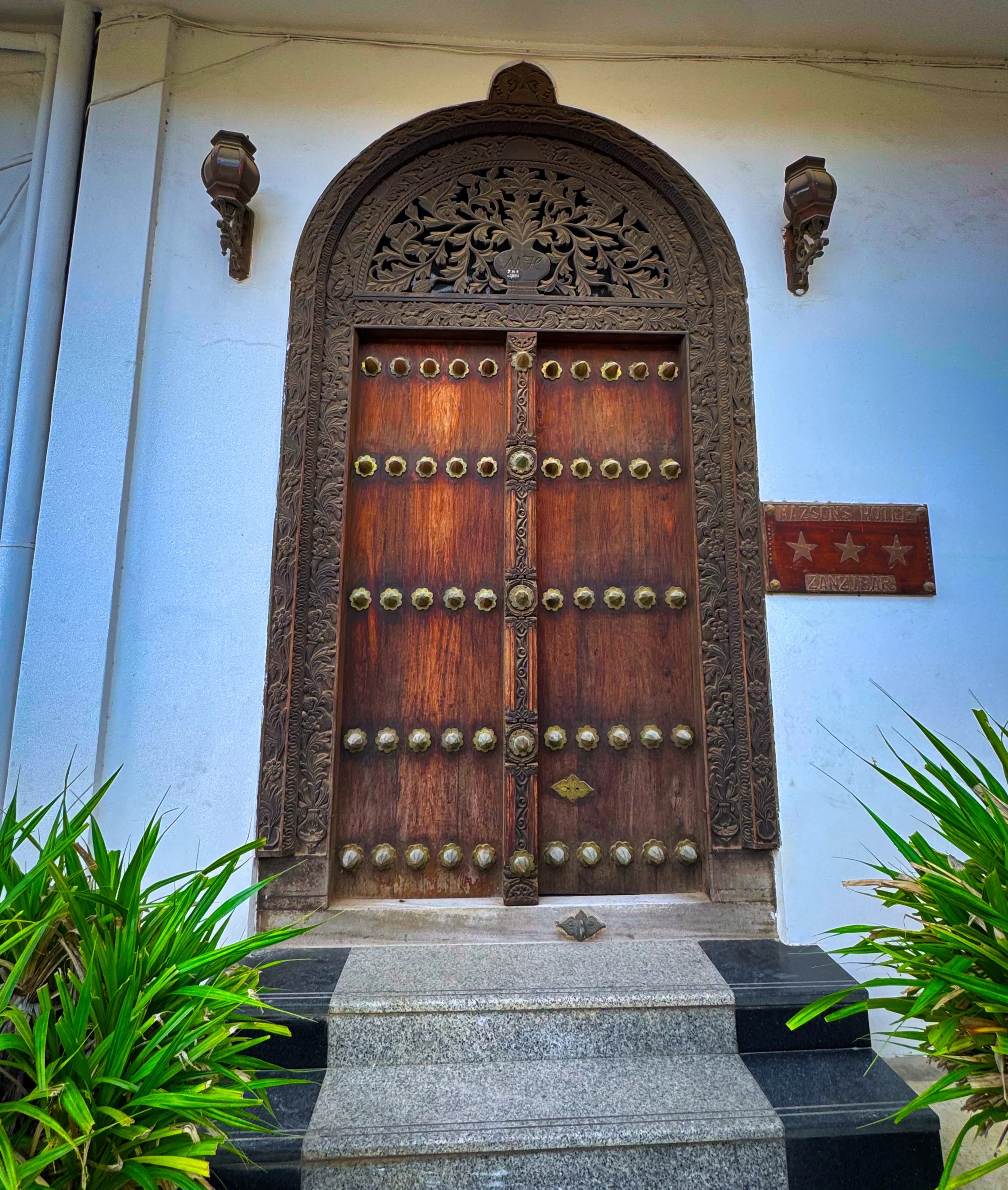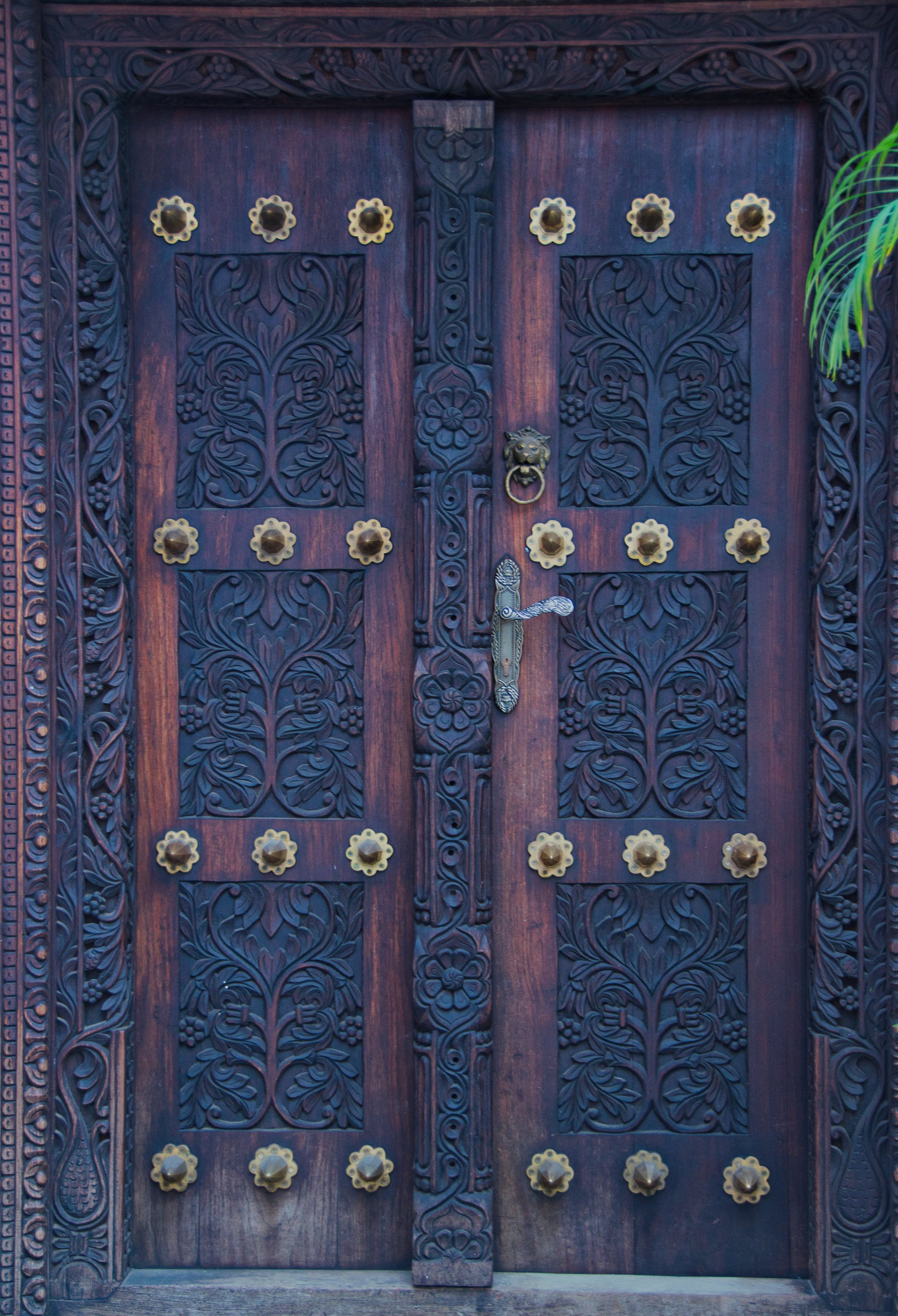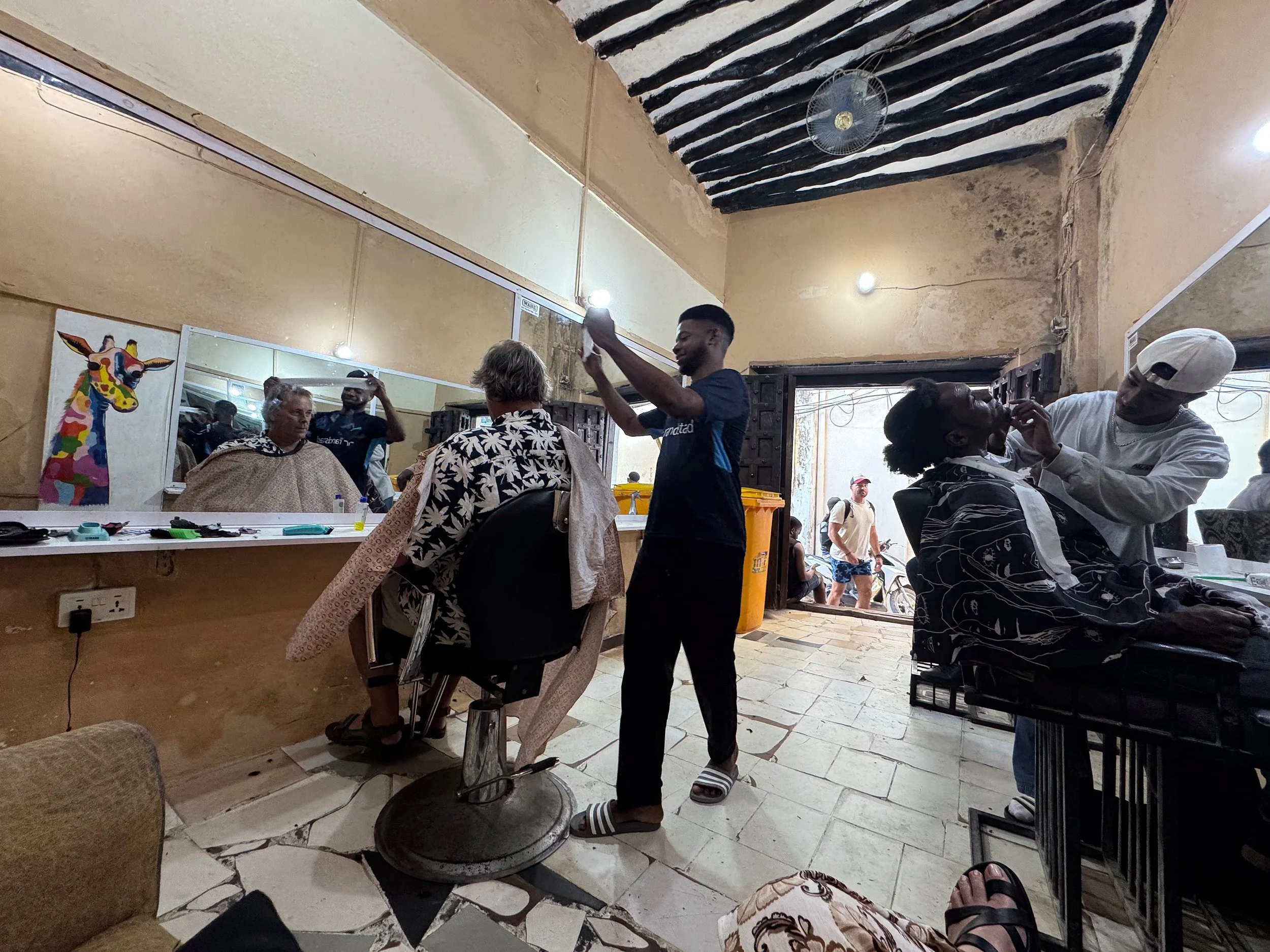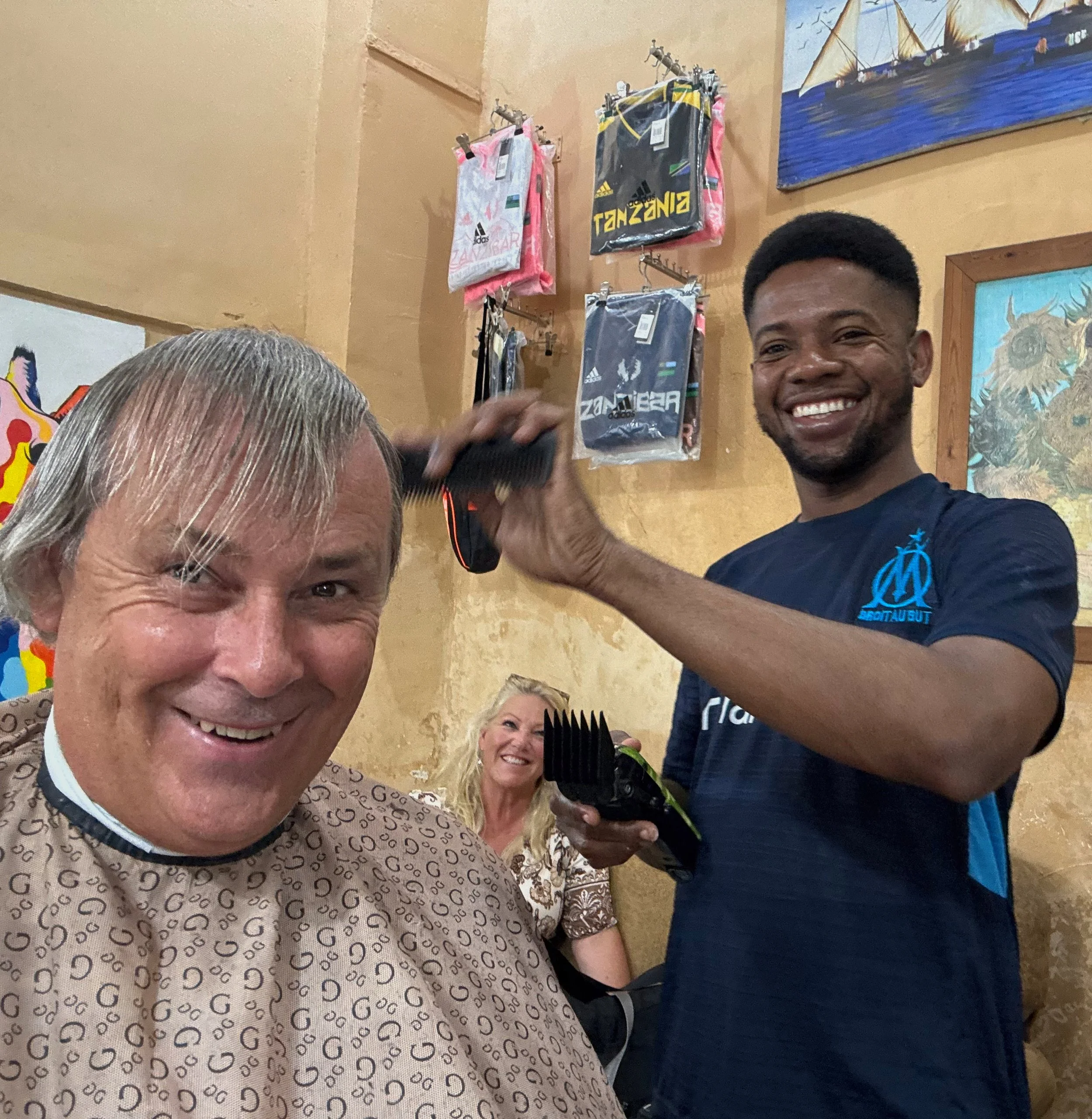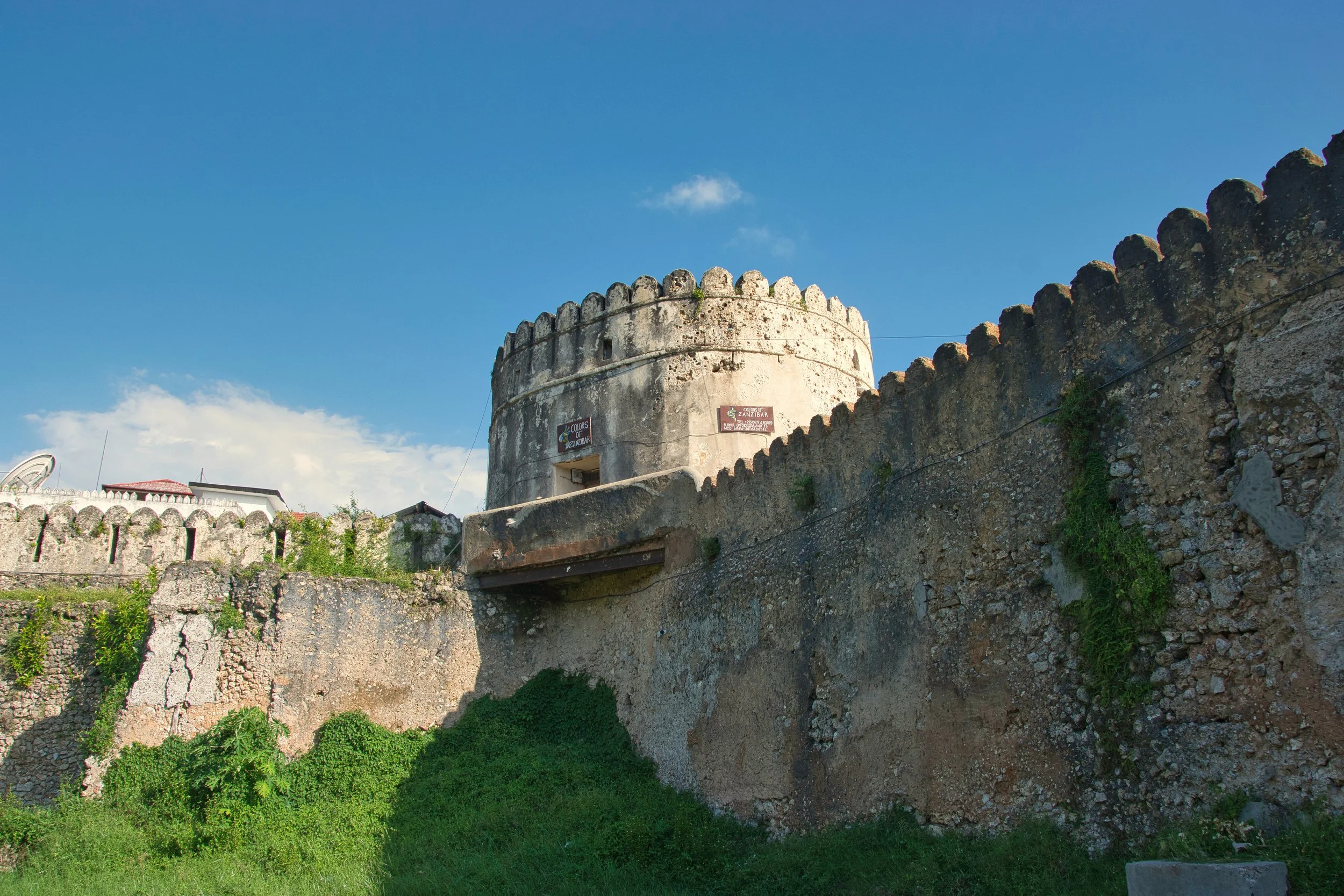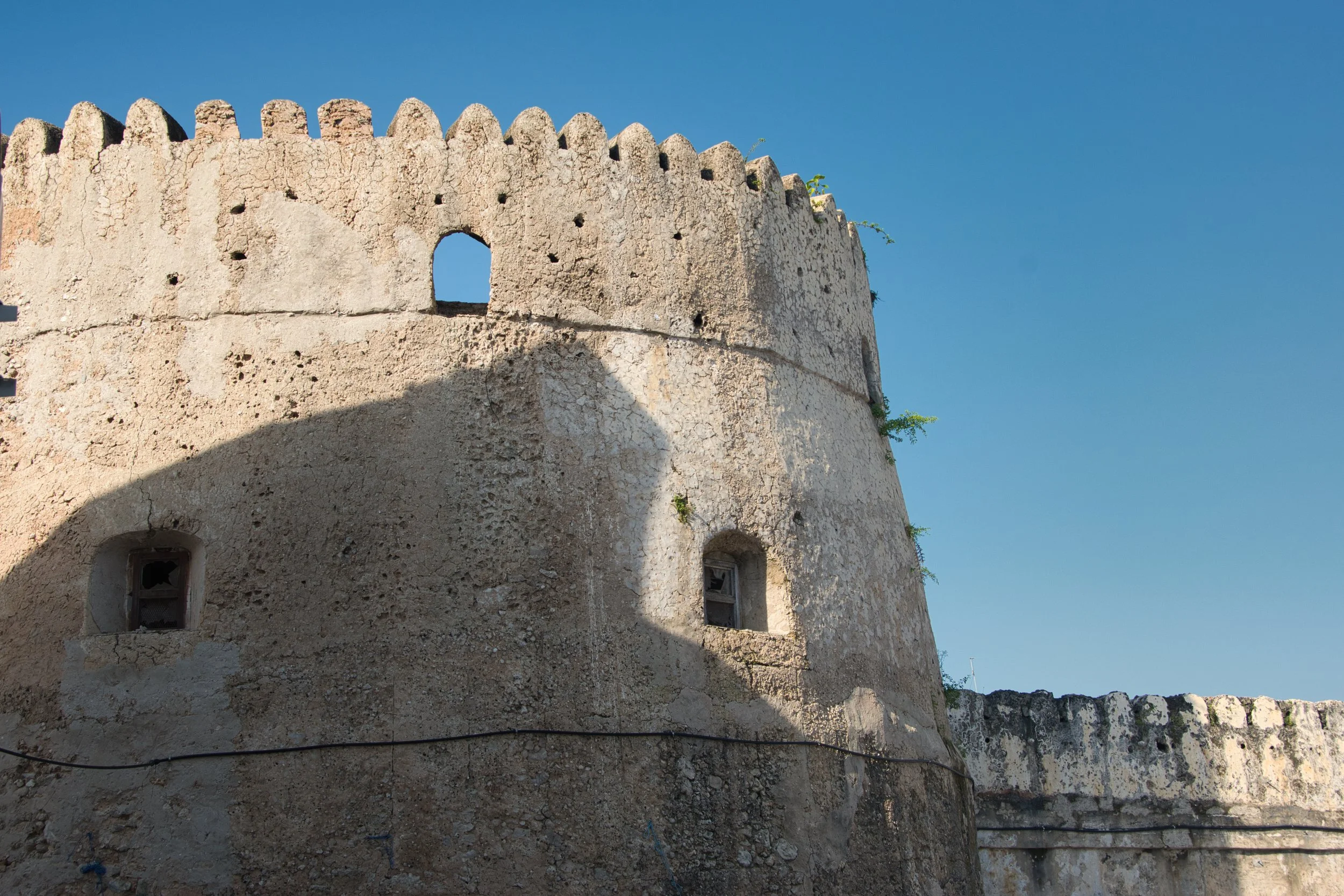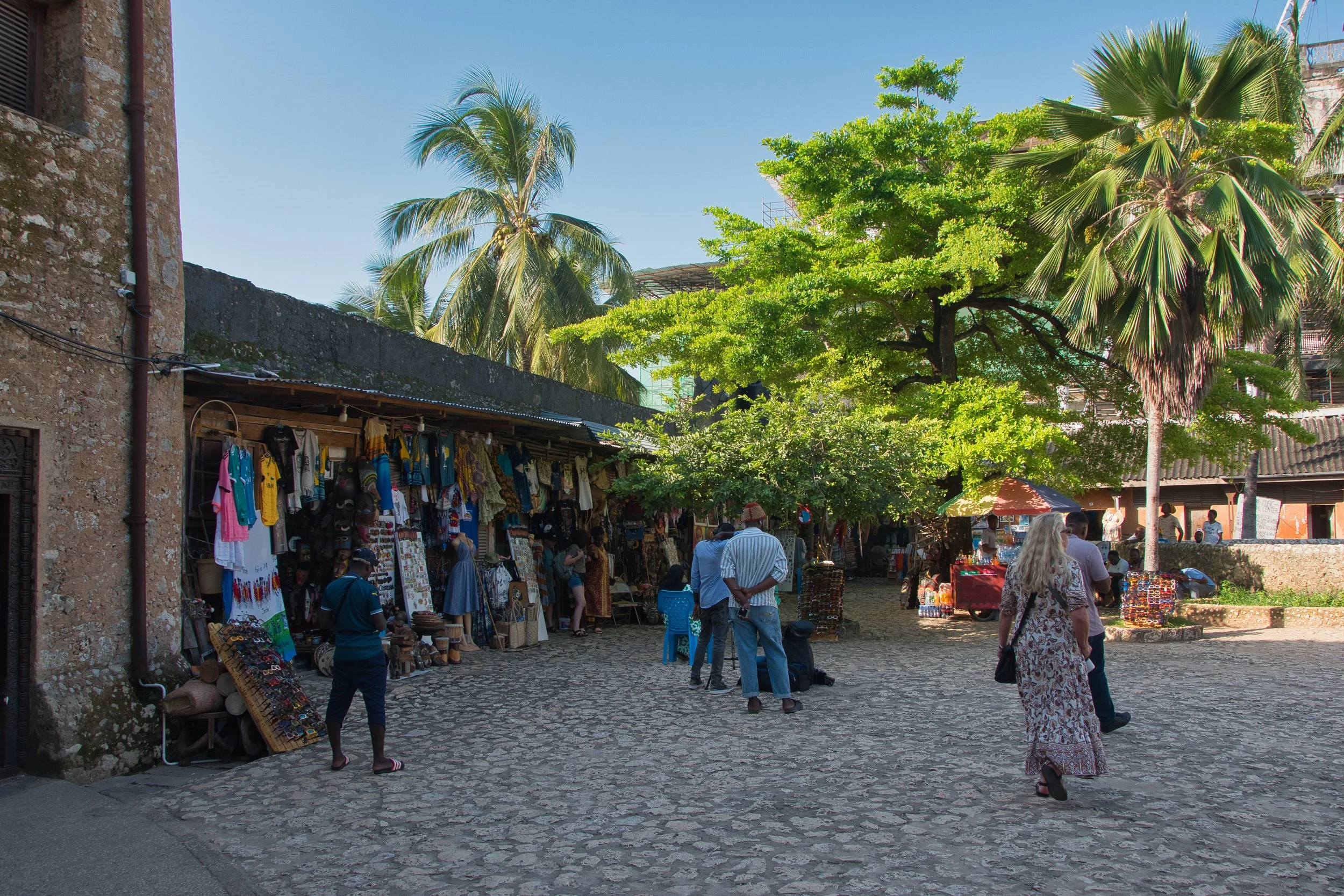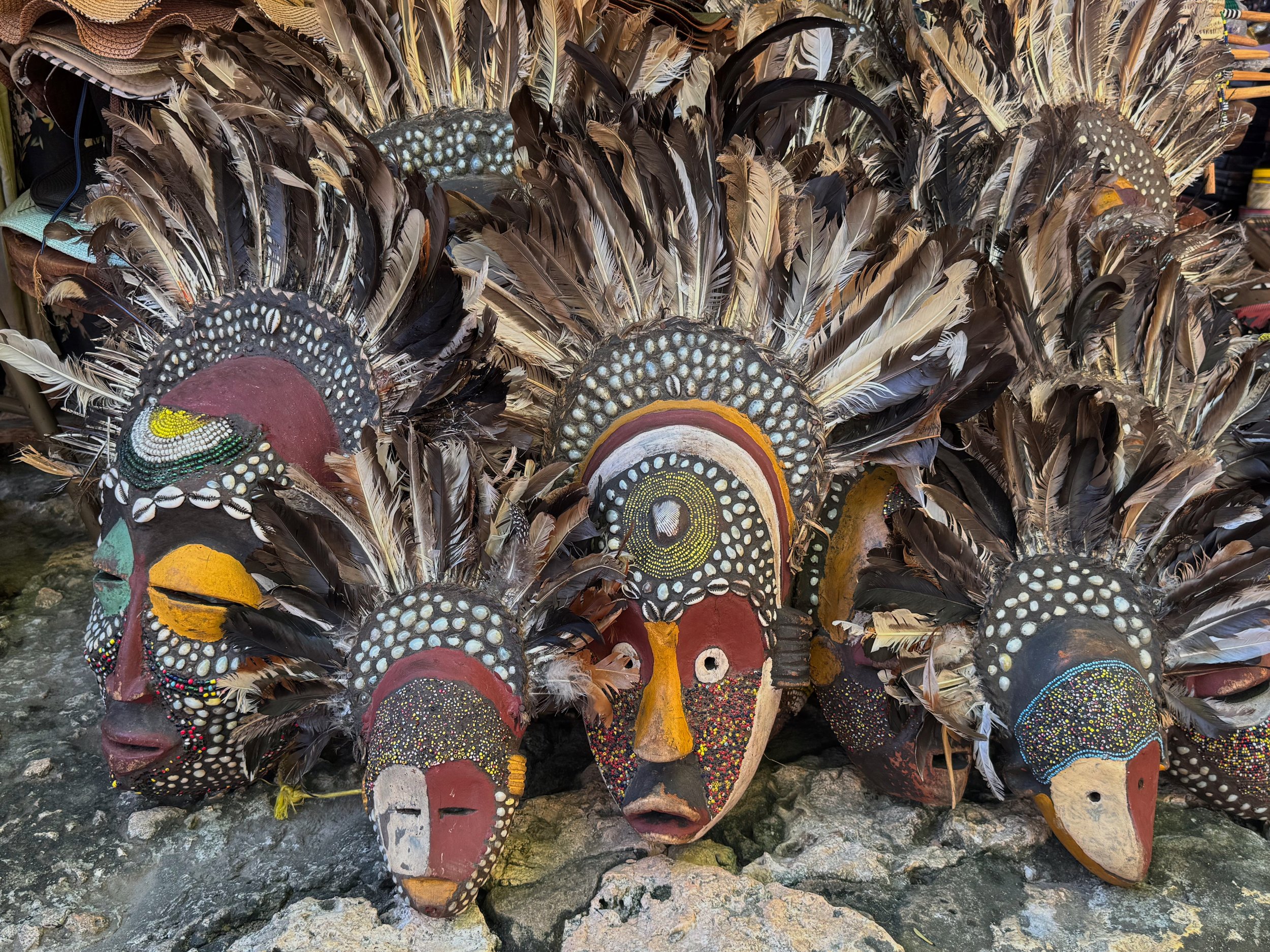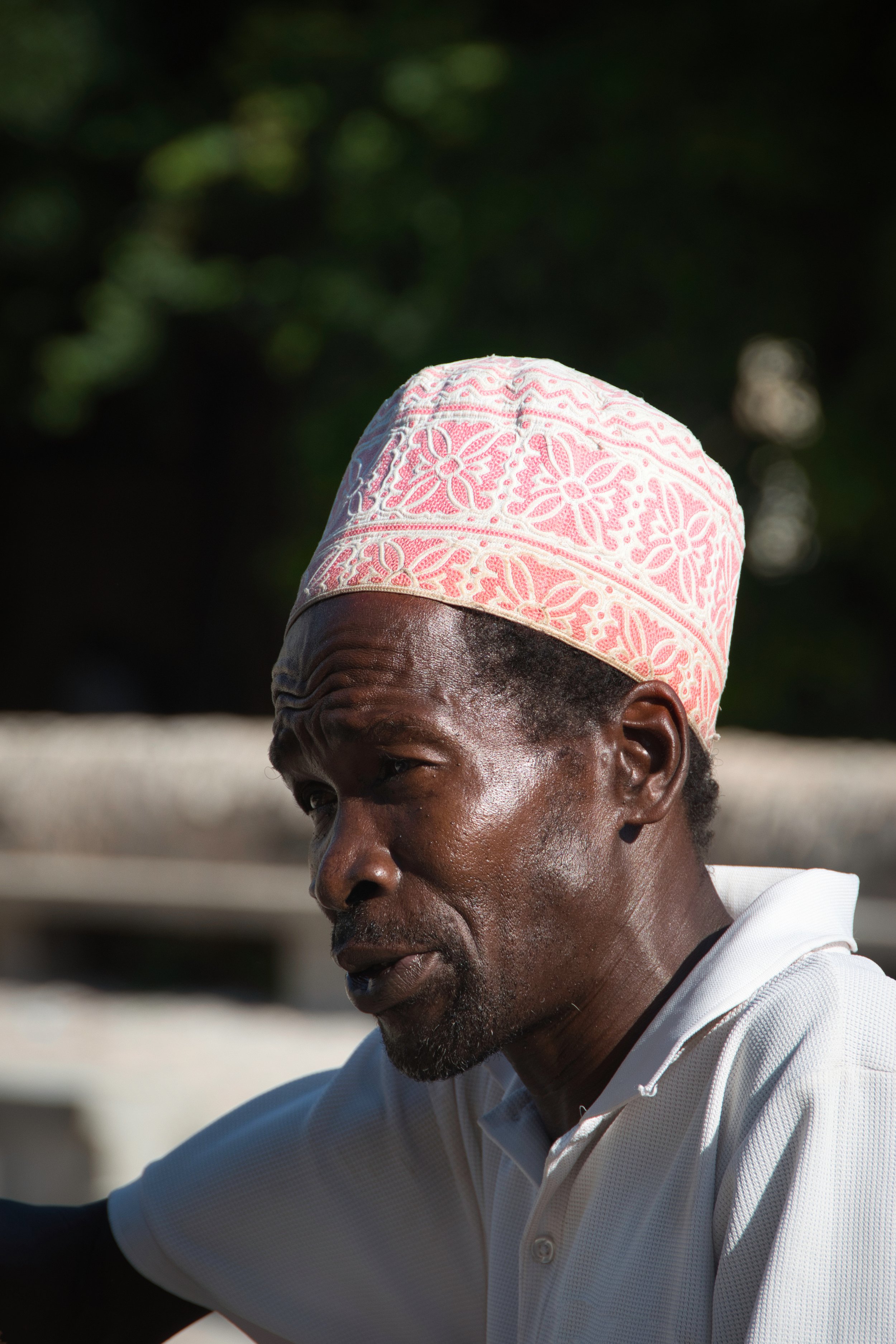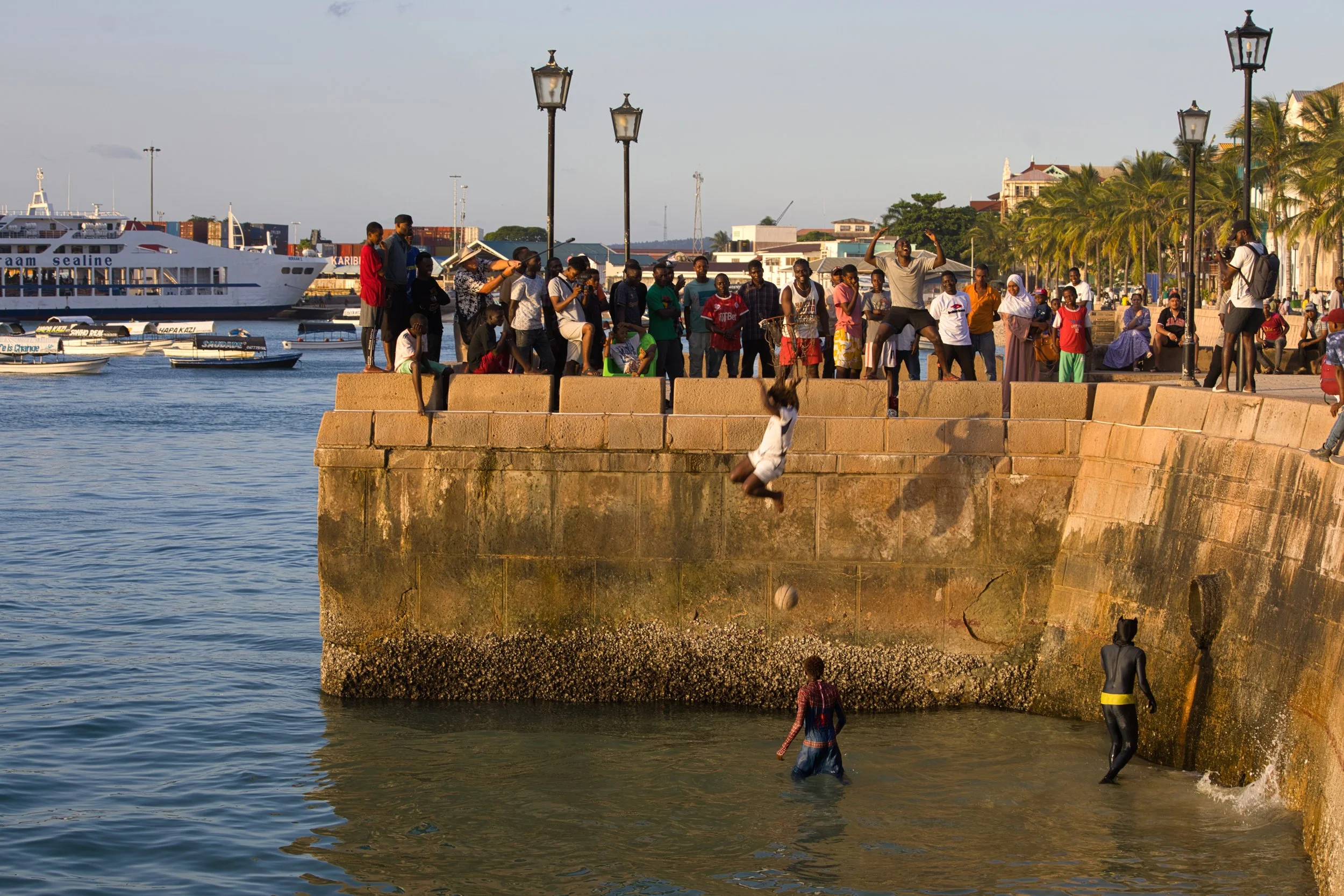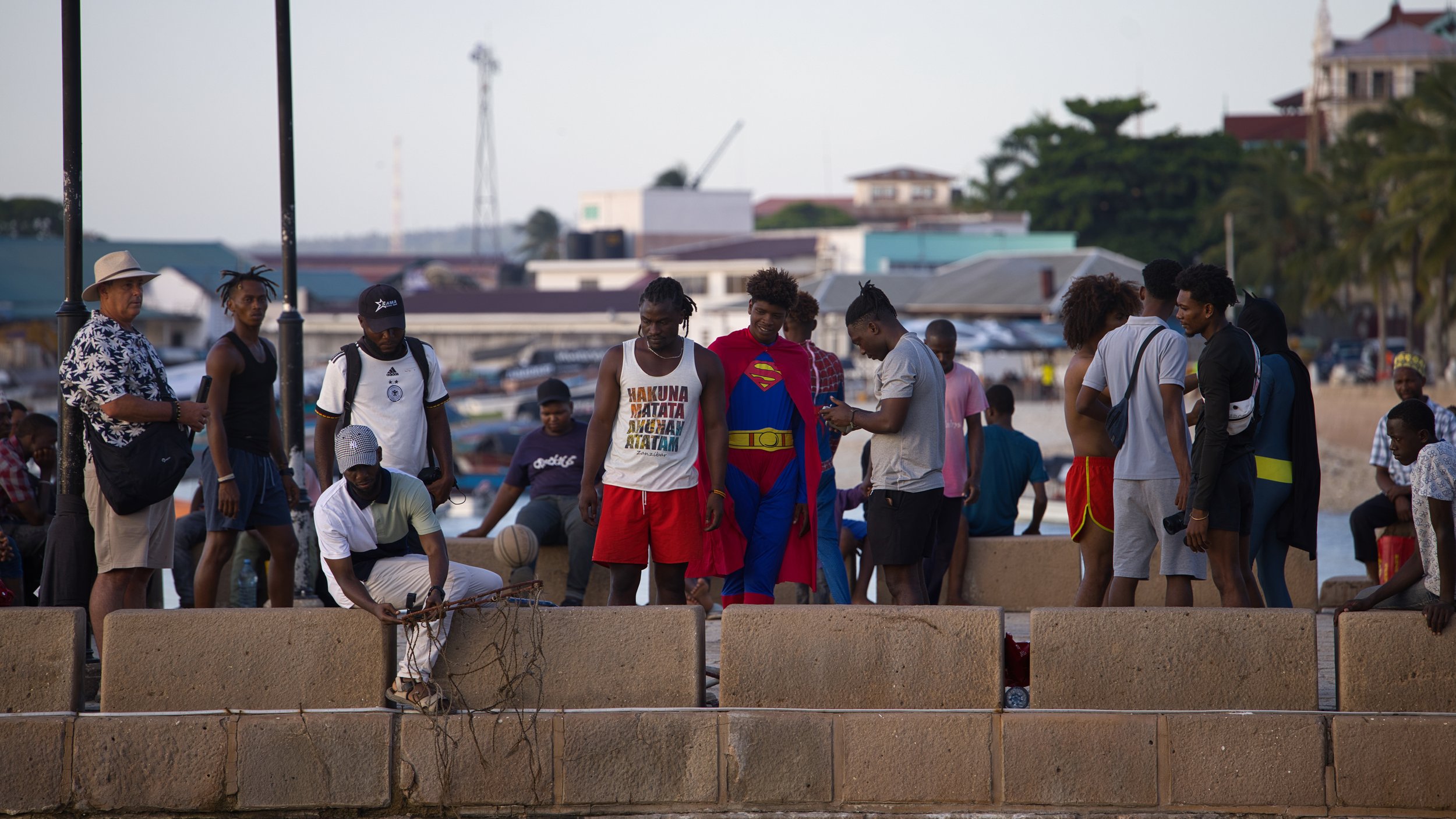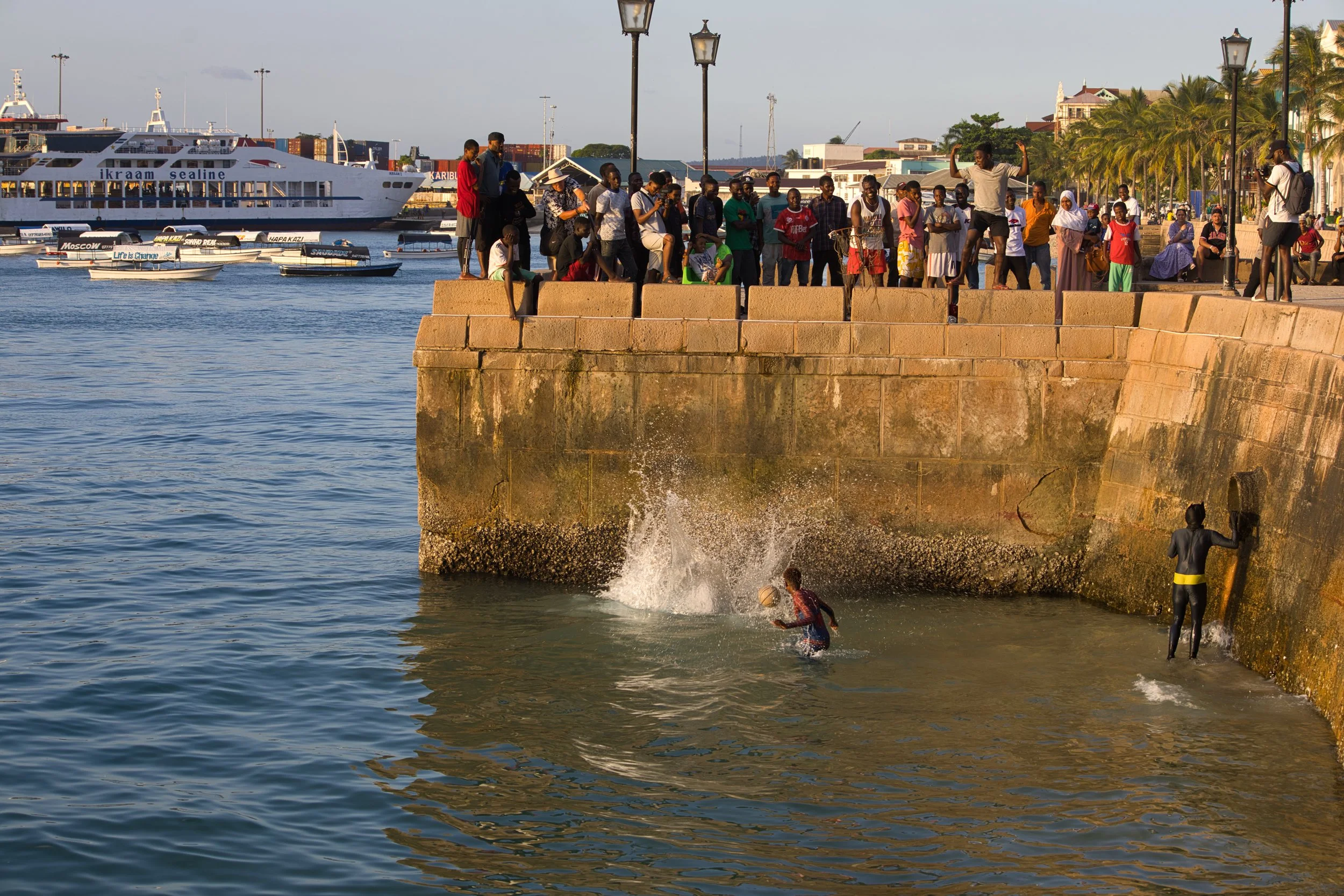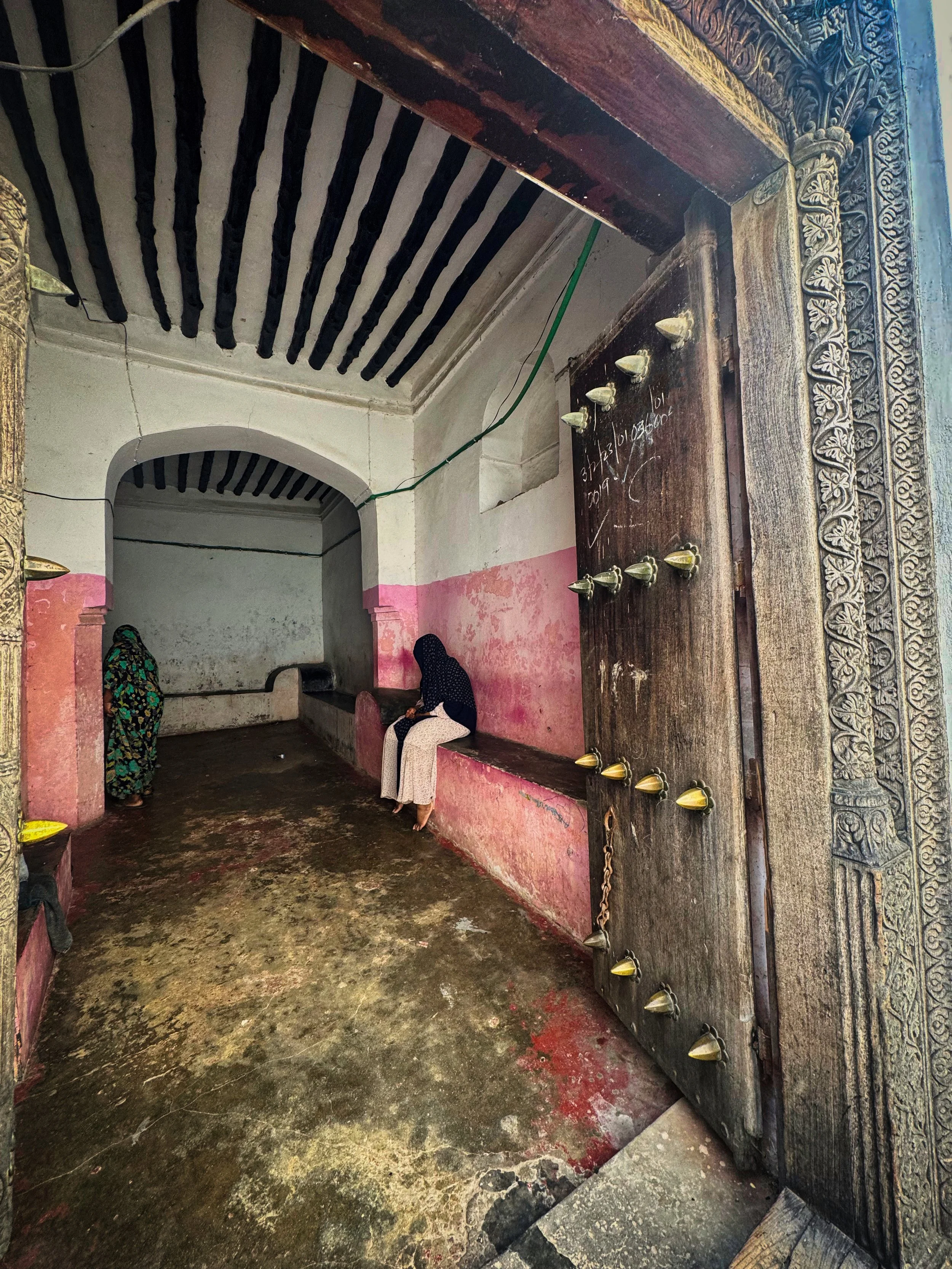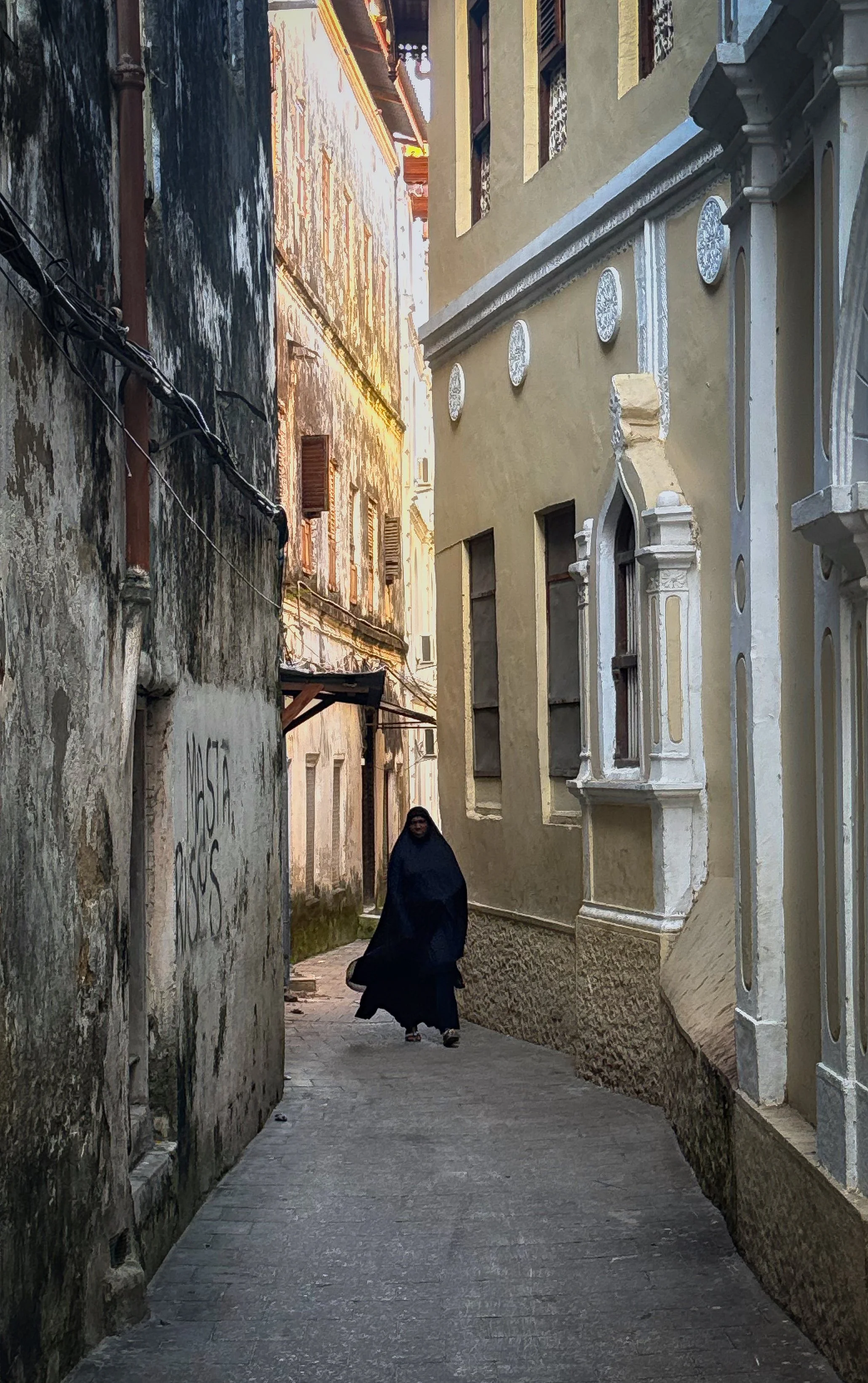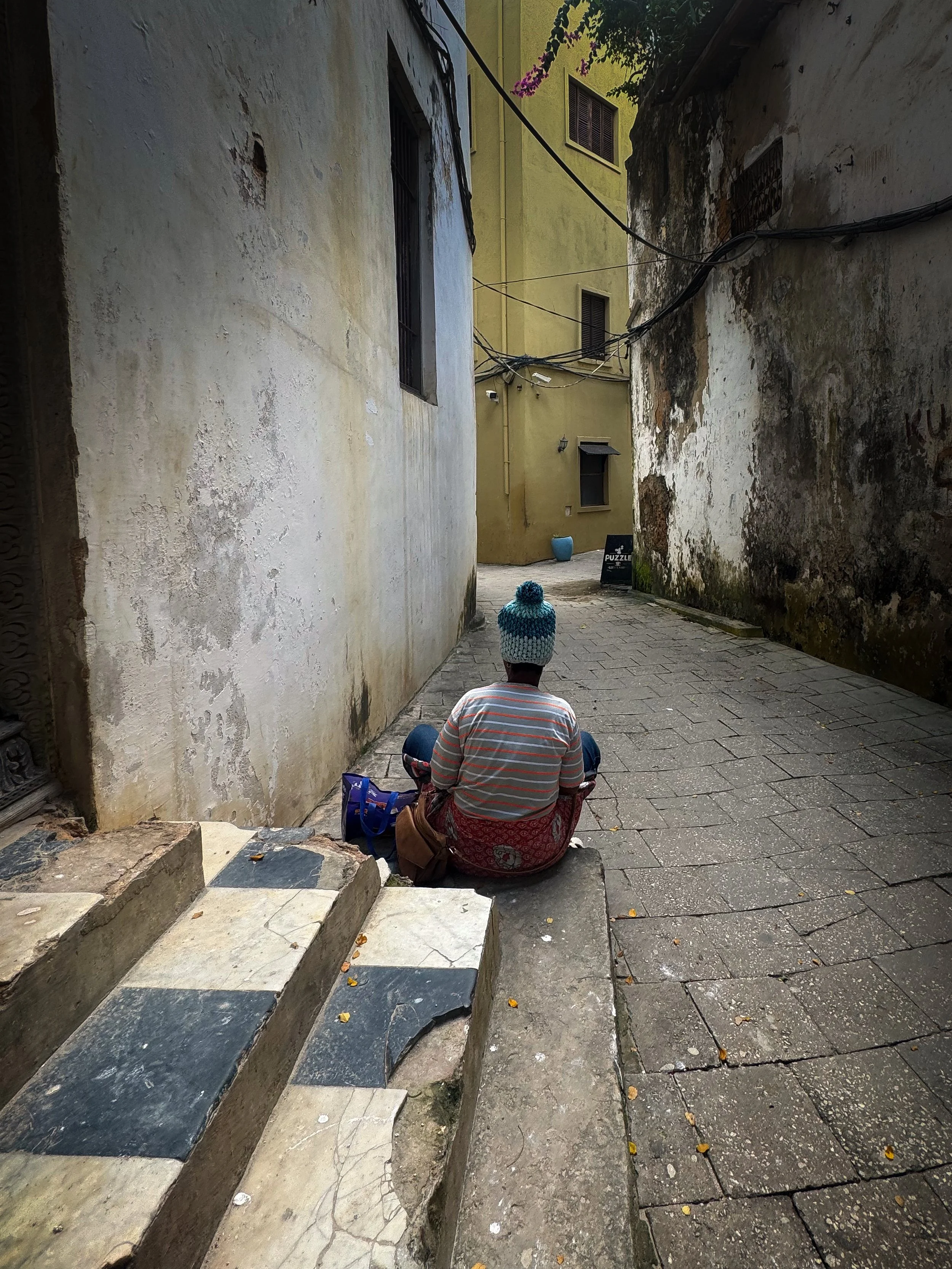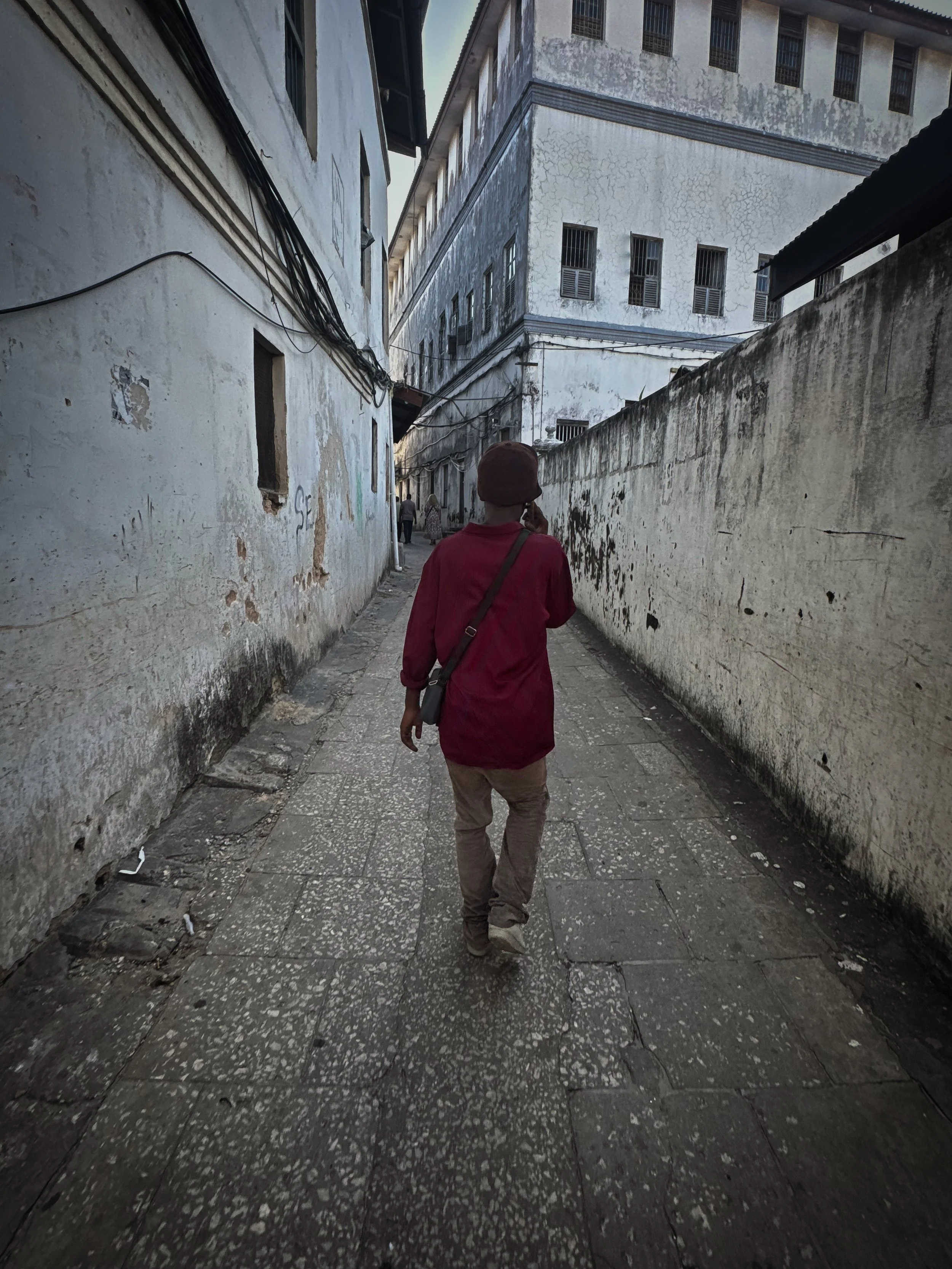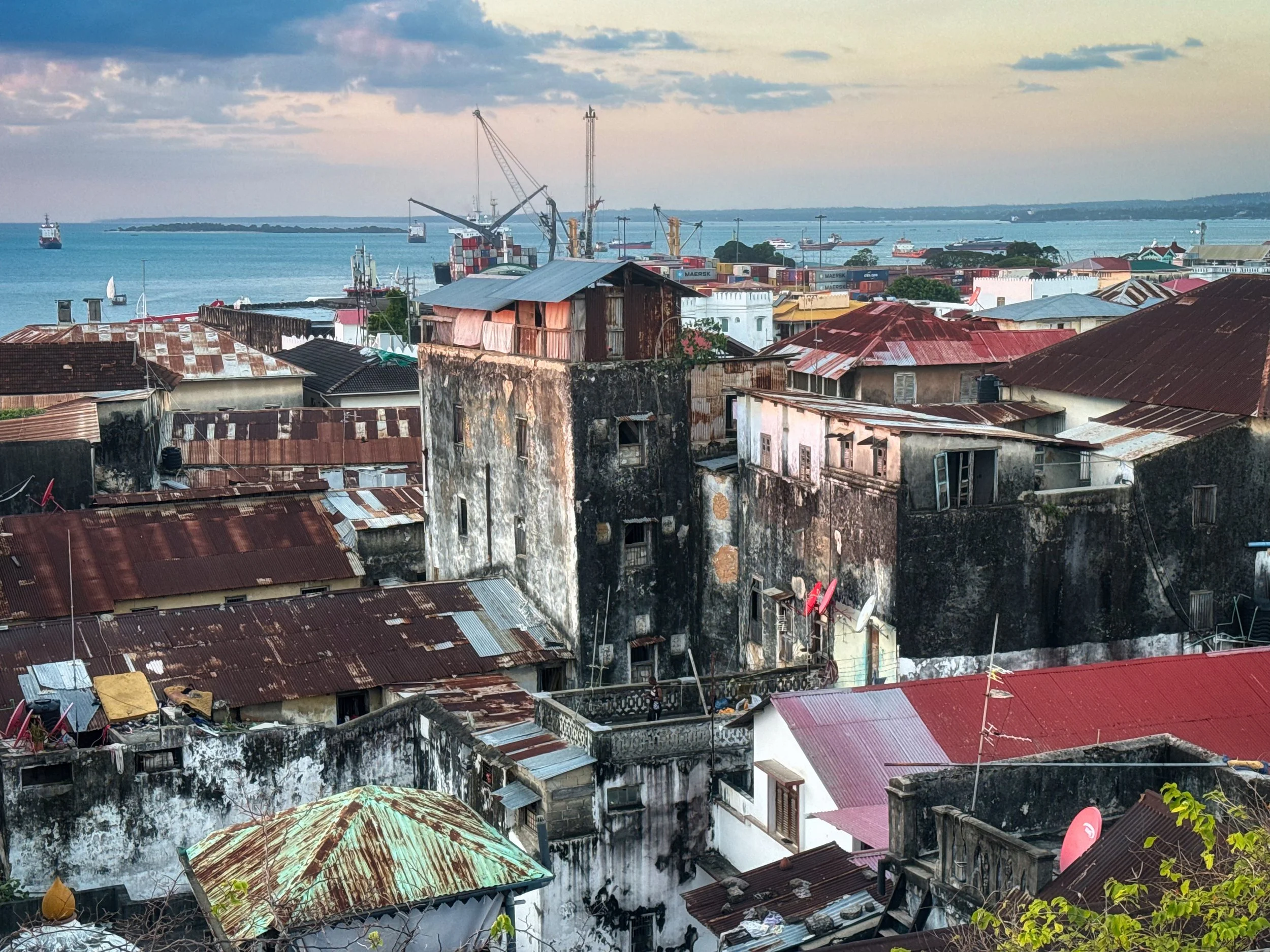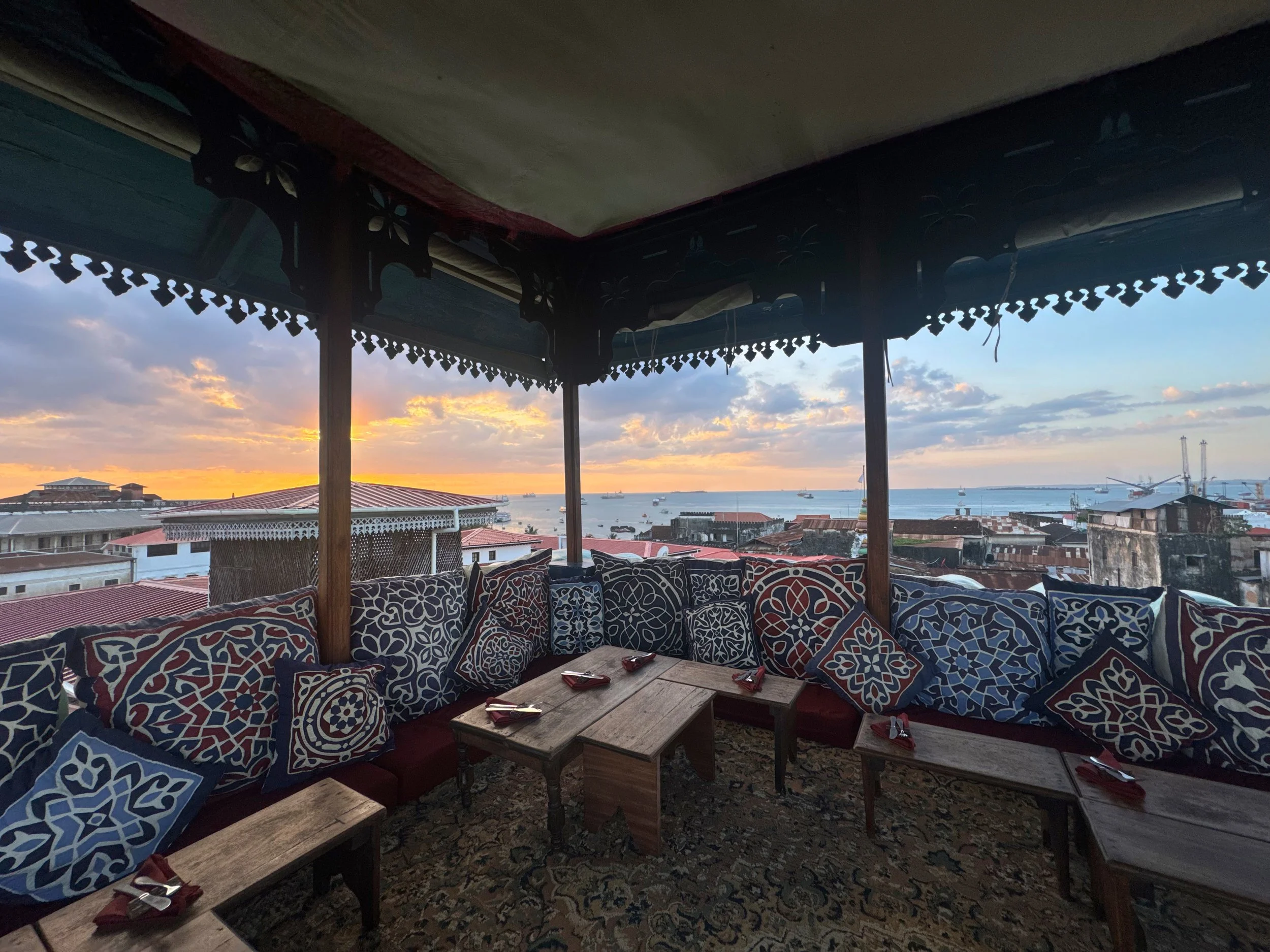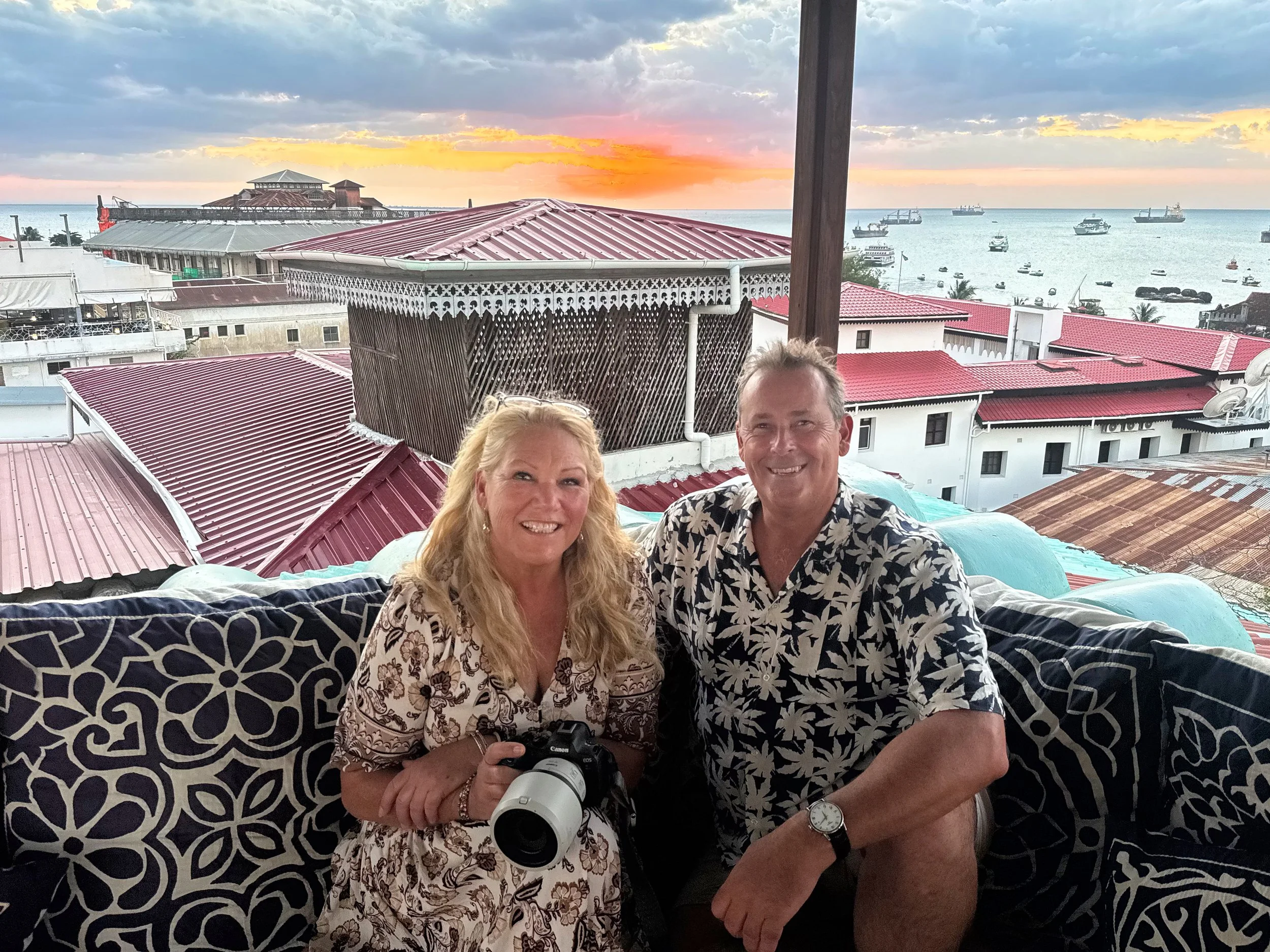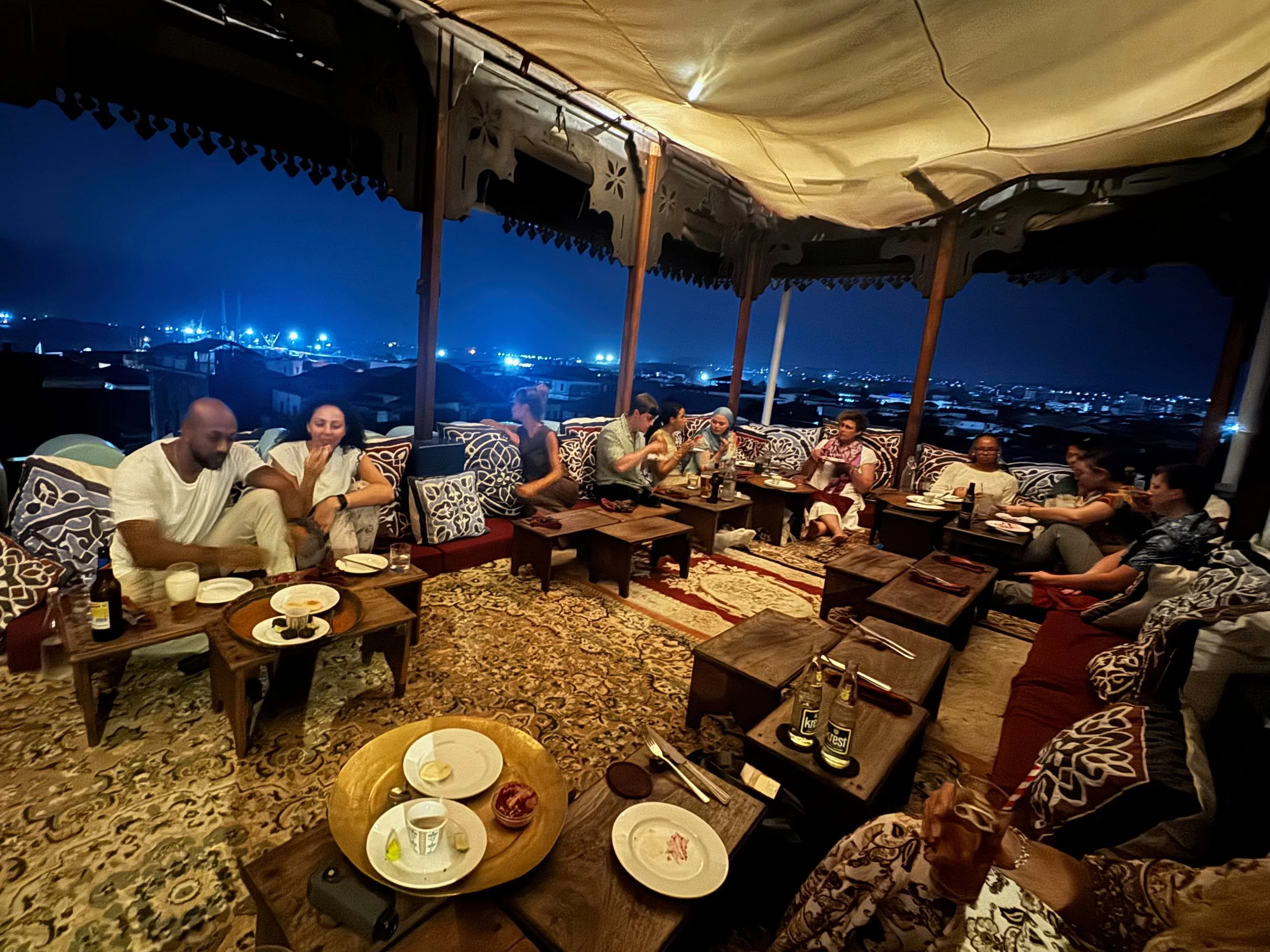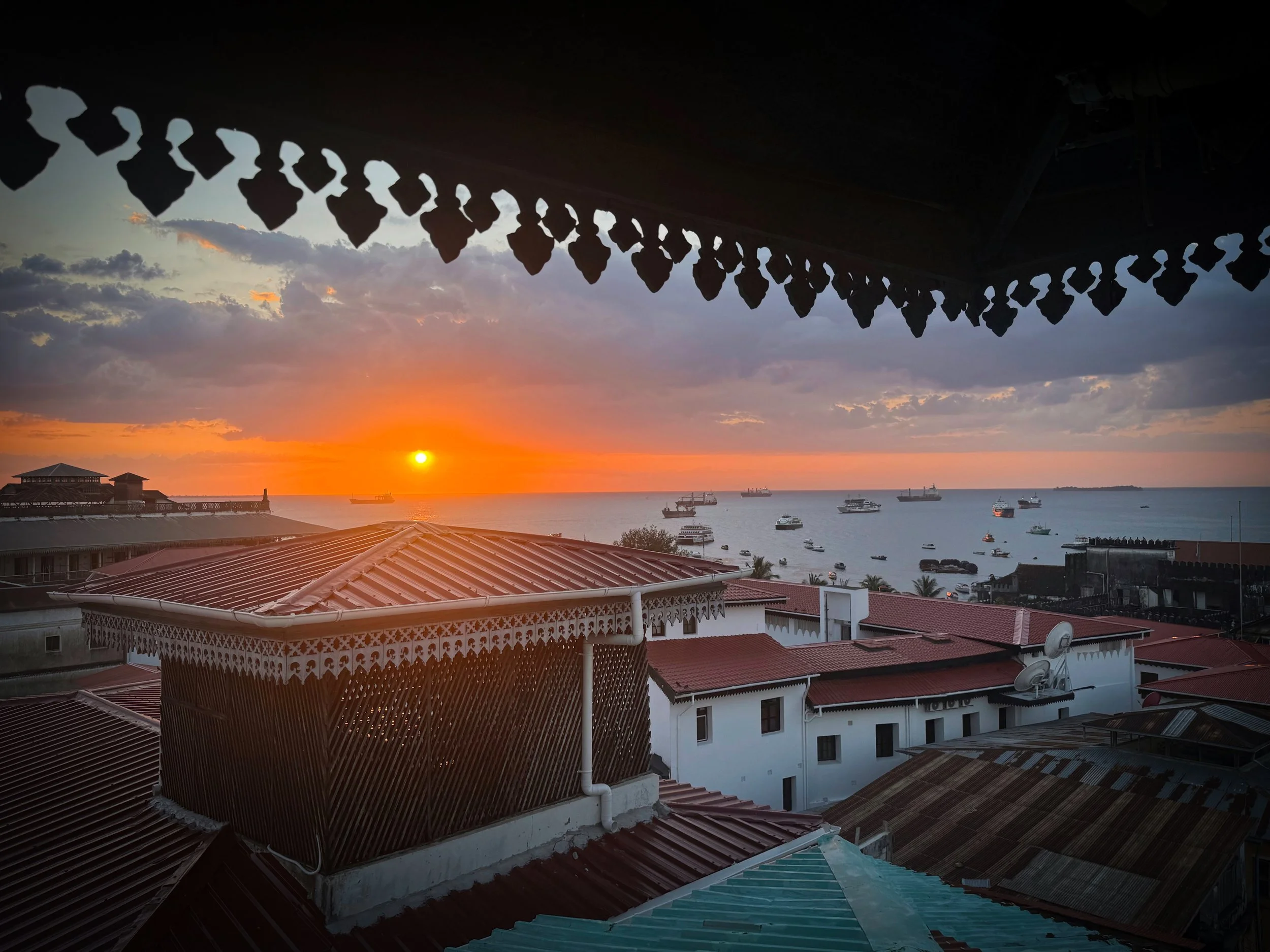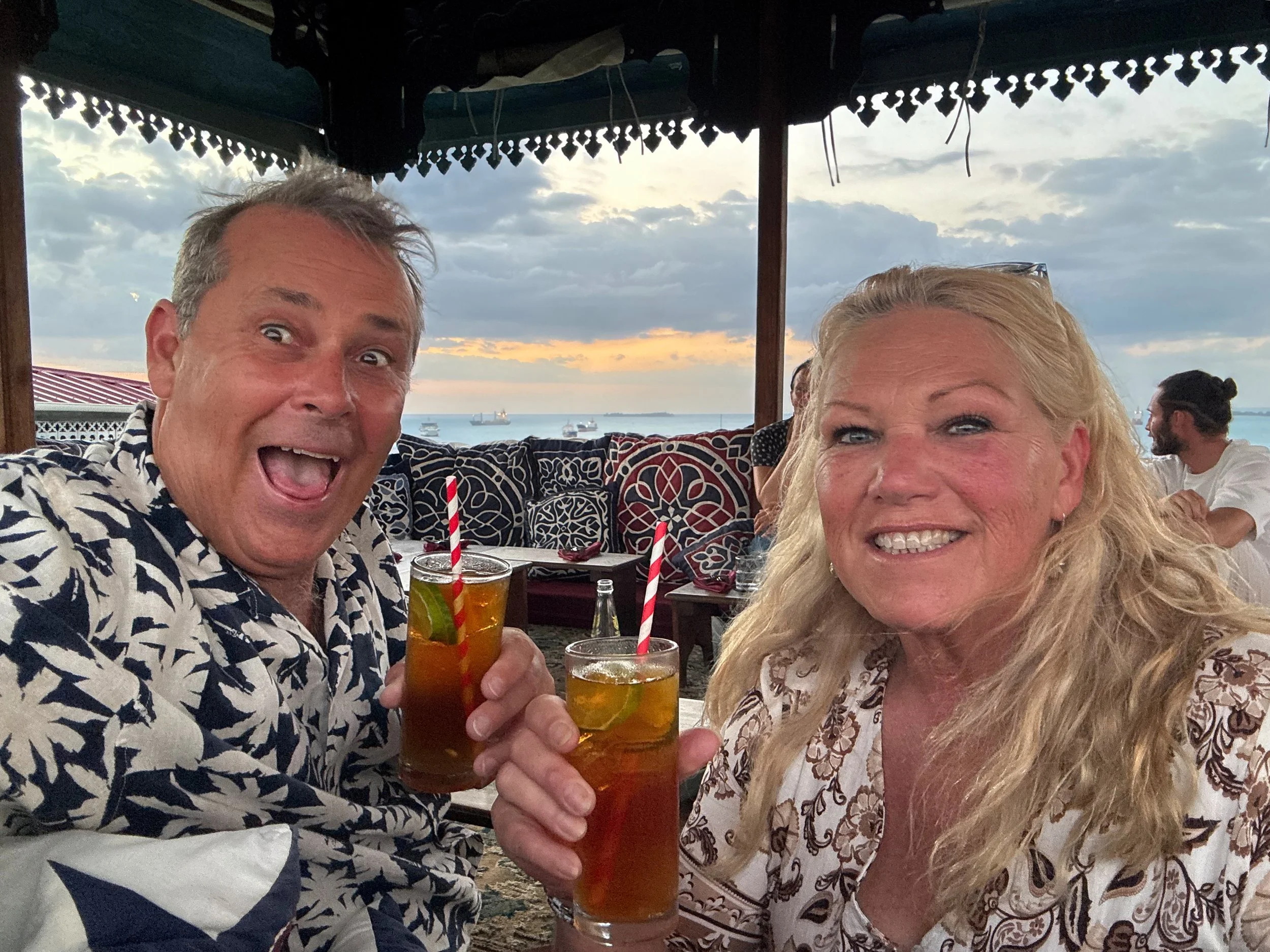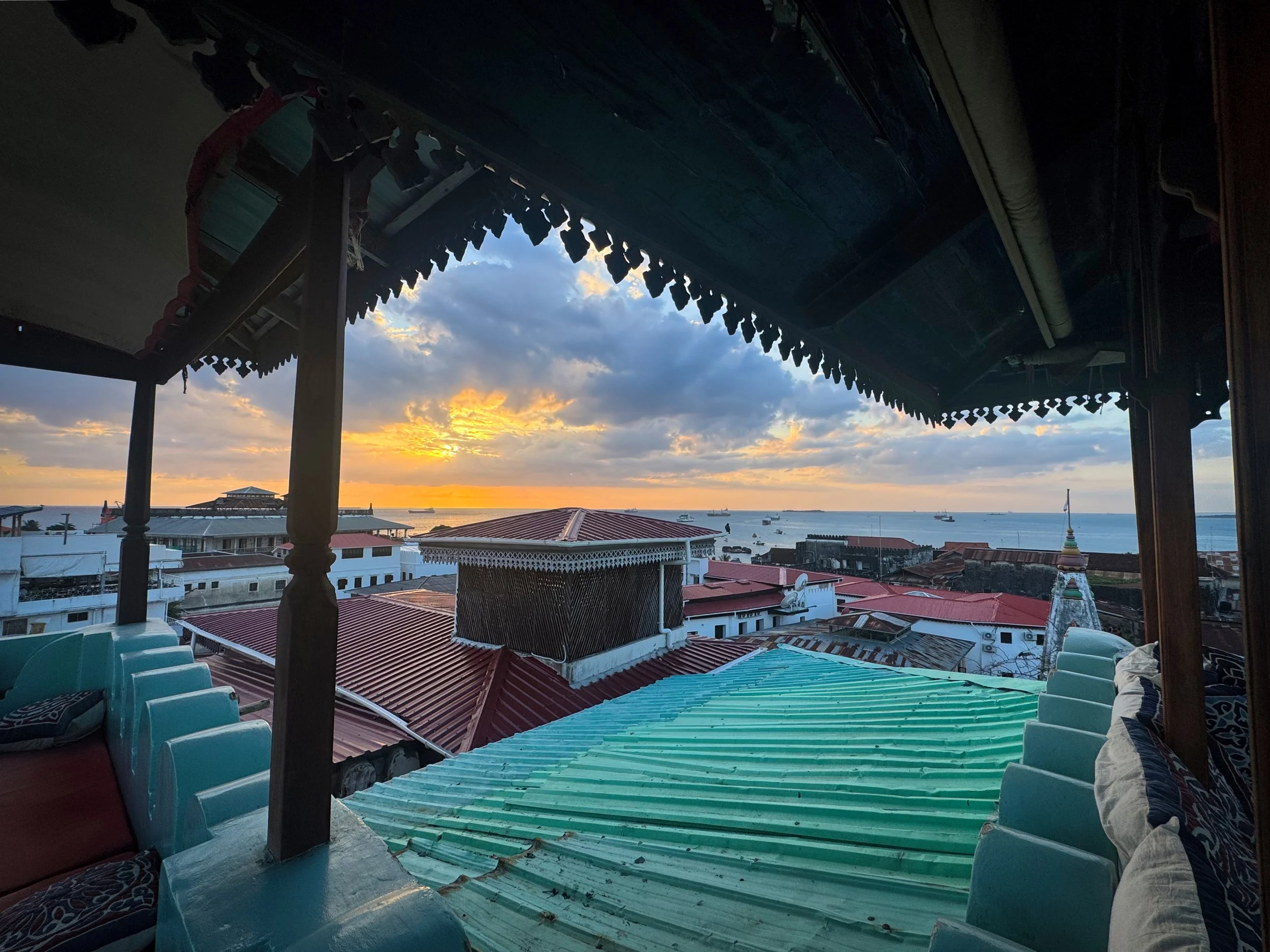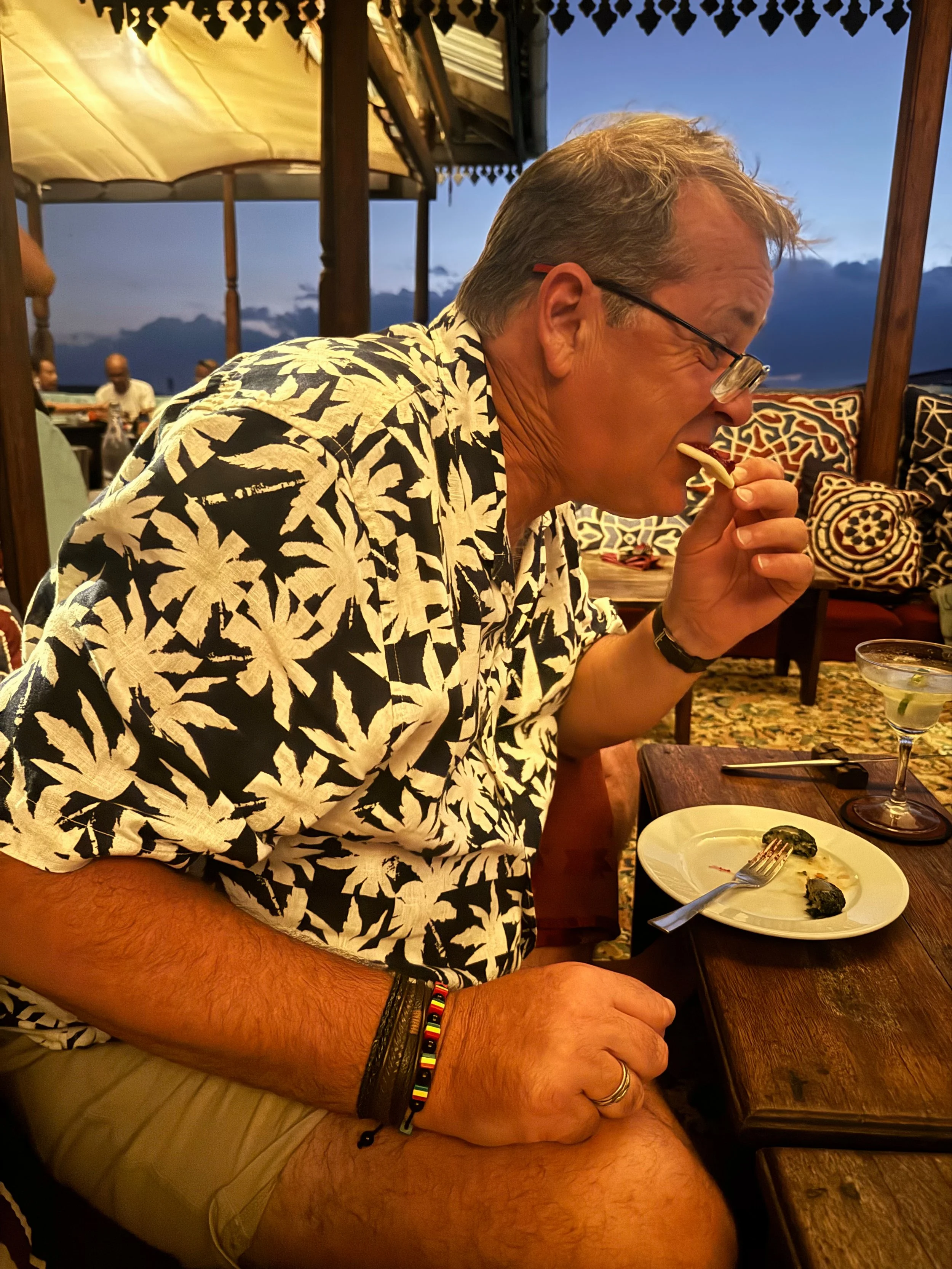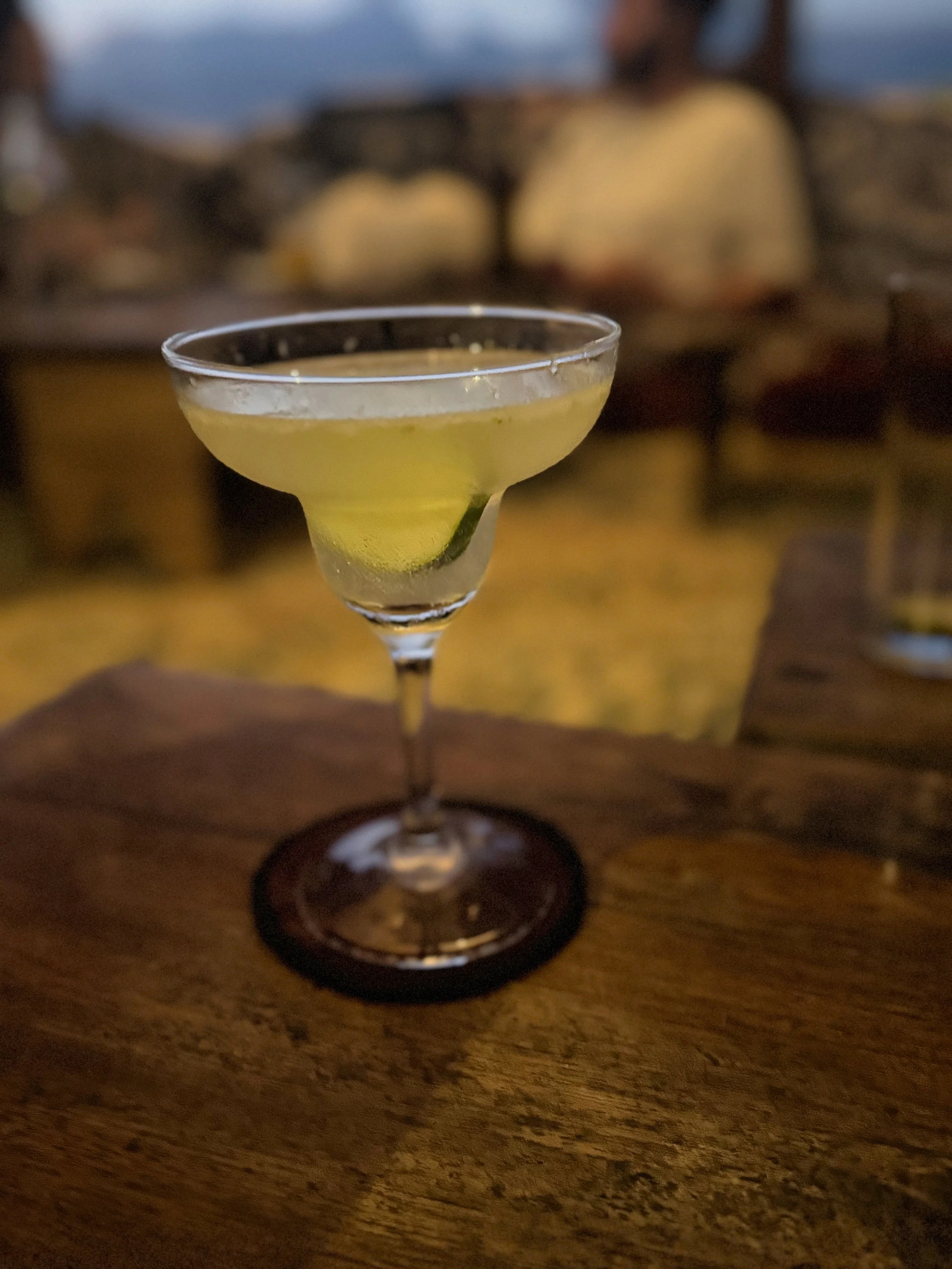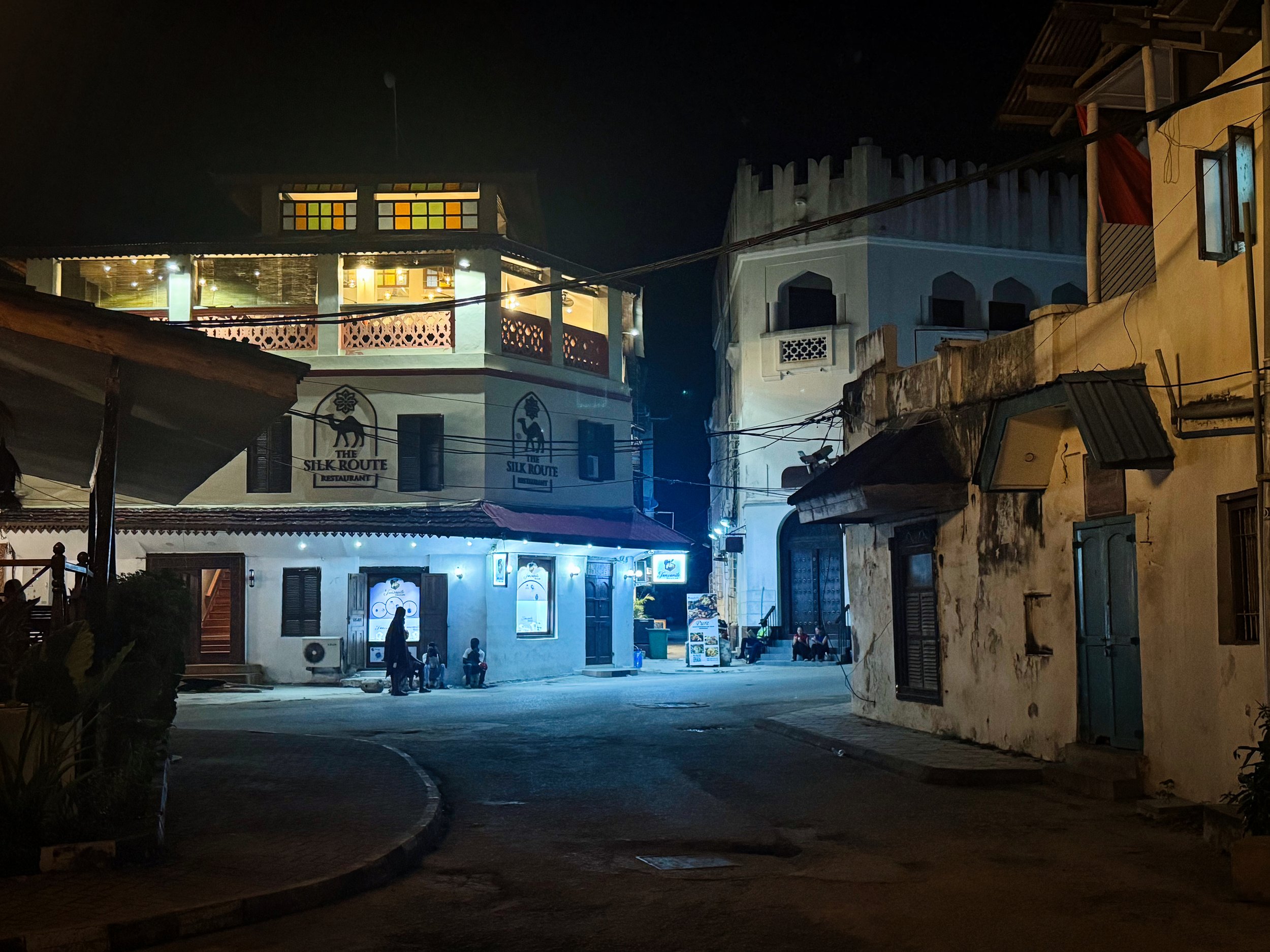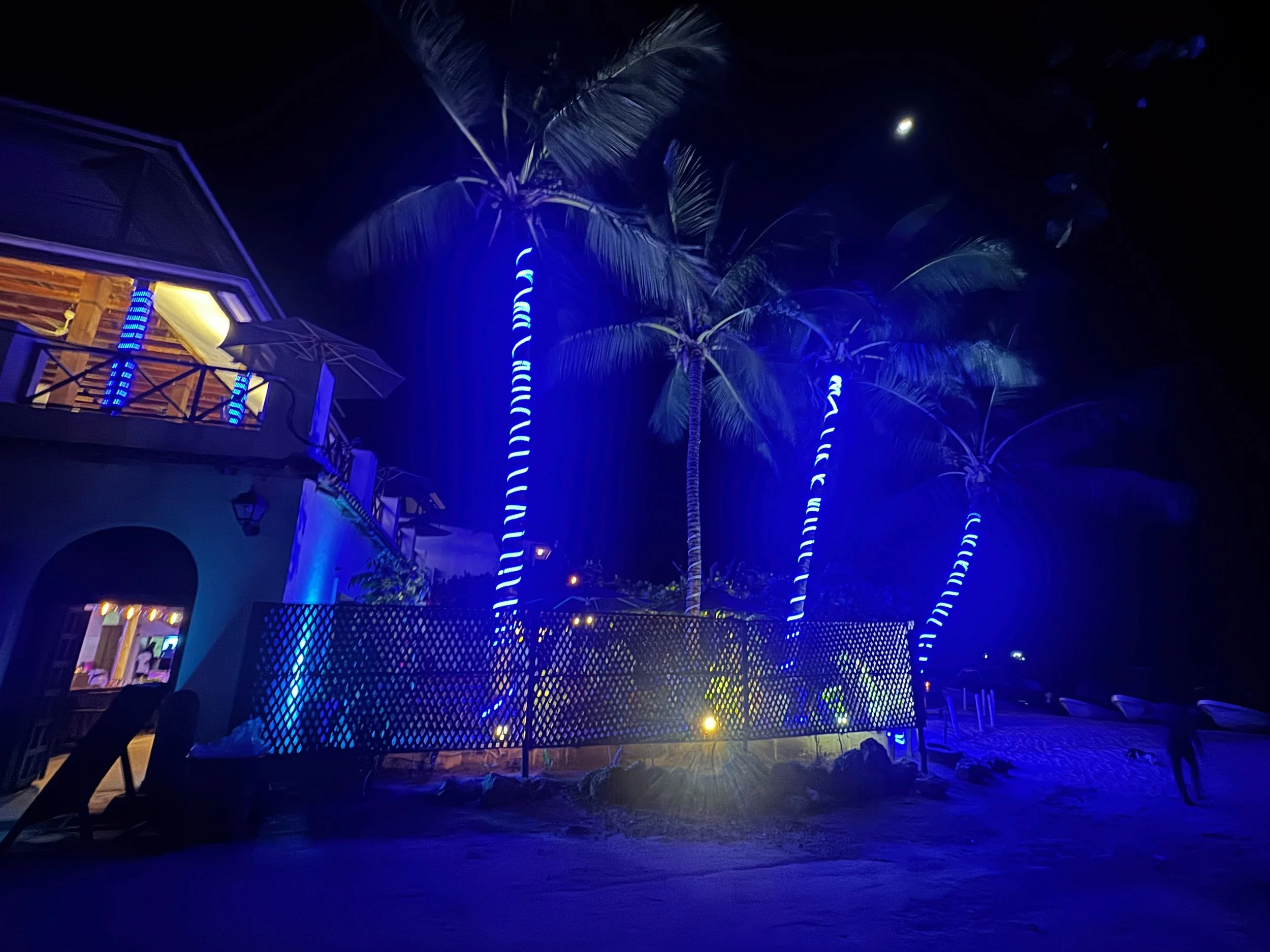Sunset XIX - Stone Town
Amidst dreams of Ali-Barber and his forty thieves and thinly veiled, almond eyed beauties belly dancing to the twang of a Buzuq, we woke to a reality befitting those dreams and opened the slatted window shutters to find a spectacular morning greeting us in Stone Town. Performing a Houdini-esque escape from the folds of mosquito net, we bathed in our elaborately tiled Arabian shower then headed down to breakfast. Is there anything better than outlining your breakfast preferences to a personal chef before sitting down beachside to enjoy said breakfast on a mosaic floor flanked by Moorish arches? Nope. Stone Town is unreal !
Just another breakfast view in Stone Town
As arranged last night we met our boat captain, Mr Bean, down on the beach and after organising entry tickets and paying the required taxes, we boarded his vessel for the short trip out to Changuu Island. Often referred to as Prison Island, this small slice of land sits almost 6km off the north-west coast of Stone Town and was visible from our balcony. Only 800m long and 230m wide, it was once used as a prison for enslaved people as well as functioning as a coral rag mine for use in construction and the production of cement.
The British First Minister of Zanzibar, Lloyd Mathews, purchased the island in 1893 and constructed the prison complex but no inmates were ever housed on the island so instead it became a quarantine station for yellow fever cases. And if you’re ever going to get yellow fever then this would be the place to be quarantined. The passage over was choppier than expected but nearing shore it calmed as soon as we crossed the threshold of vibrant turquoise water and Mr Bean beached the vessel on the fine white sand haloing the island. It was as far removed from the Serengeti Plains as could be and exactly the reason we included Zanzibar into our African itinerary.
Changuu is the Swahili name for a fish commonly found in the waters off the island which remained uninhabited until the 1860’s when the first Sultan of Zanzibar gave it to two Arabs to use as a prison for rebellious slaves prior to shipping them abroad or selling at the slave market in Stone Town. When Zanzibar became a British protectorate following a treaty with Germany in 1890, it was duly purchased from the Arabs with the prison built soon after leading it to be known as Prison Island.
The islands major attraction though is a Giant Tortoise sanctuary developed from virtually nothing, but with the species considered vulnerable and placed on the IUCN Red List, it’s now overseen by the World Animal Protection organisation. This part of the tour was really cool and unique in the sense that visitors, while following a boardwalk, can walk among the animals getting extremely close as they too are free to roam wherever they please. With an average weight of 250kg they’re not the most nibble of creatures but insanely beautiful despite their prehistoric features. Feeding on recently scattered cabbage leafs, dozens of the leisurely buggers worked their mouths quicker than their feet.
In 1919 the British governor of the Seychelles sent a gift of four Aldabra giant tortoises to Changuu. They bred quickly and by 1955 numbered over 200 animals. However, people began to steal the tortoises for sale abroad as either pets or food, and their numbers dropped rapidly. By 1988 there were around 100 tortoises, 50 in 1990 and just 7 by 1996. Since then, under the governance of World Animal Protection, the tortoise population has swelled to well over 200 with a dedicated hatchling program securely in place to increase these numbers even further. The oldest in the group is reportedly 200 years old, and despite the difficulty in verifying that fact, it is such a romantic and redeeming story we choose to believe it regardless.
British authorities were concerned with disease epidemics affecting Stone Town, which at the time was East Africa's main port, and turned Changuu into a quarantine island serving all of the British territories. The old prison was converted into the facility's hospital and in 1923 the island was officially renamed Quarantine Island. Quarantine cases would be taken from the ships and monitored for one or two weeks before being allowed to progress with their journey. Ships typically only arrived in East Africa from December to March so the island was usually empty for a large part of the year. During these periods it became a popular leisure resort for Europeans and local Zanzibar residents using many of the buildings already on site, even converting the old coral mining pits into swimming pools.
Co-existing with the islands tortoises are a colony of peacocks contrasting the gentle giants in every way. They are of course colourful and noisy, but deliciously flamboyant and found anywhere around the island. Other birdlife exists, as well as Suni, a type of antelope and one of the smallest ungulates on earth mainly inhabiting the islands dense underbrush.
Changuu was a virtual island paradise with the unique blend of colonial buildings flashed with Swahili design influences adding vibrant, earthy tones to the otherwise typical seaside palette. To visit this place was not only a must but a fantastic way to spend the morning before getting caught up in the street maze that is Stone Town. We returned to Zanzibar again across the small straight, dodging the large and frequent passengers ferries making the 40min trip from Dar es Salaam, to see our hotel for the first time from the water. The Arabian–Swahili architectural elegance of this founding building was on full display from this vantage point further justifying our decision to stay there.
Traditional East African Dhow
Back on hotel grounds we took some time out to swim in the pool, lay by the beach, swim in the ocean and enjoy an in house buffet lunch as part of our board. We chased the sun and avoided it at times as it swung around the hotel bringing the beach more to life with each passing hour. We’d booked a dinner later in the evening but also had much more of the town still to see. Deciding to combine the two, we engaged a local guide - again Fatpap only had to mention that to the concierge and there was one on our doorstep in a flash - for a walking tour of Stone Town.
As the “old town” of Zanzibar City, Stone Town is steeped with historical significance and was once the flourishing centre of the spice and Indian Ocean slave trade in the 19th century. Of prominent historical importance in East Africa, its architecture, mostly dating to the 19th century, reflects the diverse influences underlying the Swahili culture with a unique mixture of Arab, Persian, Indian and European elements. For this reason the town was designated as a UNESCO World Heritage Site in 2000.
Some literary evidence can trace the island back to Ancient Greece however the first Europeans to set foot on the island were the Portuguese. Following Vasco da Gama's visit in 1498, they ruled for over two centuries and began constructing the first stone structure, the Old Fort. Towards the end of the 17th century the Sultanate of Oman took over the island and completed the fort to prevent future attacks. The first stone houses are believed to be built in the early 1800’s gradually replacing an earlier fishing village around the Old Fort.
The Sultan Said bin Sultan moved his seat from Muscat in 1824 to Stone Town which instigated an era of quick development as the new capital of the Sultanate of Oman and Zanzibar. However, when the British outlawed the slave trade in the Indian Ocean, the Sultanate's fortunes crashed, the Muscat economy was in shambles and many Omanis migrated to Zanzibar. The increase in the Arab population on the island facilitated further growth and more buildings began to spring up including grand royal structures like the House of Wonders and the Sultan's Palace. As a consequence of a war of succession within the Omani royal family in 1861, Zanzibar and Oman were separated with Zanzibar becoming an independent sultanate under Sultan Majid bin Said.
Leaving the hotel courtyard we were astray within three turns. But thats what they say to do in Stone Town. The meandering, often bewildering journey is all part of its appeal. It was always part of our plan too but Lyndall understandably at times, being a woman, gorgeous, and blonde, following a certain incident in Jaipur India gets a little concerned with streetscapes like this. So the compromise struck was to hire a walking guide which proved to be a brilliant decision allowing us the sensation of feeling lost but never actually being so. Those familiar with the bio-pic Bohemian Rhapsody will have learnt Zanzibar was in fact the birth place of the legendary Freddie Mercury. With the Freddie Mercury Suite pre-booked during our stay (and believe us, we honestly did try to get that room) the next best option was the Freddie Mercury Museum. Well, at least a photograph out the front of it anyway…we’d already seen the movie after all. So we grabbed that cheesy pic for this very page and moved on through yet another alleyway.
The heart of Stone Town mostly consists of a maze of narrow alleys lined by houses, shops, bazaars and mosques and since most streets are too narrow for cars, they are crowded with bicycles, motorbikes and pedestrians. If seen from above we are certain it would resemble one of those rat mazes scientists used for testing in the 1950’s but from street level it was a cacophony of colour and sound and veritable architectural margarita given everything was so wonderfully blended.
The name Stone Town comes from the ubiquitous use of coral stone as the main construction material giving the town a characteristic, reddish warm colour. Traditional buildings have a baraza, a long stone bench flanking the outside walls used as an elevated sidewalk in heavy rains or otherwise a bench to sit, rest, or socialise on. Another key feature of most buildings are large verandas protected by carved wooden balustrades giving the city a whole Game of Thrones type of vibe.
The best known feature of Zanzibari houses though are the finely decorated wooden doors, with rich carvings and bas-reliefs, ornately decorated with large brass studs of Indian tradition. The two main influences are easily distinguishable: those of Indian style have rounded tops while those in the Omani Arab style are rectangular. Carvings are often Islamic in content consisting of verses from the Qur'an but other symbolism is occasionally used such as Indian lotus flowers as emblems of prosperity. Either way they were magnificent to see, absolutely massive at times and developed into a mini treasure hunt of sorts during our walk.
We zigzagged and meandered our way through the relatively small older quarter weaving in and out of shadows cast by the 4 story buildings surrounding us. While they looked the same they of course differed in many ways. A newly rendered and freshly painted wall on one side of the road was at contrasts to an older putrescent one revealing its coral stone interior like a decaying tooth on the other. Stone Town was magnificent and for Fatpap everything he loves about travelling. Store owners enticed you to view their wares and restauranteurs set up tables and chairs for the nightly trade. Kids played in the narrow cobbled streets and hundreds of others sat and watched as if unemployed. If Africa is relaxed and Tanzania chilled, then Zanzibar just ripped a doobie and Stone Town is rolling another.
Inspired, Fatpap shed his 10 month homage to 70’s glam rock and found a barber to trim away half of 2024 and the start of 25 to at least look his age even if he wouldn’t act it anymore.
Being herded into a few tourist traps that Fatpap quashed pretty quickly in his ever diplomatic fashion, we came upon the Old Fort featuring prominently among the low Stone Town skyline. As the oldest building and a major visitor attraction, the Old Fort is located on the main seafront adjacent to the former palace of the Sultan of Zanzibar and facing the Forodhani Gardens. Used as a garrison and prison in the 19th century, then a terminal of Zanzibar Railways between 1905-28, a new amphitheatre was added in the 1990’s helping it become the new headquarters of the Zanzibar international film festival.
The fort is essentially a square of high, brown stone walls with merlons protecting an inner courtyard. There are some remnants of earlier buildings, including those of a Portuguese church and another Omani fortification still found in the courtyard but on most days it is now home to rows of vendors selling their African artefacts. From there we moved literally across the road to the waterfront precinct and the famed spectacle come afternoon of local children diving from the ramparts into the water. As the main hub of town the plaza filled pretty quickly with bystanders but unfortunately for us, the divers today were dressed in fancy outfits filming a video for their highly subscribed youTube channel. So much for tradition when there’s good old fashioned street grifting we suppose. We did catch them doing what they’re known for, but it just didn’t feel the same.
Stone Town, Zanzibar
Fatpap’s parents visited Zanzibar 35 year prior and he distinctly recalls his now departed father talking about a rooftop restaurant over and over. So on a summers night in Bowral when planning this trip, fuelled most likely by too many rums, a rooftop restaurant in Stone Town was booked as a small way of paying homage. Lyndall nodded and smiled politely, because that’s just how it works between us at times. Weeks later Mother Fatpap was asked if she could recall the name of the restaurant and blurted “Emersons” without hesitation. We had inadvertently booked Emersons too which would serendipitously complete a loop no-one thought needed closing.
Farewelling our guide, we climbed the torturous 4 stories of stairs to emerge at Emersons rooftop which was nothing short of an Arabian pavilion with flowing silk ceilings, scatter pillows adorned with various arabesque designs and a live band strumming tunes alluring enough to coax a cobra from the depths of its basket. We flicked off the shoes, as is mandatory, folded our 3 week old African frames into yogi like positions and sat on the floor expecting figs to be served by a Capuchin monkey straight off the set of Casino Royale. The monkey didn’t eventuate but a team of immaculately dressed, and ever so polite wait staff did, bringing with them drinks and refresher towels.
The vista was poetry. Outward from the genie bottle we found ourselves in, wooden balustrade bridged finely carved columns to frame a sky of fading blue and greying clouds, The golden orange African sun we have come to expect sank behind a dhow weaving through the steel hulled ships anchored in the harbour ready for trade, and in the foreground the amazing contrast between newly replaced red roofed buildings and those rusted from years of weathering tied everything together exactly as it deserved. A cocktail of unrecalled ordering materialised before our eyes and we chortled like giddy school children realising we were part of the very picture before us. Fatpap offered a silent toast to his much missed father thanking him for the travel tip. Like much in his life, it took a while to understand the meaning of the advice, but tonight it registered. Thank you Grumps.
The meal was preset and non negotiable but didn’t faze us in the least. A tasting plate of African dishes, specifically Zanzibar delicacies were slowly grazed through with accompanying cocktails, wines, and at one point an Irish whiskey. The band played throughout the night as a soulful mamma drifted among the guests wailing to the African beats.
With only a semblance of directional recognition, we walked back to the hotel via the waterfront which by now had sprung to life with street vendors offering any manner of Zanzibar dishes as dinner. Sadly we were full, bloated perhaps might be a better word, so we planted ourselves at Livingstone’s for a few last cleansers to end an absolutely mammoth day in Stone Town, Zanzibar.

